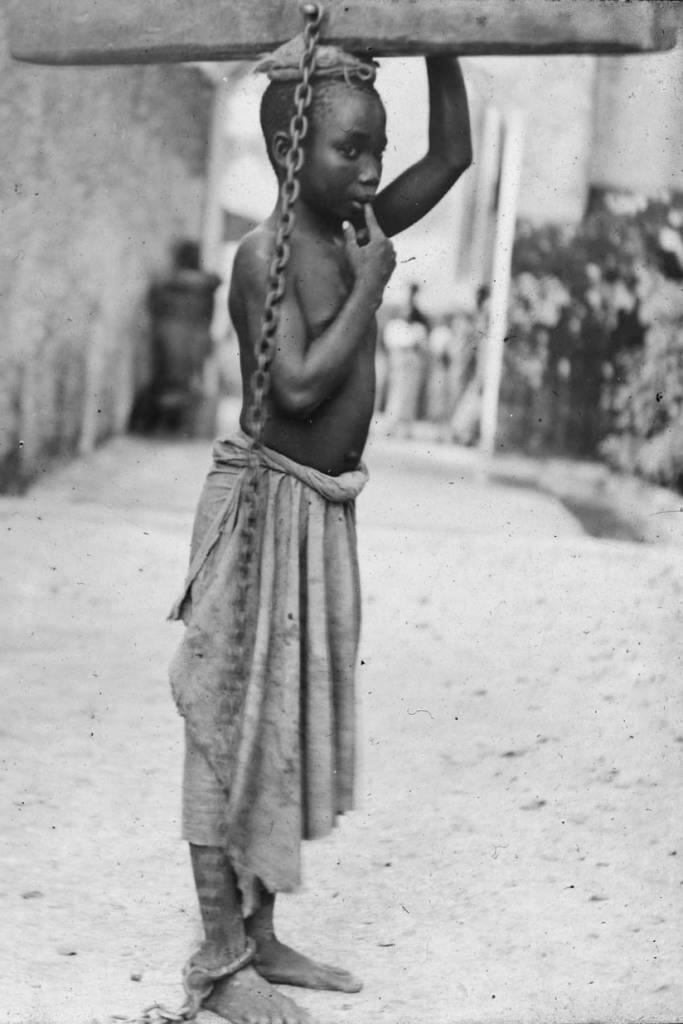
奴隷制
Slavery

Photograph of a slave boy in the Sultanate of Zanzibar. 'An Arab master's punishment for a slight offence.' c. 1890.
☆ 奴隷制(Slavery)とは、特に労働に関して、人を所有物として所有することである。奴隷制は通常、強制労働を伴い、奴隷の労働場所や居住地は、奴隷として拘束する側によって決定される。奴隷化とは、人を奴隷にすることであり、その人は奴隷または被奴隷者と呼ばれる。
★︎1833年の奴隷廃止法▶資本主義と奴隷制︎▶︎︎エマーソンと奴隷制▶︎フレデリック・ダグラス▶︎︎アメリカ合衆国の奴隷制小史▶コード・ノワール︎▶アフリカ争奪戦︎︎▶︎民族医療の領有について[pdf]▶アフリカ人埋葬地国立モニュメント︎︎▶︎▶︎
| Slavery
is the ownership of a person as property, especially in regards to
their labour.[1] Slavery typically involves compulsory work with the
slave's location of work and residence dictated by the party that holds
them in bondage. Enslavement is the placement of a person into slavery,
and the person is called a slave or an enslaved person (see §
Terminology). Many historical cases of enslavement occurred as a result of breaking the law, becoming indebted, suffering a military defeat, or exploitation for cheaper labor; other forms of slavery were instituted along demographic lines such as race or sex. Slaves may be kept in bondage for life, or for a fixed period of time after which they would be granted freedom.[2] Although slavery is usually involuntary and involves coercion, there are also cases where people voluntarily enter into slavery to pay a debt or earn money due to poverty. In the course of human history, slavery was a typical feature of civilization,[3] and was legal in most societies, but it is now outlawed in most countries of the world, except as a punishment for a crime.[4][5] In chattel slavery, the slave is legally rendered the personal property (chattel) of the slave owner. In economics, the term de facto slavery describes the conditions of unfree labour and forced labour that most slaves endure.[6] The Islamic Republic of Mauritania was the last country in the world to officially ban slavery, in 1981,[7] with legal prosecution of slaveholders established in 2007.[8] However, in 2019, approximately 40 million people, of whom 26% were children, were still enslaved throughout the world despite slavery being illegal. In the modern world, more than 50% of slaves provide forced labour, usually in the factories and sweatshops of the private sector of a country's economy.[9] In industrialised countries, human trafficking is a modern variety of slavery; in non-industrialised countries, debt bondage is a common form of enslavement,[6] such as captive domestic servants, people in forced marriages, and child soldiers.[10] Sexual slavery claiming the sanction of Islam has also become widespread due to the rise of jihadism.[11][12] 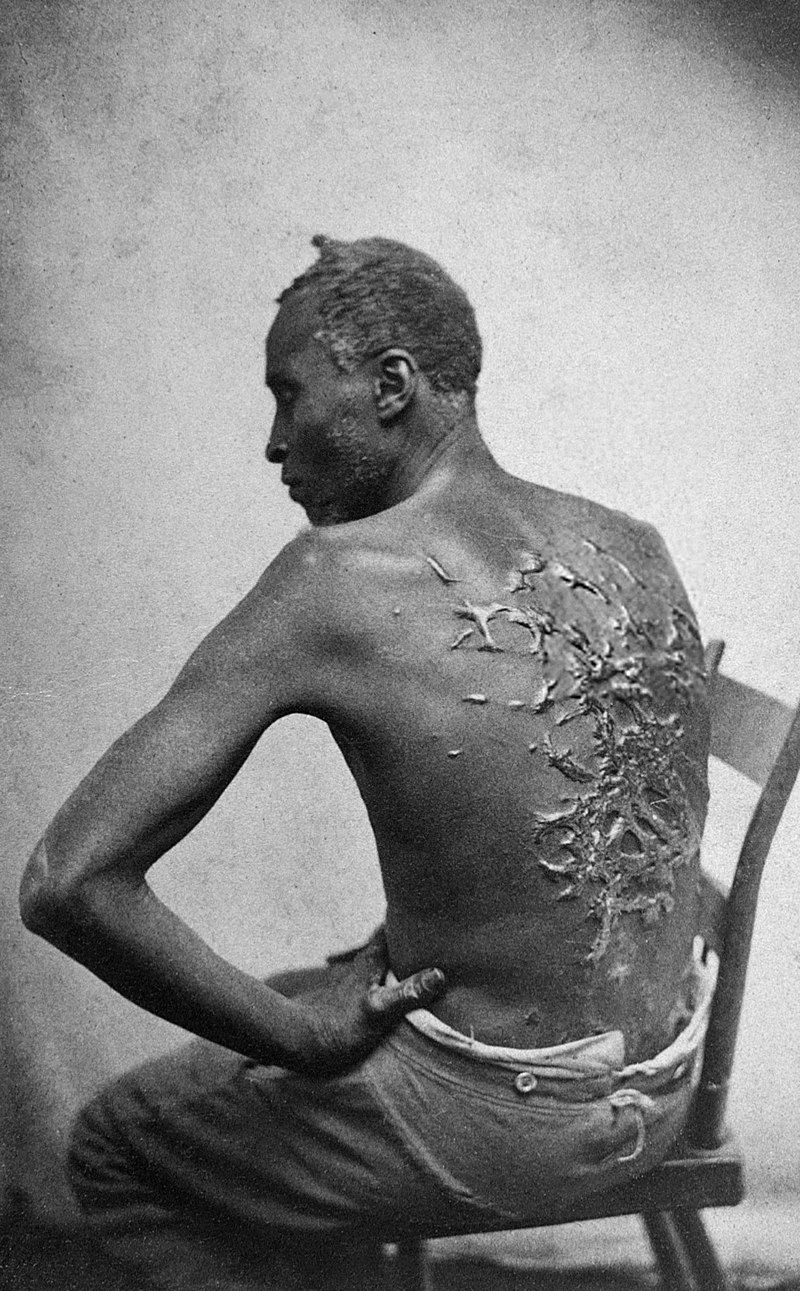 Gordon, a slave from Louisiana, in 1863. The scars are the result of a whipping by his overseer. |
奴隷制(Slavery)とは、特に労働に関して、人を所有物として所有することである[1]。奴隷制は通常、強制労働を伴い、奴隷の労働場所や居住地は、奴隷として拘束する側によって決定される。奴隷化とは、人を奴隷にすることであり、その人は奴隷または被奴隷者と呼ばれる(§用語参照)。 歴史的な奴隷化の事例の多くは、法を破った結果、負債を負った結果、軍事的敗北を被った結果、または安価な労働力として搾取された結果として起こったもの である。奴隷は終身拘束されることもあれば、一定期間拘束された後に自由が与えられることもある[2]。通常、奴隷制は強制を伴う非自発的なものである が、借金の支払いや貧困による収入を得るために自発的に奴隷制に入る場合もある。人類の歴史上、奴隷制度は文明の典型的な特徴であり[3]、ほとんどの社 会で合法であったが、現在では犯罪に対する刑罰として以外は世界のほとんどの国で非合法となっている[4][5]。 動産奴隷制では、奴隷は法的に奴隷所有者の動産(chattel)とされる。経済学では、事実上の奴隷制という用語は、ほとんどの奴隷が耐えている不自由な労働や強制労働の状況を表している[6]。 モーリタニア・イスラム共和国は、1981年に奴隷制を公式に禁止した世界で最後の国であり[7]、2007年には奴隷所有者の法的訴追が確立された [8]。 しかし、2019年には、奴隷制が違法であるにもかかわらず、世界中で約4000万人(うち26%は子ども)が依然として奴隷となっていた。現代世界で は、奴隷の50%以上が強制労働を提供しており、通常はその国の民間部門の工場や搾取工場で働いている。 [先進工業国では、人身売買は現代的な奴隷制の一形態であり、非工業国では、家事使用人、強制結婚、子ども兵士など、債務拘束は一般的な奴隷制の一形態で ある[6]。 イスラム教の制裁を主張する性的奴隷制も、ジハード主義の台頭により広まっている[11][12]。  1863年、ルイジアナ州出身の奴隷ゴードン。この傷跡は、監督官による鞭打ちの跡である。 |
| Etymology The word slave was borrowed into Middle English through the Old French esclave which ultimately derives from Byzantine Greek σκλάβος (sklábos) or εσκλαβήνος (ésklabḗnos). According to the widespread view, which has been known since the 18th century, the Byzantine Σκλάβινοι (Sklábinoi), Έσκλαβηνοί (Ésklabēnoí), borrowed from a Slavic tribe self-name *Slověne, turned into σκλάβος, εσκλαβήνος (Late Latin sclāvus) in the meaning 'prisoner of war slave', 'slave' in the 8th/9th century, because they often became captured and enslaved.[13][14][15][16] However this version has been disputed since the 19th century.[17][18] An alternative contemporary hypothesis states that Medieval Latin sclāvus via *scylāvus derives from Byzantine σκυλάω (skūláō, skyláō) or σκυλεύω (skūleúō, skyleúō) with the meaning "to strip the enemy (killed in a battle)" or "to make booty / extract spoils of war".[19][20][21][22] This version has been criticized as well.[23] Terminology There is a dispute among historians about whether terms such as "unfree labourer" or "enslaved person", rather than "slave", should be used when describing the victims of slavery. According to those proposing a change in terminology, slave perpetuates the crime of slavery in language by reducing its victims to a nonhuman noun instead of "carry[ing] them forward as people, not the property that they were" (see also People-first language). Other historians prefer slave because the term is familiar and shorter, or because it accurately reflects the inhumanity of slavery, with person implying a degree of autonomy that slavery does not allow.[24] Chattel slavery 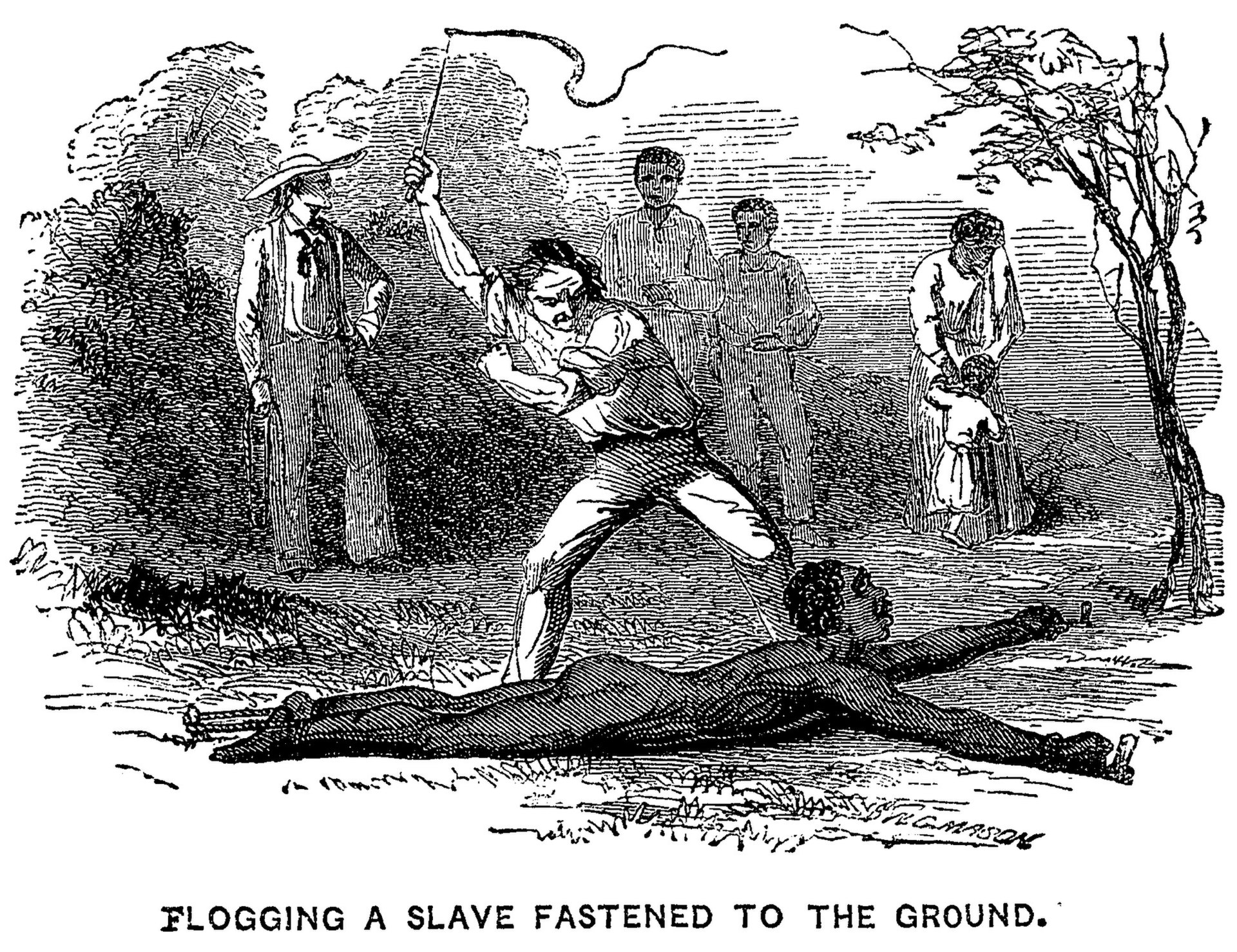 Flogging a slave fastened to the ground, illustration in an 1853 anti-slavery pamphlet 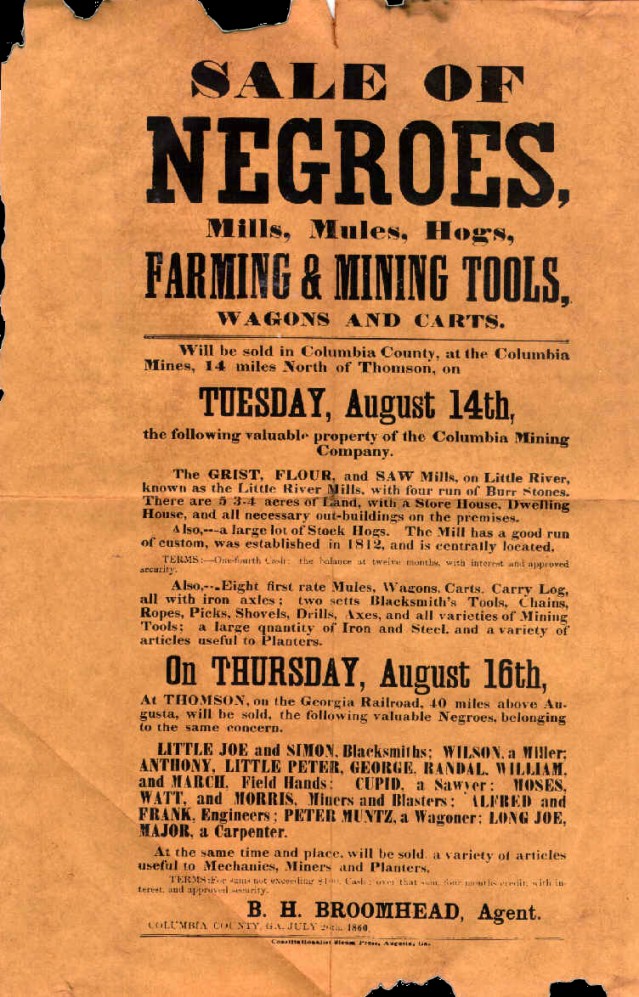 A poster for a slave auction in Georgia, U.S., 1860 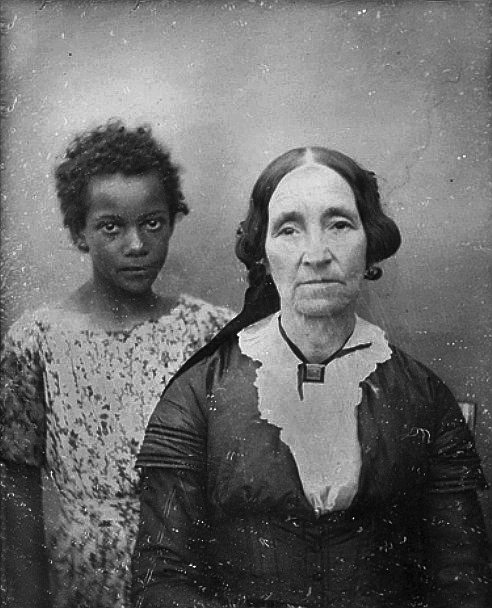 Portrait of an older woman in New Orleans with her enslaved servant girl in the mid-19th century As a social institution, chattel slavery classes slaves as chattels (personal property) owned by the enslaver; like livestock, they can be bought and sold at will.[25] Chattel slavery was practiced in places such as the Roman Empire and classical Greece, where it was considered a keystone of society.[26][27][28] Other places where it was extensively practiced include Medieval Egypt,[29] Subsaharan Africa,[30] Brazil, the United States and parts of the Caribbean such as Cuba and Haiti.[31][32] Beginning in the 18th century, a series of abolitionist movements saw slavery as a violation of the slaves' rights as people ("all men are created equal"), and sought to abolish it. Abolitionism encountered extreme resistance but was eventually successful. In the United States it was abolished in 1865 and in Cuba in 1886. The last country in the Americas to abolish slavery was Brazil, in 1888.[33] The last country to abolish slavery, Mauritania, did so in 1981. The 1981 ban on slavery was not effectively enforced in practice, as there were no legal mechanisms to prosecute those who used slaves. This only came in 2007. Bonded labour Main article: Debt bondage See also: Money marriage and Chukri system Indenture, also known as bonded labour or debt bondage, is a form of unfree labour in which a person works to pay off a debt by pledging himself or herself as collateral. The services required to repay the debt, and their duration, may be undefined. Debt bondage can be passed on from generation to generation, with children required to pay off their progenitors' debt.[34] It is the most widespread form of slavery today.[35] Debt bondage is most prevalent in South Asia.[34] Money marriage refers to a marriage where a girl, usually, is married off to a man to settle debts owed by her parents.[36] The Chukri system is a debt bondage system found in parts of Bengal where a female can be coerced into prostitution in order to pay off debts.[37] Dependents The word slavery has also been used to refer to a legal state of dependency to somebody else.[38][39] For example, in Persia, the situations and lives of such slaves could be better than those of common citizens.[40] 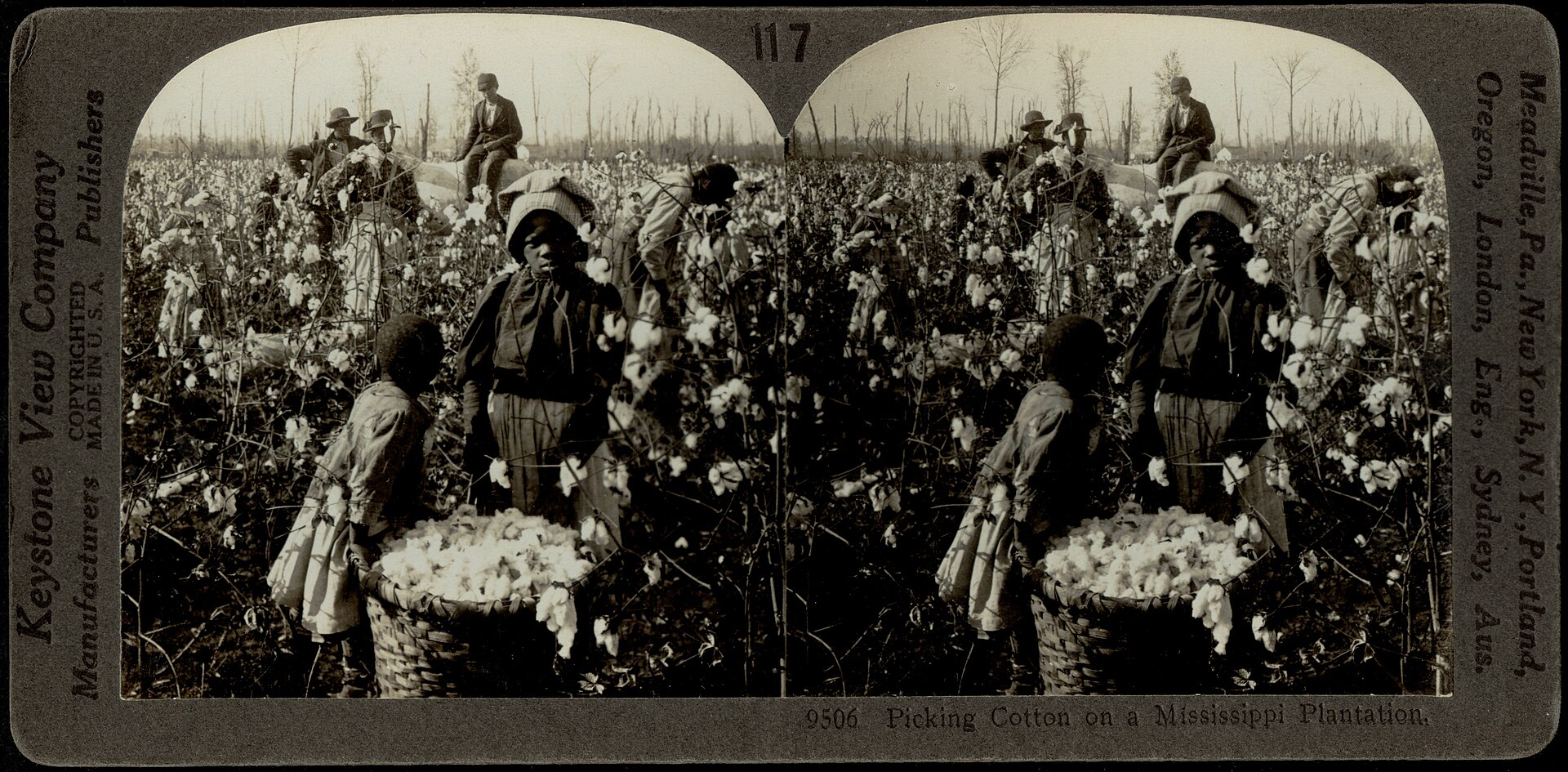 A black family works a cotton plantation. A young boy stands in front of the camera. The photo is in black and white. A Black family works a cotton plantation in Mississippi. The subtitle says "We done dis' all mornin'". Forced labour Main article: Unfree labour See also: Human trafficking Forced labour, or unfree labour, is sometimes used to describe an individual who is forced to work against their own will, under threat of violence or other punishment. This may also include institutions not commonly classified as slavery, such as serfdom, conscription and penal labour. As slavery has been legally outlawed in all countries, forced labour in the present day (frequently referred to as "modern slavery") revolves around illegal control. Human trafficking primarily involves women and children forced into prostitution and is the fastest growing form of forced labour, with Thailand, Cambodia, India, Brazil and Mexico having been identified as leading hotspots of commercial sexual exploitation of children.[41][42] Child soldiers and child labour Main article: Child slavery See also: Child labour and Military use of children In 2007, Human Rights Watch estimated that 200,000 to 300,000 children served as soldiers in then-current conflicts.[43] More girls under 16 work as domestic workers than any other category of child labour, often sent to cities by parents living in rural poverty as with the Haitian restaveks.[44] Forced marriage See also: Marriage by abduction and Child marriage Forced marriages or early marriages are often considered types of slavery. Forced marriage continues to be practiced in parts of the world including some parts of Asia and Africa and in immigrant communities in the West.[45][46][47][48] Marriage by abduction occurs in many places in the world today, with a 2003 study finding a national average of 69% of marriages in Ethiopia being through abduction.[49] Other uses of the term The word slavery is often used as a pejorative to describe any activity in which one is coerced into performing. Some argue that military drafts and other forms of coerced government labour constitute "state-operated slavery."[50][51] Some libertarians and anarcho-capitalists view government taxation as a form of slavery.[52] "Slavery" has been used by some anti-psychiatry proponents to define involuntary psychiatric patients, claiming there are no unbiased physical tests for mental illness and yet the psychiatric patient must follow the orders of the psychiatrist. They assert that instead of chains to control the slave, the psychiatrist uses drugs to control the mind.[53] Drapetomania was a pseudoscientific psychiatric diagnosis for a slave who desired freedom; "symptoms" included laziness and the tendency to flee captivity.[54][55] Some proponents of animal rights have applied the term slavery to the condition of some or all human-owned animals, arguing that their status is comparable to that of human slaves.[56] The labour market, as institutionalized under contemporary capitalist systems, has been criticized by mainstream socialists and by anarcho-syndicalists, who utilise the term wage slavery as a pejorative or dysphemism for wage labour.[57][58][59] Socialists draw parallels between the trade of labour as a commodity and slavery. Cicero is also known to have suggested such parallels.[60] |
語源 奴隷(slave)という単語は、古フランス語のesclaveを通じて中世英語に借用され、最終的にはビザンチン・ギリシャ語のσκλάβος(sklábos)またはεσκλαβήνος(ésklabl_117nos)に由来する。 18世紀以降に広く知られるようになった見解によると、ビザンチン語の Σκλάβινοι (Sklábinoi), Έσκλαβηνοί (Ésklabēnoí) は、スラブ民族の自称 *Slověne から借用したものである、 8~9世紀には「捕虜奴隷」「奴隷」の意味でσκλάβος, εσκλαβήνος(後期ラテン語 sclāvus)に転じた。 [13][14][15][16]しかし、この説には19世紀以来異論がある[17][18]。 中世ラテン語のsclāvusはビザンチン語のσκυλάω (skūláō、skyláō) またはσκυλεύω (skūleúō、skyleúō) に由来し、「(戦闘で殺された)敵を剥ぎ取る」または「戦利品を作る/戦利品を取り出す」という意味を持つという現代的な仮説もある[19][20] [21][22]。この説も批判されている[23]。 用語 歴史家の間では、奴隷制の犠牲者を表現する際に「奴隷」ではなく、「不自由な労働者」や「奴隷にされた人」といった用語を使用すべきかどうかについて論争 がある。用語の変更を提案する人々によれば、slaveは、「奴隷を所有物としてではなく、人間として前進させる」のではなく、犠牲者を人間ではない名詞 に還元することで、奴隷制の犯罪を言語として永続させるという(People-first languageも参照)。他の歴史家は、この用語が馴染みがあり短いため、あるいは奴隷制の非人間性を正確に反映しているため、奴隷を好む。 動産奴隷制  地面に固定された奴隷に鞭打つ、1853年の反奴隷制パンフレットの挿絵  1860年、アメリカ、ジョージア州の奴隷オークションのポスター。  19世紀半ば、ニューオーリンズで奴隷にされた使用人の少女を連れた年配の女性の肖像画 社会制度としての動産奴隷制は、奴隷を奴隷所有者が所有する動産(個人の所有物)として分類し、家畜のように自由に売買することができる。 [26][27][28]その他、中世エジプト、[29]サブサハラ・アフリカ、[30]ブラジル、アメリカ合衆国、キューバやハイチなどのカリブ海の一 部などで広く行われていた[31][32]。 18世紀に始まった一連の奴隷廃止運動は、奴隷制度を人間としての権利(「すべての人間は平等につくられている」)の侵害とみなし、奴隷制度の廃止を求め た。奴隷制度廃止運動は極度の抵抗に遭ったが、最終的には成功を収めた。アメリカでは1865年に、キューバでは1886年に廃止された。アメリカ大陸で 最後に奴隷制を廃止した国は、1888年のブラジルである[33]。最後に奴隷制を廃止した国はモーリタニアで、1981年に廃止された。1981年の奴 隷制禁止令は、奴隷を使用した者を訴追する法的メカニズムがなかったため、実際には効果的に施行されなかった。これが2007年になってようやく施行され た。 奴隷労働 主な記事 借金による拘束 以下も参照: 金銭結婚とチュクリ制度 年季奉公(年季奉公)とは、借金の返済のために、自分を担保にして働く不自由な労働のことである。借金を返済するために必要な役務やその期間は、不定であ ることがある。借金の束縛は世代から世代へと受け継がれることがあり、子供たちは祖先の借金を返済することを要求される[34]。 借金の束縛は南アジアで最も普及している[35]。 金銭結婚とは、通常、少女が親の借金を清算するために男性と結婚することを指す[36]。チュクリ制度はベンガルの一部で見られる借金の束縛制度であり、 借金を返済するために女性が売春を強要されることがある[37]。 扶養家族 奴隷制という言葉は、誰かに扶養されている法的な状態を指す場合にも使われてきた[38][39]。例えば、ペルシアでは、そのような奴隷の状況や生活は、一般市民よりも良いものであった可能性がある[40]。  綿花農園で働く黒人一家。カメラの前に立つ少年。写真は白黒。 ミシシッピの綿花農園で働く黒人家族。字幕には「We done dis' all mornin'」とある。 強制労働 主な記事 不自由な労働 こちらも参照: 人身売買 強制労働、または不自由な労働は、暴力やその他の処罰の脅しのもと、自分の意思に反して強制的に働かされる個人を表すのに使われることがある。これには、 農奴制、徴兵制、流刑労働など、一般的に奴隷制と分類されない制度も含まれる。奴隷制はすべての国で法的に違法化されているため、現在の強制労働(しばし ば「現代の奴隷制」と呼ばれる)は違法な支配を中心に展開されている。 人身売買は、主に売春を強制される女性や子どもが関与しており、強制労働の中で最も急速に増加している形態であり、タイ、カンボジア、インド、ブラジル、メキシコは、子どもの商業的性的搾取の主要なホットスポットとして特定されている[41][42]。 子ども兵士と児童労働 主な記事 児童奴隷 以下も参照: 児童労働と児童の軍事利用 2007年、ヒューマン・ライツ・ウォッチは、当時の紛争において20万人から30万人の子どもが兵士として働いていると推定している[43]。16歳未 満の少女が家事労働者として働く数は、他のどの児童労働よりも多く、ハイチのレスタベクのように、農村で貧困にあえぐ親によって都市に送られることが多い [44]。 強制結婚 以下も参照: 拉致による結婚と児童婚 強制結婚や早婚は、しばしば奴隷制度の一種とみなされる。強制結婚は、アジアやアフリカの一部、欧米の移民コミュニティなど、世界の一部で行われ続けてい る[45][46][47][48]。2003年の調査では、エチオピアでは全国平均で69%が拉致による結婚であった[49]。 その他の用法 奴隷制という言葉は、強制されるあらゆる活動を表す蔑称として使われることが多い。徴兵制やその他の形態の強制的な政府労働は「国家が運営する奴隷制」に 当たると主張する者もいる[50][51]。自由主義者や無政府資本主義者の中には、政府による課税を奴隷制の一形態とみなす者もいる[52]。 「奴隷制」は、一部の反精神医学支持者によって、非自発的な精神科患者を定義するために使われてきました。精神疾患には偏りのない身体検査が存在せず、精 神科患者は精神科医の命令に従わなければならないと主張しています。彼らは、奴隷を支配する鎖の代わりに、精神科医は精神を支配するために薬物を使用する と主張する[53]。ドラペトマニアは、自由を望む奴隷に対する偽科学的な精神医学的診断であり、「症状」には怠惰や監禁から逃れる傾向が含まれる [54][55]。 動物の権利の支持者の中には、人間が所有する動物の一部またはすべての状態に奴隷制という用語を適用し、その地位は人間の奴隷に匹敵すると主張する者もいる[56]。 現代の資本主義システムの下で制度化された労働市場は、主流派の社会主義者やアナーコ・サンディカリストによって批判されており、彼らは賃金労働に対する 蔑称または異体字として賃金奴隷制という用語を利用している[57][58][59]。キケロもそのような類似性を示唆したことで知られている[60]。 |
| Characteristics Economics Economists have modeled the circumstances under which slavery (and variants such as serfdom) appear and disappear. One observation is that slavery becomes more desirable for landowners where land is abundant, but labour is scarce, such that rent is depressed and paid workers can demand high wages. If the opposite holds true, then it is more costly for landowners to guard the slaves than to employ paid workers who can demand only low wages because of the degree of competition.[61] Thus, first slavery and then serfdom gradually decreased in Europe as the population grew. They were reintroduced in the Americas and in Russia as large areas of land with few inhabitants became available.[62] Slavery is more common when the tasks are relatively simple and thus easy to supervise, such as large-scale monocrops such as sugarcane and cotton, in which output depended on economies of scale. This enables systems of labour, such as the gang system in the United States, to become prominent on large plantations where field hands toiled with factory-like precision. Then, each work gang was based on an internal division of labour that assigned every member of the gang to a task and made each worker's performance dependent on the actions of the others. The slaves chopped out the weeds that surrounded the cotton plants as well as excess sprouts. Plow gangs followed behind, stirring the soil near the plants and tossing it back around the plants. Thus, the gang system worked like an assembly line.[63] Since the 18th century, critics have argued that slavery hinders technological advancement because the focus is on increasing the number of slaves doing simple tasks rather than upgrading their efficiency. For example, it is sometimes argued that, because of this narrow focus, technology in Greece – and later in Rome – was not applied to ease physical labour or improve manufacturing.[64][65] 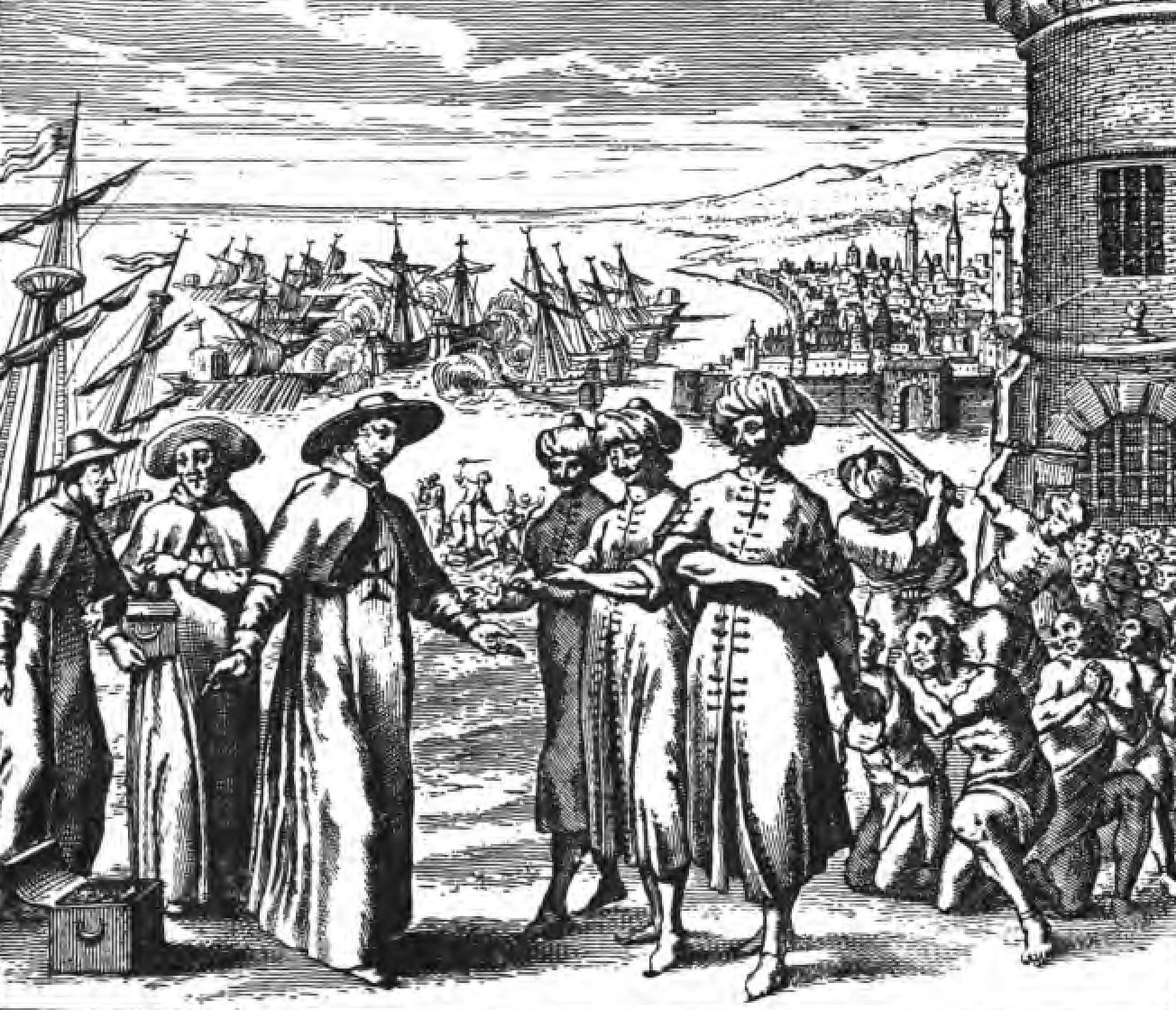 The work of the Mercedarians was in ransoming Christian slaves held in North Africa (1637). Scottish economist Adam Smith stated that free labour was economically better than slave labour, and that it was nearly impossible to end slavery in a free, democratic, or republican form of government since many of its legislators or political figures were slave owners and would not punish themselves. He further stated that slaves would be better able to gain their freedom under centralized government, or a central authority like a king or church.[66][67] Similar arguments appeared later in the works of Auguste Comte, especially given Smith's belief in the separation of powers, or what Comte called the "separation of the spiritual and the temporal" during the Middle Ages and the end of slavery, and Smith's criticism of masters, past and present. As Smith stated in the Lectures on Jurisprudence, "The great power of the clergy thus concurring with that of the king set the slaves at liberty. But it was absolutely necessary both that the authority of the king and of the clergy should be great. Where ever any one of these was wanting, slavery still continues..."[68] 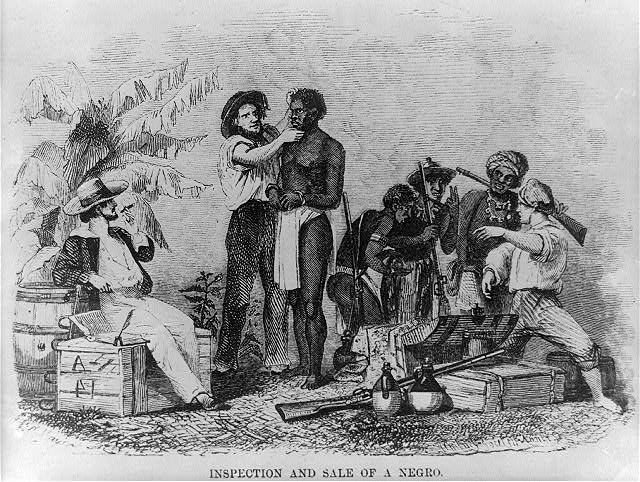 Sale and inspection of slaves Even after slavery became a criminal offense, slave owners could get high returns. According to researcher Siddharth Kara, the profits generated worldwide by all forms of slavery in 2007 were $91.2 billion. That was second only to drug trafficking, in terms of global criminal enterprises. At the time the weighted average global sales price of a slave was estimated to be approximately $340, with a high of $1,895 for the average trafficked sex slave, and a low of $40 to $50 for debt bondage slaves in part of Asia and Africa. The weighted average annual profits generated by a slave in 2007 was $3,175, with a low of an average $950 for bonded labour and $29,210 for a trafficked sex slave. Approximately 40% of slave profits each year were generated by trafficked sex slaves, representing slightly more than 4% of the world's 29 million slaves.[69] Identification 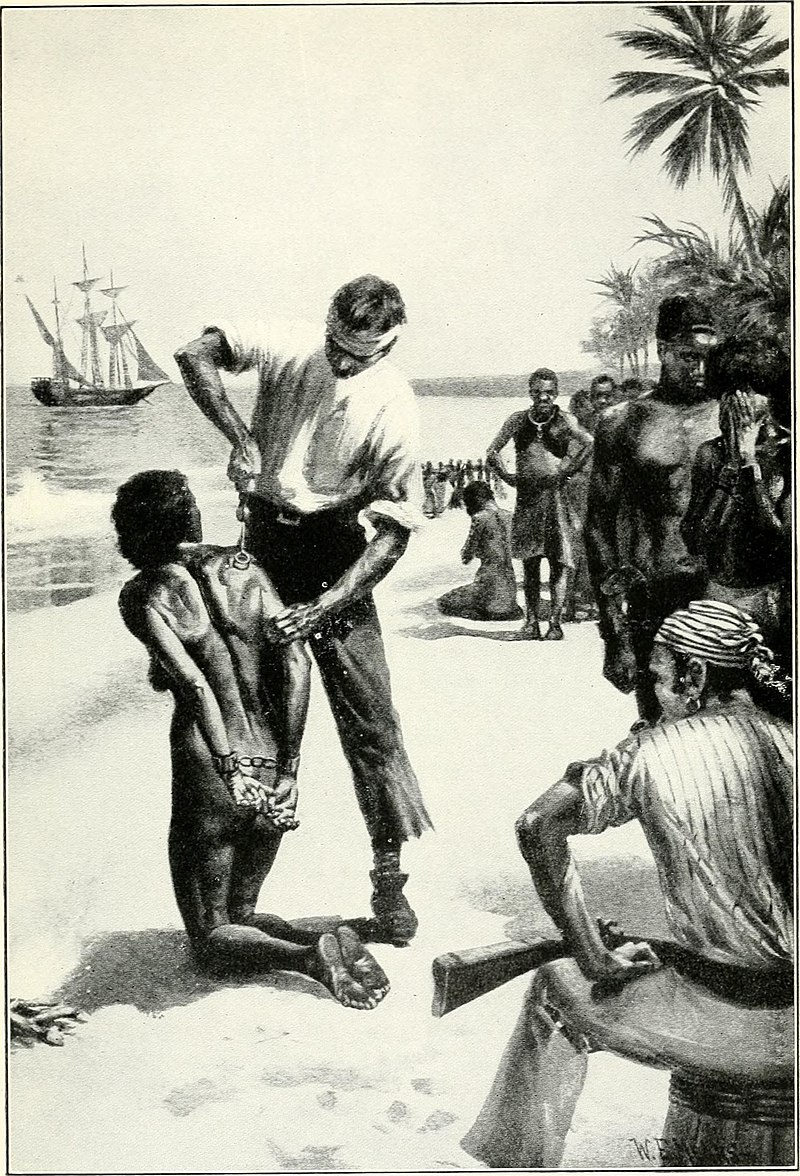 Branding of a female slave 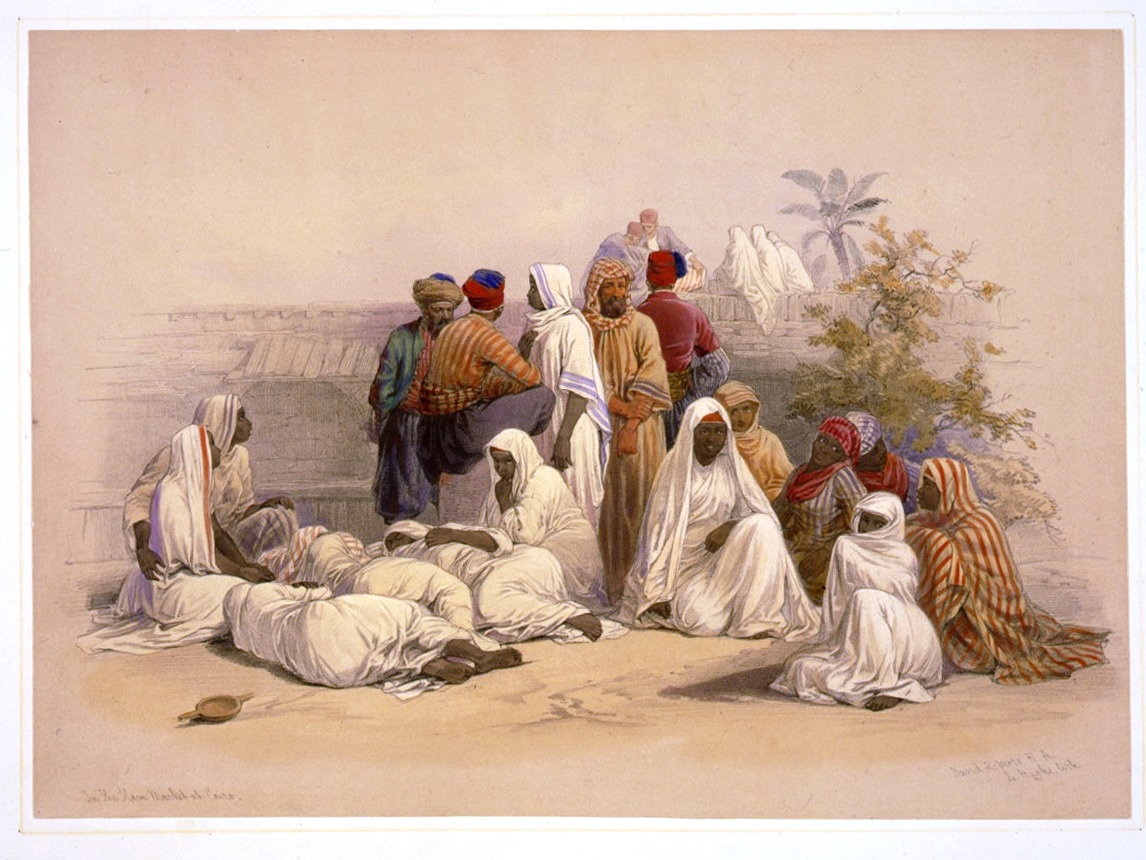 Barefooted slaves depicted in David Roberts' Egypt and Nubia, issued between 1845 and 1849 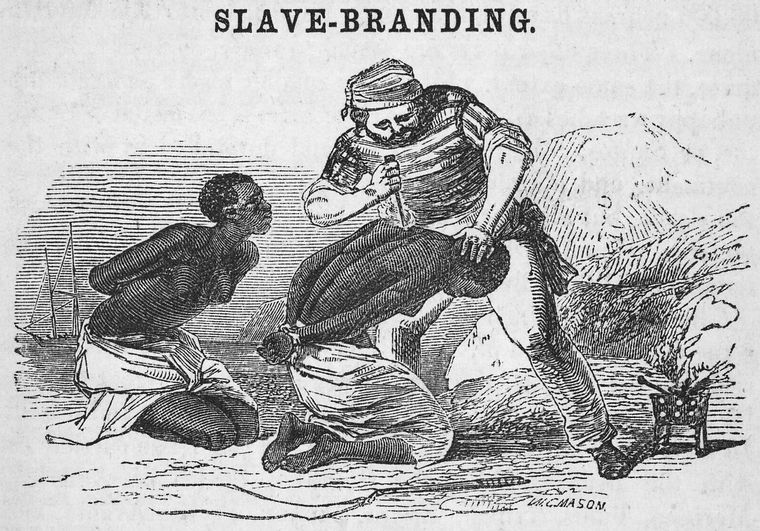 Slave branding, c. 1853 A widespread practice was branding, either to explicitly mark slaves as property or as punishment. |
特徴 経済学 経済学者は、奴隷制(および農奴制のような変種)がどのような状況で出現し、消滅するかをモデル化してきた。その一つは、土地は豊富だが労働力が乏しい場 合、地主にとって奴隷制がより望ましくなり、その結果、地代が下落し、有給労働者が高賃金を要求できるようになるというものである。その逆が成り立つとす れば、土地所有者にとっては、競争の度合いから低賃金しか要求できない有給労働者を雇うよりも、奴隷を警護する方がコストがかかることになる[61]。こ うしてヨーロッパでは、人口の増加に伴って、まず奴隷制が、次いで農奴制が徐々に減少していった。アメリカ大陸やロシアでは、住民の少ない広大な土地が利 用できるようになると、奴隷制が再び導入された[62]。 奴隷制は、サトウキビや綿花のような大規模な単作物のように、生産高が規模の経済に依存しているような、作業が比較的単純であり、したがって監督しやすい 場合に一般的である。そのため、大規模なプランテーションでは、アメリカのギャング制のような労働体系が顕著になり、工場並みの精度で畑仕事が行われるよ うになった。そして、各作業班は内部分業に基づいており、作業班のメンバー全員に仕事を割り当て、各作業員の成果を他の作業員の行動に依存させた。奴隷た ちは綿花の周囲に生える雑草や余分な芽を刈り取った。耕作班はその後に続き、綿花の近くの土をかき混ぜ、綿花の周りに投げ返した。こうして、ギャング・シ ステムは組み立てラインのように機能した[63]。 18世紀以降、批評家たちは、奴隷制度が技術の進歩を妨げているのは、単純作業をする奴隷の数を増やすことに焦点が当てられているためであり、彼らの効率 を向上させることではないからだと主張してきた。例えば、このような狭い焦点のために、ギリシアにおける技術(後のローマにおける技術)は肉体労働を容易 にしたり製造業を改善したりするために適用されなかったと主張されることがある[64][65]。  マーセダリアンの活動は、北アフリカで拘束されていたキリスト教徒の奴隷の身代金返還であった(1637年)。 スコットランドの経済学者アダム・スミスは、自由労働は奴隷労働よりも経済的に優れており、自由・民主・共和制の政府形態では奴隷制を廃止することはほぼ 不可能であると述べた。彼はさらに、奴隷は中央集権的な政府、あるいは国王や教会のような中央の権威のもとで自由を獲得することがより良いことであると述 べていた[66][67]。同様の議論は後にオーギュスト・コントの著作にも登場し、特にスミスが中世と奴隷制の終焉の間に三権分立、あるいはコントが 「精神的なものと時間的なものの分離」と呼んだものを信奉していたことや、スミスが過去と現在の主人たちを批判していたことを考慮すると、このような主張 が登場する。スミスは『法律学講義』の中で、「聖職者の偉大な権力は、王の権力と相まって、奴隷を自由にした。しかし、王の権威と聖職者の権威の両方が偉 大であることが絶対に必要であった。これらのいずれかが欠けていたところでは、奴隷制度は依然として続いている......」[68]。  奴隷の売買と検査 奴隷制度が犯罪となった後も、奴隷の所有者は高い収益を得ることができた。研究者のシッダールト・カラによると、2007年にあらゆる形態の奴隷制が世界 にもたらした利益は912億ドルだった。これは、世界的な犯罪企業という点では、麻薬密売に次ぐものだった。当時、奴隷の世界販売価格の加重平均は約 340ドルと推定され、人身売買された平均的な性奴隷の最高額は1,895ドル、アジアとアフリカの一部における債務奴隷の最低額は40~50ドルであっ た。2007年に奴隷が生み出した年間利益の加重平均は3,175ドルで、最低は拘束労働の平均950ドル、人身売買された性奴隷の29,210ドルで あった。毎年の奴隷の利益の約40%は、人身売買された性奴隷によって生み出されており、世界の2900万人の奴隷の4%強を占めている[69]。 身分証明  女性奴隷の焼き印  1845年から1849年にかけて発行されたデイヴィッド・ロバーツの『エジプトとヌビア』に描かれた裸足の奴隷たち。  奴隷の焼印、1853年頃 奴隷を所有物として明確に示すため、あるいは罰として、焼印を押すことが広く行われていた。 |
| Legal aspects Private versus state-owned slaves Slaves have been owned privately by individuals but have also been under state ownership. For example, the kisaeng were women from low castes in pre modern Korea, who were owned by the state under government officials known as hojang and were required to provide entertainment to the aristocracy; in the 2020s some are denoted Kippumjo (the pleasure brigades of North Korea — serving as the concubines of the rulers of the state).[70] "Tribute labor" is compulsory labor for the state and has been used in various iterations such as corvée, mit'a and repartimiento. The internment camps of totalitarian regimes such as the Nazis and the Soviet Union placed increasing importance on the labor provided in those camps, leading to a growing tendency among historians to designate such systems as slavery.[71] A combination of these include the encomienda where the Spanish Crown granted private individuals the right to the free labour of a specified number of natives in a given area.[72] In the "Red Rubber System" of both the Congo Free State and French ruled Ubangi-Shari,[73] labour was demanded as taxation; private companies were conceded areas within which they were allowed to use any measures to increase rubber production.[74] Convict leasing was common in the Southern United States where the state would lease prisoners for their free labour to companies. Legal rights Depending upon the era and the country, slaves sometimes had a limited set of legal rights. For example, in the Province of New York, people who deliberately killed slaves were punishable under a 1686 statute.[75] And, as already mentioned, certain legal rights attached to the nobi in Korea, to slaves in various African societies, and to black female slaves in the French colony of Louisiana. Giving slaves legal rights has sometimes been a matter of morality, but also sometimes a matter of self-interest. For example, in ancient Athens, protecting slaves from mistreatment simultaneously protected people who might be mistaken for slaves, and giving slaves limited property rights incentivized slaves to work harder to get more property.[76] In the southern United States prior to the extirpation of slavery in 1865, a proslavery legal treatise reported that slaves accused of crimes typically had a legal right to counsel, freedom from double jeopardy, a right to trial by jury in graver cases, and the right to grand jury indictment, but they lacked many other rights such as white adults' ability to control their own lives.[77] |
法的側面 私有奴隷と国有奴隷 奴隷は個人によって私的に所有されてきたが、国家所有の場合もあった。例えば、近世以前の朝鮮半島では、ホジャンと呼ばれる官吏の下で国家に所有され、貴 族に娯楽を提供することを義務付けられていた低階層の女性たちがキプムジョ(北朝鮮の快楽旅団-国家支配者の妾として仕える)と呼ばれている[70]。 「貢納労働」は国家に対する強制労働であり、コルヴェ、ミタ、レパルティミエントなど様々な形で用いられてきた。ナチスやソビエト連邦のような全体主義体 制の収容所では、収容所で提供される労働が重要視されるようになり、歴史家の間ではそのような制度を奴隷制とみなす傾向が強まった[71]。 コンゴ自由国とフランス統治下のウバンギ=シャリーの「レッドラバー・システム」[73]では、労働は税金として要求され、民間企業はゴム生産を増加させるためにどのような手段を用いることも許される地域を与えられた[74]。 法的権利 時代や国によって、奴隷は限られた法的権利を有していた。例えば、ニューヨーク州では、奴隷を故意に殺害した者は1686年の法令により処罰された [75]。また、すでに述べたように、韓国ではノビに、アフリカの様々な社会では奴隷に、フランスのルイジアナ植民地では黒人女性奴隷に一定の法的権利が 与えられた。奴隷に法的権利を与えることは、道徳的な問題であることもあるが、利己的な問題であることもある。例えば、古代アテネでは、奴隷を虐待から守 ると同時に、奴隷と間違われる可能性のある人々を保護し、奴隷に限定的な財産権を与えることで、奴隷がより多くの財産を得るために懸命に働く動機付けと なった。 [76] 1865年に奴隷制が廃止される前のアメリカ南部では、ある奴隷制推進派の法律論が、犯罪で告発された奴隷は通常、弁護人に対する法的権利、二重の危険か らの自由、重大な事件における陪審員による裁判を受ける権利、大陪審による起訴を受ける権利を有していたが、白人の成人が自らの生活を管理する能力など、 他の多くの権利を欠いていたと報告している[77]。 |
| History Main article: History of slavery See also: Slavery in antiquity 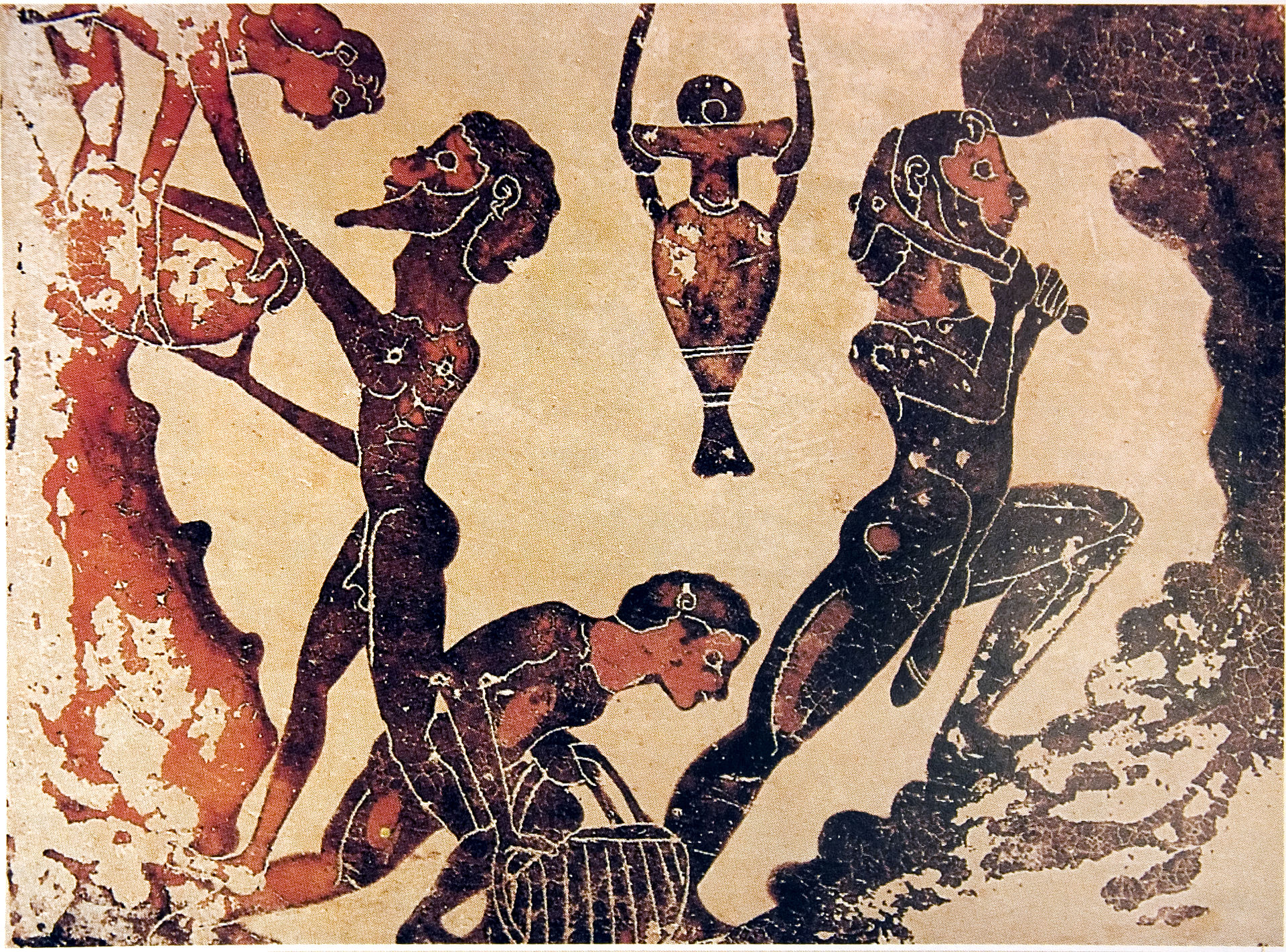 Corinthian black-figure terra-cotta votive tablet of slaves working in a mine, dated to the late seventh century BC Slavery predates written records and has existed in many cultures.[3] Slavery is rare among hunter-gatherer populations because it requires economic surpluses and a substantial population density. Thus, although it has existed among unusually resource-rich hunter gatherers, such as the American Indian peoples of the salmon-rich rivers of the Pacific Northwest coast, slavery became widespread only with the invention of agriculture during the Neolithic Revolution about 11,000 years ago.[78] Slavery was practiced in almost every ancient civilization.[3] Such institutions included debt bondage, punishment for crime, the enslavement of prisoners of war, child abandonment, and the enslavement of slaves' offspring.[79] Africa See also: Slavery in Africa Slavery was widespread in Africa, which pursued both internal and external slave trade.[80] In the Senegambia region, between 1300 and 1900, close to one-third of the population was enslaved. In early Islamic states of the western Sahel, including Ghana, Mali, Segou, and Songhai, about a third of the population were enslaved.[81] In European courtly society, and European aristocracy, black African slaves and their children became visible in the late 1300s and 1400s. Starting with Frederick II, Holy Roman Emperor, black Africans were included in the retinue. In 1402 an Ethiopian embassy reached Venice. In the 1470s black Africans were painted as court attendants in wall paintings that were displayed in Mantua and Ferrara. In the 1490s black Africans were included on the emblem of the Duke of Milan.[82] 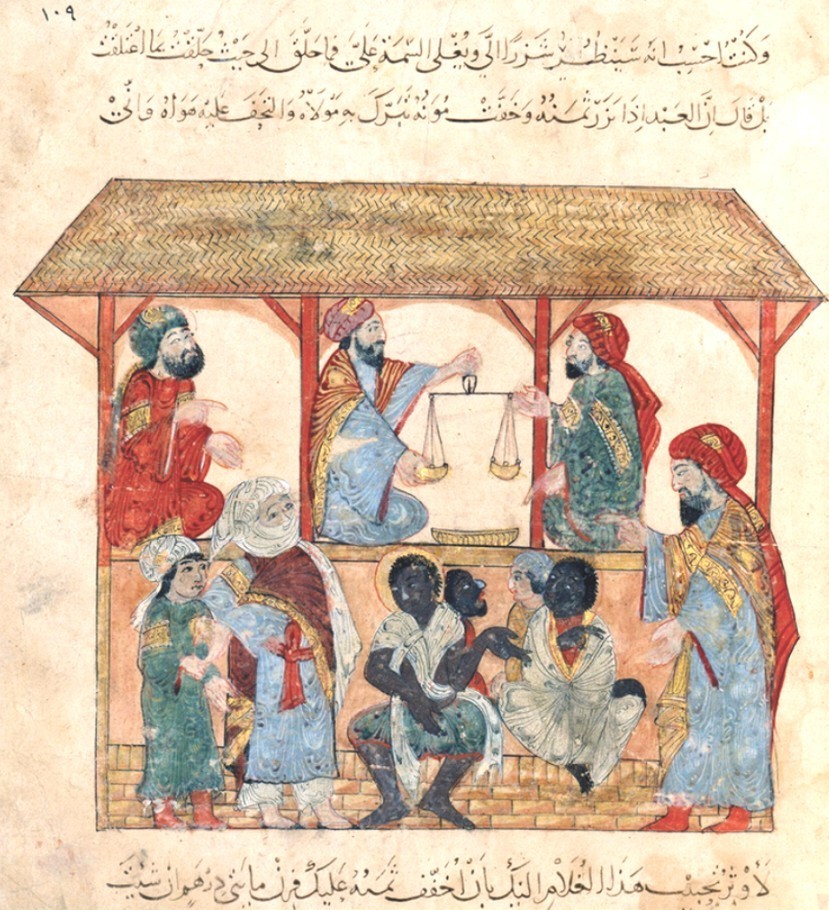 13th-century slave market in Yemen.[83] During the trans-Saharan slave trade, slaves from West Africa were transported across the Sahara desert to North Africa to be sold to Mediterranean and Middle eastern civilizations. During the Red Sea slave trade, slaves were transported from Africa across the Red Sea to the Arabian Peninsula. The Indian Ocean slave trade, sometimes known as the east African slave trade, was multi-directional. Africans were sent as slaves to the Arabian Peninsula, to Indian Ocean islands (including Madagascar), to the Indian subcontinent, and later to the Americas. These traders captured Bantu peoples (Zanj) from the interior in present-day Kenya, Mozambique and Tanzania and brought them to the coast.[84][85] There, the slaves gradually assimilated in rural areas, particularly on Unguja and Pemba islands.[86] Some historians assert that as many as 17 million people were sold into slavery on the coast of the Indian Ocean, the Middle East, and North Africa, and approximately 5 million African slaves were bought by Muslim slave traders and taken from Africa across the Red Sea, Indian Ocean, and Sahara Desert between 1500 and 1900.[87] The captives were sold throughout the Middle East. This trade accelerated as superior ships led to more trade and greater demand for labour on plantations in the region. Eventually, tens of thousands of captives were being taken every year.[86][88][89] The Indian Ocean slave trade was multi-directional and changed over time. To meet the demand for menial labour, Bantu slaves bought by east African slave traders from southeastern Africa were sold in cumulatively large numbers over the centuries to customers in Egypt, Arabia, the Persian Gulf, India, European colonies in the Far East, the Indian Ocean islands, Ethiopia and Somalia.[90] According to the Encyclopedia of African History, "It is estimated that by the 1890s the largest slave population of the world, about 2 million people, was concentrated in the territories of the Sokoto Caliphate. The use of slave labour was extensive, especially in agriculture."[91][92] The Anti-Slavery Society estimated there were 2 million slaves in Ethiopia in the early 1930s out of an estimated population of 8 to 16 million.[93] Slave labour in East Africa was drawn from the Zanj, Bantu peoples that lived along the East African coast.[85][94] The Zanj were for centuries shipped as slaves by Arab traders to all the countries bordering the Indian Ocean. The Umayyad and Abbasid caliphs recruited many Zanj slaves as soldiers and, as early as 696, there were slave revolts of the Zanj against their Arab enslavers in Iraq. The Zanj Rebellion, a series of uprisings that took place between 869 and 883 near Basra (also known as Basara), situated in present-day Iraq, is believed to have involved enslaved Zanj that had originally been captured from the African Great Lakes region and areas further south in East Africa.[95] It grew to involve over 500,000 slaves and free men who were imported from across the Muslim empire and claimed over "tens of thousands of lives in lower Iraq".[96] The Zanj who were taken as slaves to the Middle East were often used in strenuous agricultural work.[97] As the plantation economy boomed and the Arabs became richer, agriculture and other manual labour work was thought to be demeaning. The resulting labour shortage led to an increased slave market. 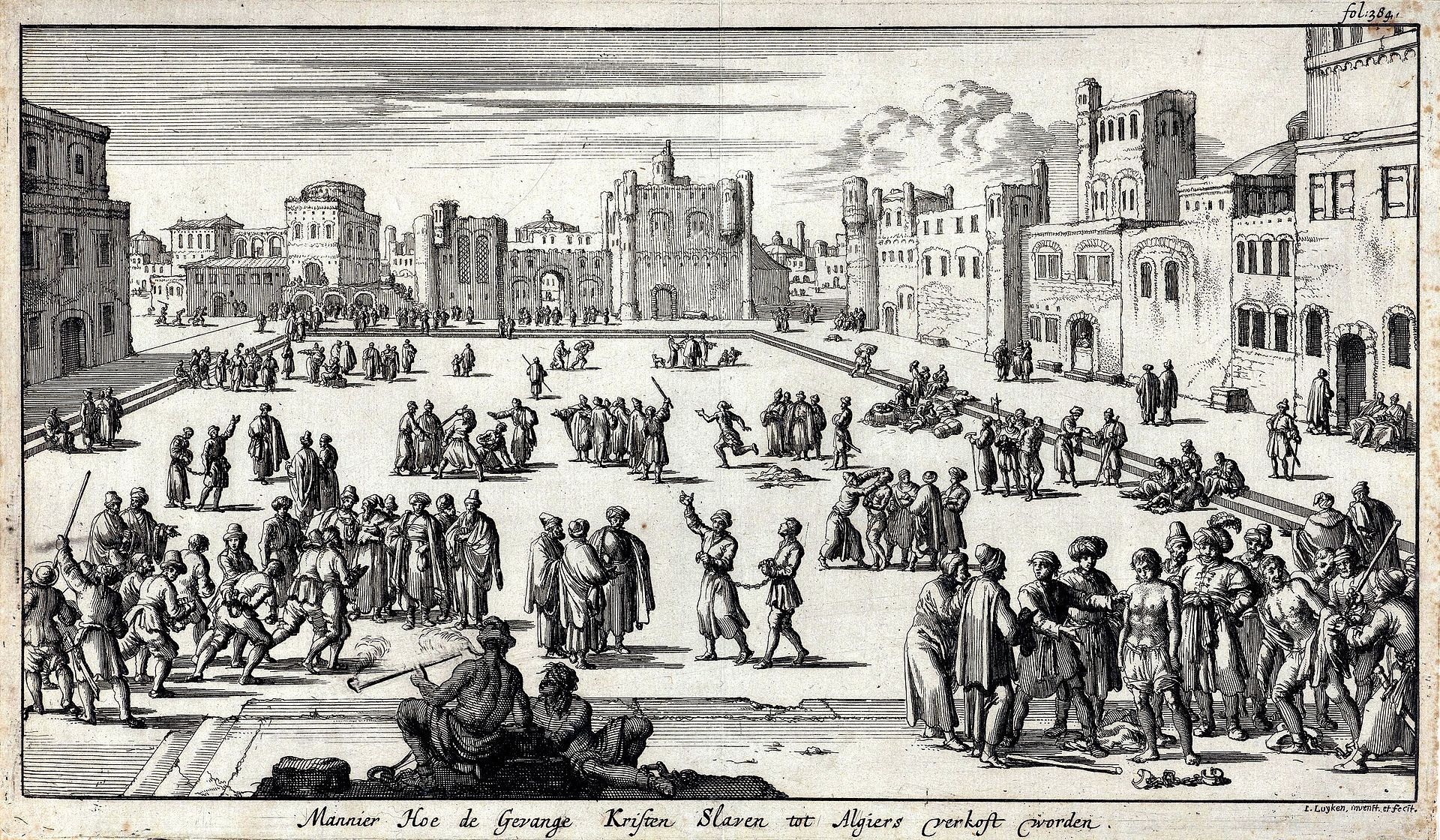 Slave market in Algiers, 1684 In Algiers, the capital of Algeria, captured Christians and Europeans were forced into slavery. In about 1650, there were as many as 35,000 Christian slaves in Algiers.[98] By one estimate, raids by Barbary slave traders on coastal villages and ships extending from Italy to Iceland, enslaved an estimated 1 to 1.25 million Europeans between the 16th and 19th centuries.[99][100][101] However, this estimate is the result of an extrapolation which assumes that the number of European slaves captured by Barbary pirates was constant for a 250-year period: There are no records of how many men, women and children were enslaved, but it is possible to calculate roughly the number of fresh captives that would have been needed to keep populations steady and replace those slaves who died, escaped, were ransomed, or converted to Islam. On this basis it is thought that around 8,500 new slaves were needed annually to replenish numbers – about 850,000 captives over the century from 1580 to 1680. By extension, for the 250 years between 1530 and 1780, the figure could easily have been as high as 1,250,000.[102] Davis' numbers have been refuted by other historians, such as David Earle, who cautions that true picture of Europeans slaves is clouded by the fact the corsairs also seized non-Christian whites from eastern Europe.[102] In addition, the number of slaves traded was hyperactive,[clarification needed] with exaggerated estimates relying on peak years to calculate averages for entire centuries, or millennia. Hence, there were wide fluctuations year-to-year, particularly in the 18th and 19th centuries, given slave imports, and also given the fact that, prior to the 1840s, there are no consistent records. Middle East expert, John Wright, cautions that modern estimates are based on back-calculations from human observation.[103] Such observations, across the late 16th and early 17th century observers, account for around 35,000 European Christian slaves held throughout this period on the Barbary Coast, across Tripoli, Tunis, but mostly in Algiers. The majority were sailors (particularly those who were English), taken with their ships, but others were fishermen and coastal villagers. However, most of these captives were people from lands close to Africa, particularly Spain and Italy.[104] This eventually led to the bombardment of Algiers by an Anglo-Dutch fleet in 1816.[105][106] 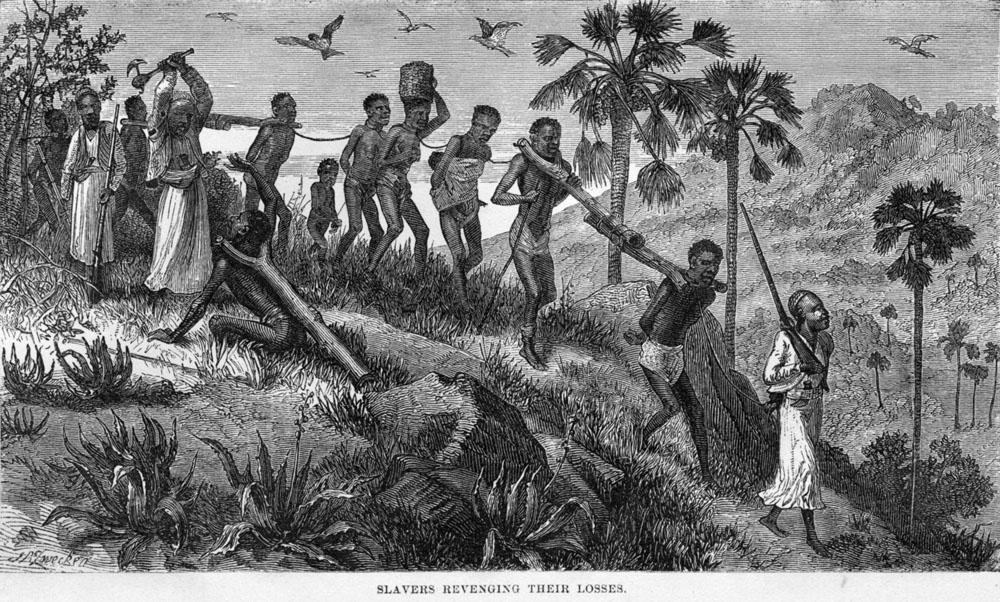 Arab-Swahili slave traders and their captives on the Ruvuma River in East Africa, 19th century Under Omani Arabs, Zanzibar became East Africa's main slave port, with as many as 50,000 African slaves passing through every year during the 19th century.[107][108] Some historians estimate that between 11 and 18 million African slaves crossed the Red Sea, Indian Ocean, and Sahara Desert from 650 to 1900 AD.[3][failed verification][109] Eduard Rüppell described the losses of Sudanese slaves being transported on foot to Egypt: "after the Daftardar bey's 1822 campaign in the southern Nuba mountains, nearly 40,000 slaves were captured. However, through bad treatment, disease and desert travel barely 5,000 made it to Egypt."[110] W.A. Veenhoven wrote: "The German doctor, Gustav Nachtigal, an eye-witness, believed that for every slave who arrived at a market three or four died on the way ... Keltie (The Partition of Africa, London, 1920) believes that for every slave the Arabs brought to the coast at least six died on the way or during the slavers' raid. Livingstone puts the figure as high as ten to one."[111] Systems of servitude and slavery were common in parts of Africa, as they were in much of the ancient world. In many African societies where slavery was prevalent, the slaves were not treated as chattel slaves and were given certain rights in a system similar to indentured servitude elsewhere in the world. The forms of slavery in Africa were closely related to kinship structures. In many African communities, where land could not be owned, enslavement of individuals was used as a means to increase the influence a person had and expand connections.[112] This made slaves a permanent part of a master's lineage and the children of slaves could become closely connected with the larger family ties.[113] Children of slaves born into families could be integrated into the master's kinship group and rise to prominent positions within society, even to the level of chief in some instances. However, stigma often remained attached and there could be strict separations between slave members of a kinship group and those related to the master.[112] Slavery was practiced in many different forms: debt slavery, enslavement of war captives, military slavery, and criminal slavery were all practiced in various parts of Africa.[114] Slavery for domestic and court purposes was widespread throughout Africa. 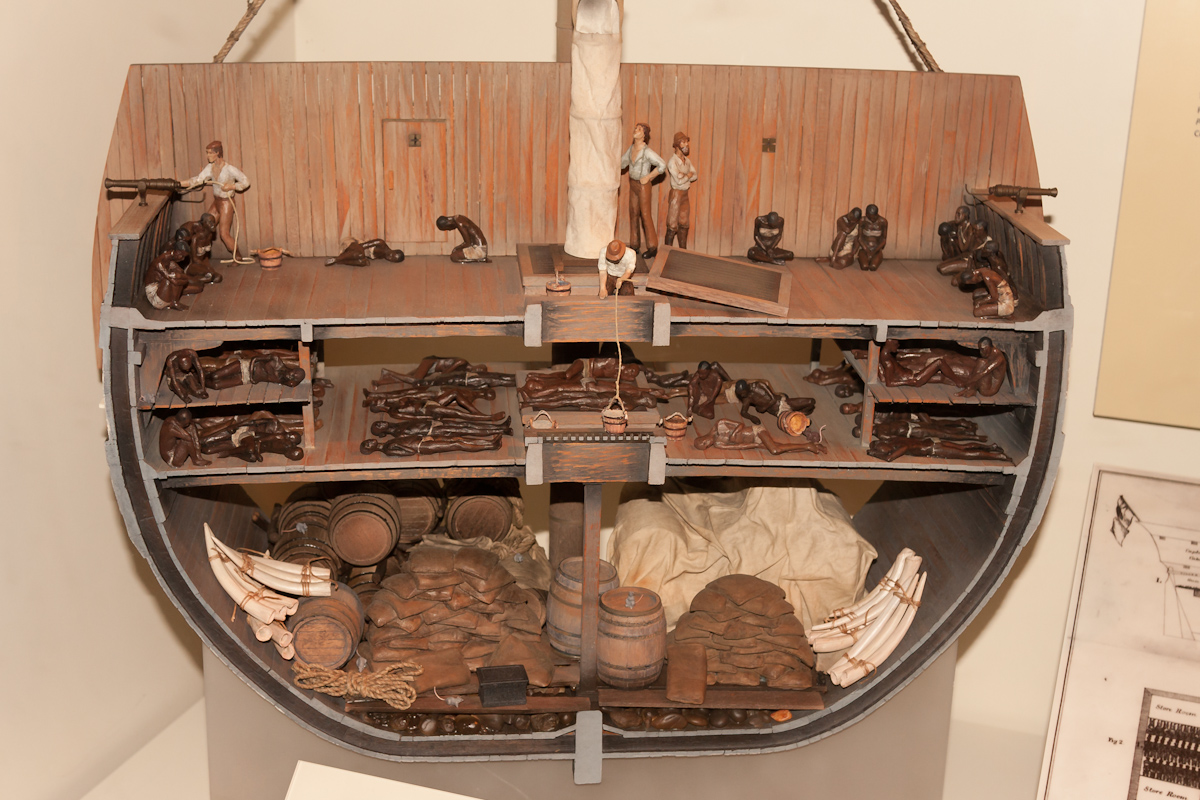 A model showing a cross-section of a typical 1700s European slave ship on the Middle Passage, National Museum of American History. When the Atlantic slave trade began, many of the local slave systems began supplying captives for chattel slave markets outside Africa. Although the Atlantic slave trade was not the only slave trade from Africa, it was the largest in volume and intensity. As Elikia M'bokolo wrote in Le Monde diplomatique: The African continent was bled of its human resources via all possible routes. Across the Sahara, through the Red Sea, from the Indian Ocean ports and across the Atlantic. At least ten centuries of slavery for the benefit of the Muslim countries (from the ninth to the nineteenth).... Four million enslaved people exported via the Red Sea, another four million through the Swahili ports of the Indian Ocean, perhaps as many as nine million along the trans-Saharan caravan route, and eleven to twenty million (depending on the author) across the Atlantic Ocean.[115] The trans-Atlantic slave trade peaked in the late 18th century, when the largest number of slaves were captured on raiding expeditions into the interior of West Africa. These expeditions were typically carried out by African kingdoms, such as the Oyo Empire (Yoruba), the Ashanti Empire,[116] the kingdom of Dahomey,[117] and the Aro Confederacy.[118] It is estimated that about 15 percent of slaves died during the voyage, with mortality rates considerably higher in Africa itself in the process of capturing and transporting indigenous peoples to the ships.[119][120] Americas Further information: Atlantic slave trade; Encomienda; Mita (Inca); Institute for Trafficked, Exploited, and Missing Persons; Slavery in colonial Spanish America; Slavery in Brazil; and Slavery in the United States Slavery in Mexico can be traced back to the Aztecs.[121] Other Amerindians, such as the Inca of the Andes, the Tupinambá of Brazil, the Creek of Georgia, and the Comanche of Texas, also practiced slavery.[3] Slavery in Canada was practiced by First Nations and by European settlers.[122] Slave-owning people of what became Canada were, for example, the fishing societies, such as the Yurok, that lived along the Pacific coast from Alaska to California,[123] on what is sometimes described as the Pacific or Northern Northwest Coast. Some of the indigenous peoples of the Pacific Northwest Coast, such as the Haida and Tlingit, were traditionally known as fierce warriors and slave-traders, raiding as far as California. Slavery was hereditary, the slaves being prisoners of war and their descendants were slaves.[124] Some nations in British Columbia continued to segregate and ostracize the descendants of slaves as late as the 1970s.[125] 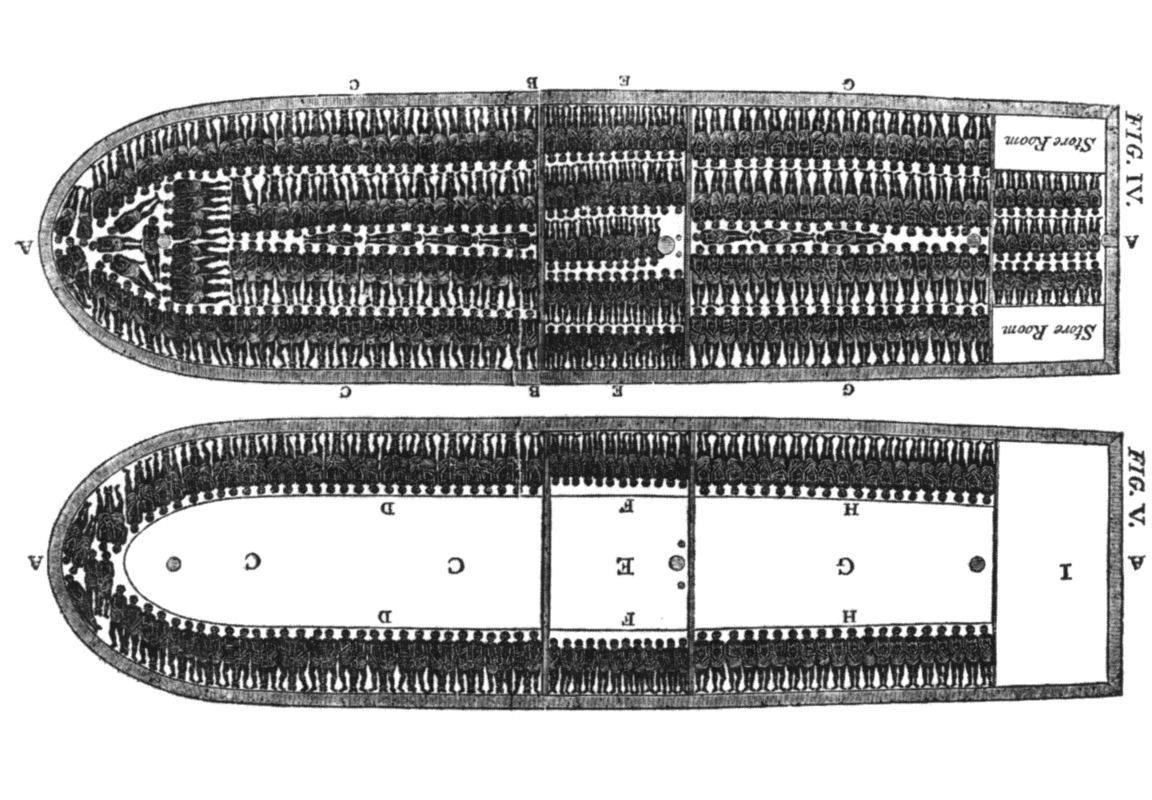 Diagrams of a slave ship and the alignment of captive slaves during the Atlantic slave trade. Slavery in America remains a contentious issue and played a major role in the history and evolution of some countries, triggering a revolution, a civil war, and numerous rebellions. The countries that controlled most of the transatlantic slave market in terms of number of slaves shipped were the UK, Portugal and France. 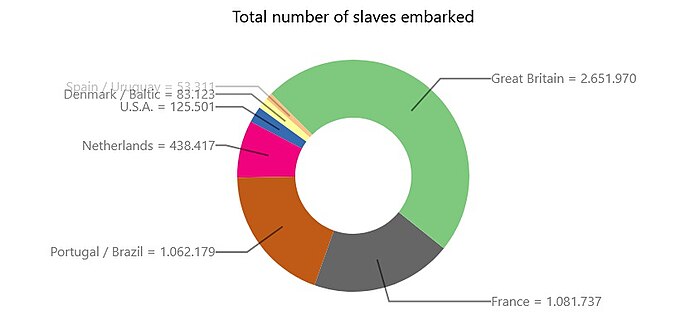 Slaves embarked to America from 1450 until 1800 by country In order to establish itself as an American empire, Spain had to fight against the relatively powerful civilizations of the New World. The Spanish conquest of the indigenous peoples in the Americas included using the Natives as forced labour. The Spanish colonies were the first Europeans to use African slaves in the New World on islands such as Cuba and Hispaniola.[126] It was argued by some contemporary writers to be intrinsically immoral.[127][128][129] Bartolomé de las Casas, a 16th-century Dominican friar and Spanish historian, participated in campaigns in Cuba (at Bayamo and Camagüey) and was present at the massacre of Hatuey; his observation of that massacre led him to fight for a social movement away from the use of natives as slaves. Also, the alarming decline in the native population had spurred the first royal laws protecting the native population. The first African slaves arrived in Hispaniola in 1501.[130] This era saw a growth in race-based slavery[131] England played a prominent role in the Atlantic slave trade. The "slave triangle" was pioneered by Francis Drake and his associates, though English slave-trading would not take off until the mid-17th century. Many whites who arrived in North America during the 17th and 18th centuries came under contract as indentured servants.[132] The transformation from indentured servitude to slavery was a gradual process in Virginia. The earliest legal documentation of such a shift was in 1640 where a black man, John Punch, was sentenced to lifetime slavery, forcing him to serve his master, Hugh Gwyn, for the remainder of his life, for attempting to run away. This case was significant because it established the disparity between his sentence as a black man and that of the two white indentured servants who escaped with him (one described as Dutch and one as a Scotchman). It is the first documented case of a black man sentenced to lifetime servitude and is considered one of the first legal cases to make a racial distinction between black and white indentured servants.[133][134] After 1640, planters started to ignore the expiration of indentured contracts and keep their servants as slaves for life. This was demonstrated by the 1655 case Johnson v. Parker, where the court ruled that a black man, Anthony Johnson of Virginia, was granted ownership of another black man, John Casor, as the result of a civil case.[135] This was the first instance of a judicial determination in the Thirteen Colonies holding that a person who had committed no crime could be held in servitude for life.[136][137] Spanish colonial America In 1519, Hernán Cortés brought the first modern slave to the area.[138] In the mid-16th century, the Spanish New Laws, prohibited slavery of the indigenous people, including the Aztecs. A labour shortage resulted. This led to the African slaves being imported, as they were not susceptible to smallpox. In exchange, many Africans were afforded the opportunity to buy their freedom, while eventually others were granted their freedom by their masters.[138] In Jamaica, the Spanish enslaved many of the Taino; some escaped, but most died from European diseases and overwork. The Spaniards also introduced the first African slaves.[139] Spain practically did not trade in slaves until 1810 after the rebellions and independence of its American territories or viceroyalties. After the Napoleonic invasions, Spain had lost its industry and its American territories, except in Cuba and Puerto Rico, where the African slave trade to Cuba began on a massive scale from 1810 onwards. It was started by French planters exiled from the French lost colony Saint Domingue (Haiti) who settled in the eastern part of Cuba. In 1789 the Spanish Crown led an effort to reform slavery, as the demand for slave labour in Cuba was growing. The Crown issued a decree, Código Negro Español (Spanish Black Code), that specified food and clothing provisions, put limits on the number of work hours, limited punishments, required religious instruction, and protected marriages, forbidding the sale of young children away from their mothers. The British made other changes to the institution of slavery in Cuba. But planters often flouted the laws and protested against them, considering them a threat to their authority and an intrusion into their personal lives.[140] English and Dutch Caribbean 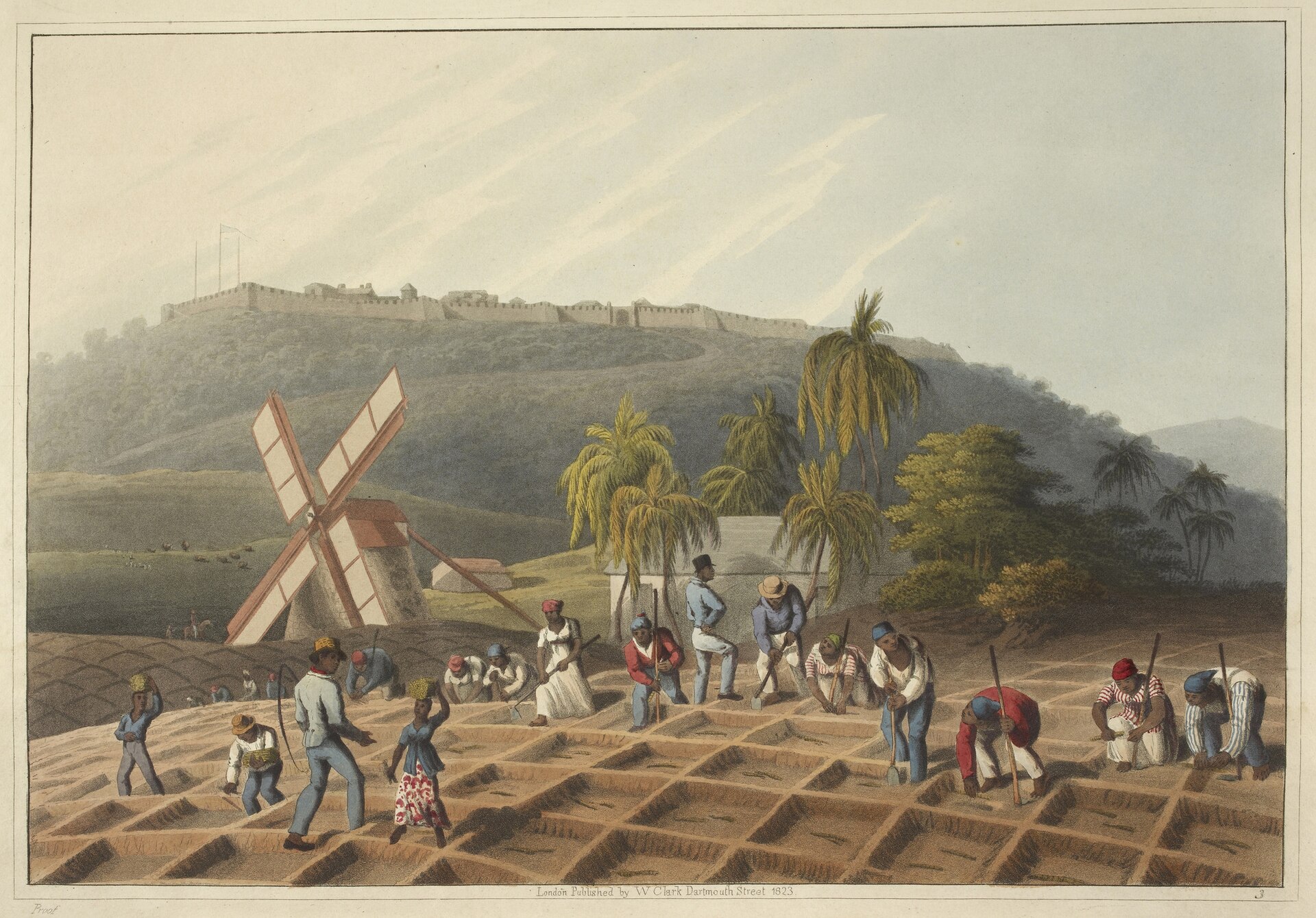 Planting the sugar cane, British West Indies, 1823 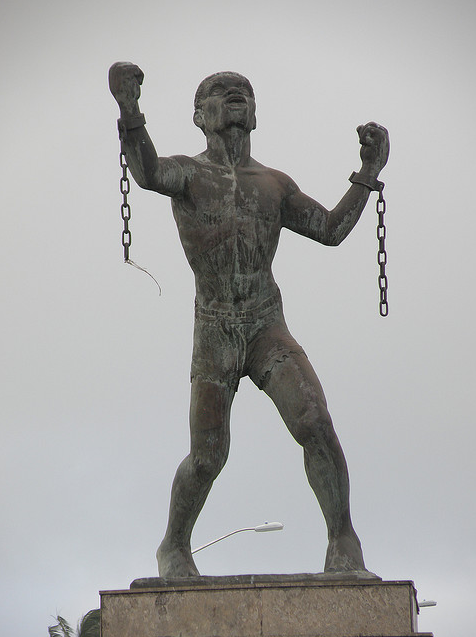 Statue of Bussa, who led the largest slave rebellion in Barbadian history. In the early 17th century, the majority of the labour in Barbados was provided by European indentured servants, mainly English, Irish and Scottish, with African and native American slaves providing little of the workforce. The introduction of sugar cane in 1640 completely transformed society and the economy. Barbados eventually had one of the world's largest sugar industries.[141] The workable sugar plantation required a large investment and a great deal of heavy labour. At first, Dutch traders supplied the equipment, financing, and African slaves, in addition to transporting most of the sugar to Europe. In 1644, the population of Barbados was estimated at 30,000, of which about 800 were of African descent, with the remainder mainly of English descent. By 1700, there were 15,000 free whites and 50,000 enslaved Africans. In Jamaica, although the African slave population in the 1670s and 1680s never exceeded 10,000, by 1800 it had increased to over 300,000. The increased implementation of slave codes or black codes, which created differential treatment between Africans and the white workers and ruling planter class. In response to these codes, several slave rebellions were attempted or planned during this time, but none succeeded. 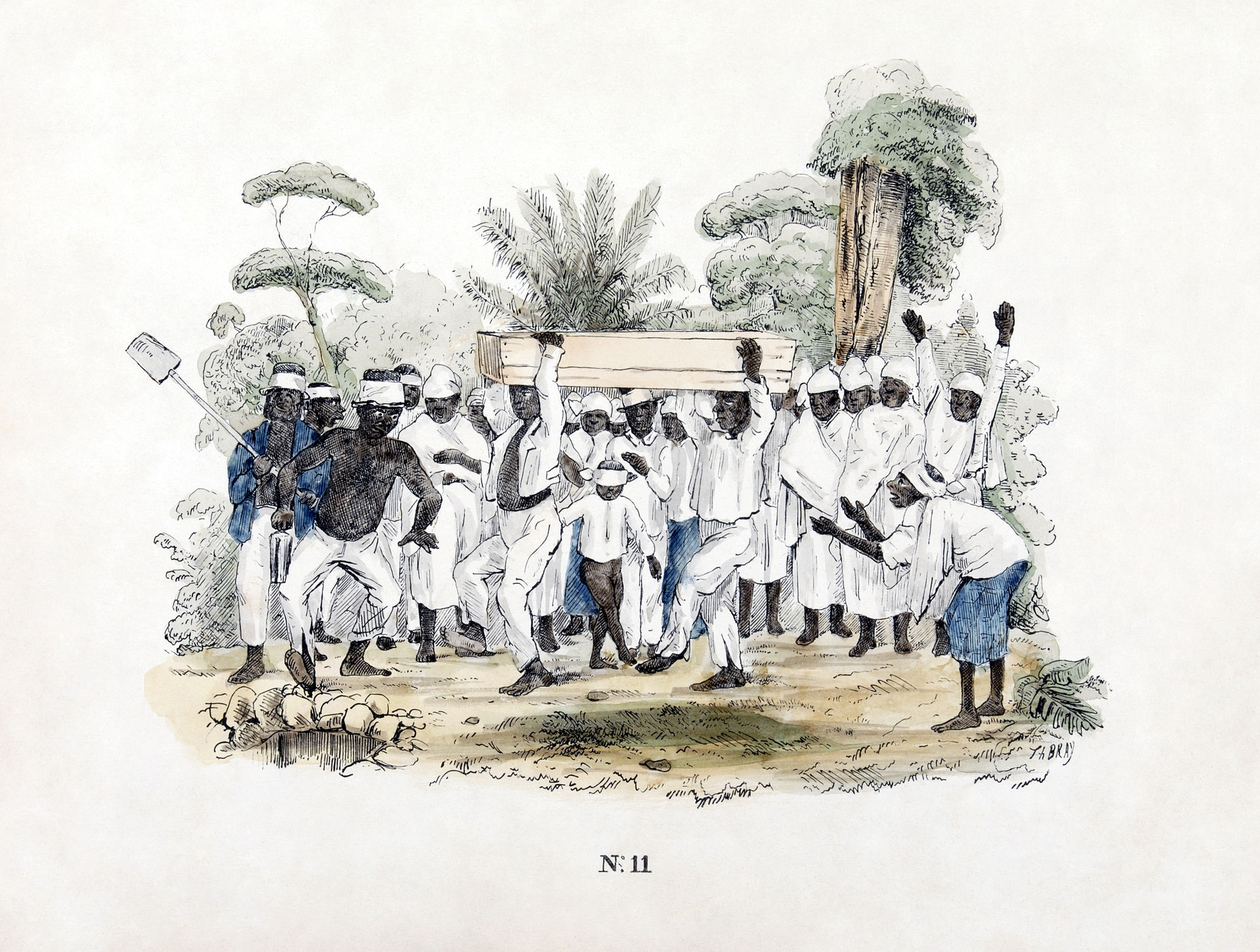 Funeral at slave plantation, Dutch Suriname. 1840–1850. The planters of the Dutch colony of Suriname relied heavily on African slaves to cultivate, harvest and process the commodity crops of coffee, cocoa, sugar cane and cotton plantations.[142] The Netherlands abolished slavery in Suriname in 1863. Many slaves escaped the plantations. With the help of the native South Americans living in the adjoining rain forests, these runaway slaves established a new and unique culture in the interior that was highly successful in its own right. They were known collectively in English as Maroons, in French as Nèg'Marrons (literally meaning "brown negroes", that is "pale-skinned negroes"), and in Dutch as Marrons. The Maroons gradually developed several independent tribes through a process of ethnogenesis, as they were made up of slaves from different African ethnicities. These tribes include the Saramaka, Paramaka, Ndyuka or Aukan, Kwinti, Aluku or Boni, and Matawai. The Maroons often raided plantations to recruit new members from the slaves and capture women, as well as to acquire weapons, food and supplies. They sometimes killed planters and their families in the raids.[143] The colonists also mounted armed campaigns against the Maroons, who generally escaped through the rain forest, which they knew much better than did the colonists. To end hostilities, in the 18th century the European colonial authorities signed several peace treaties with different tribes. They granted the Maroons sovereign status and trade rights in their inland territories, giving them autonomy. Brazil 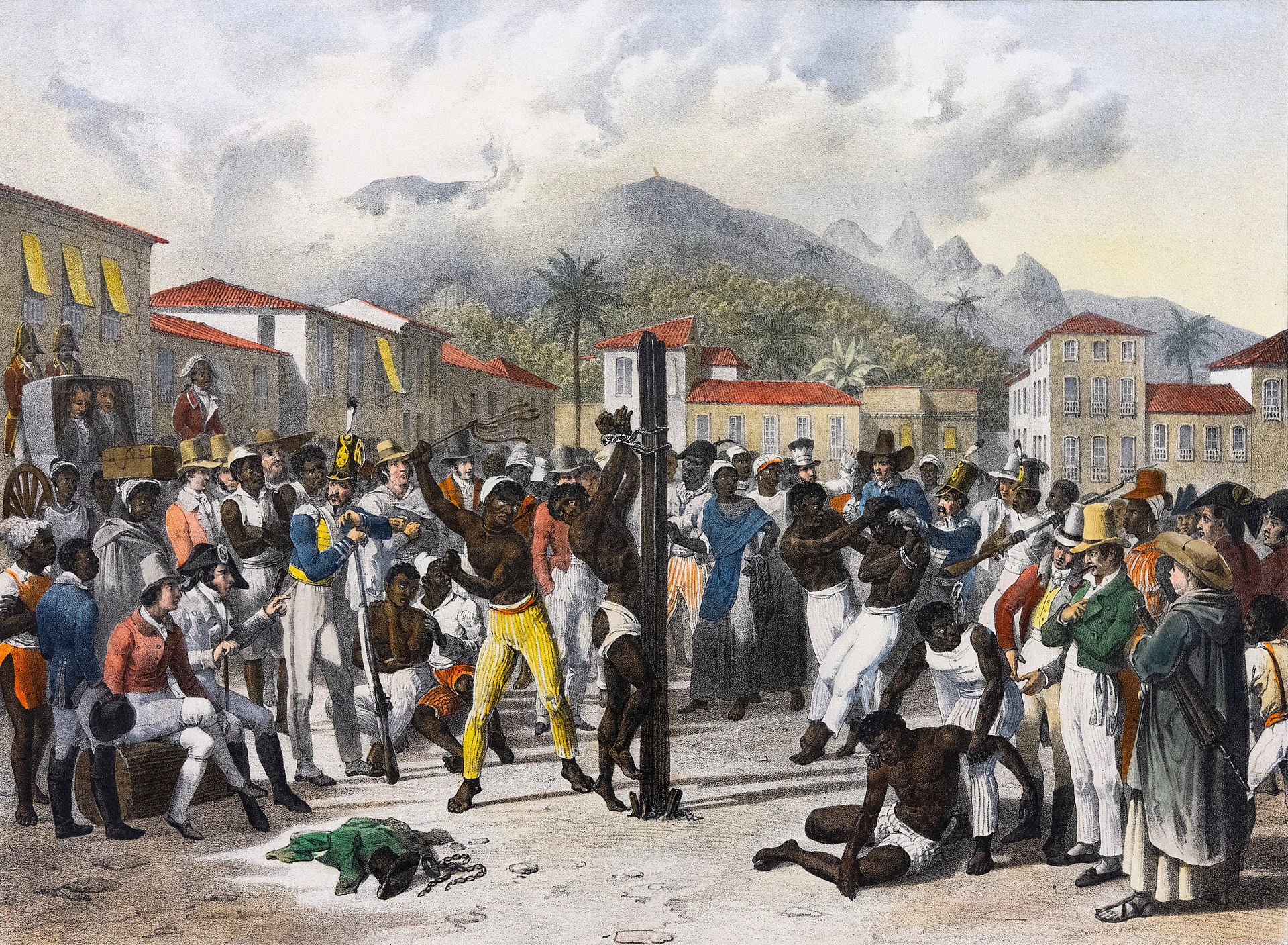 Public flogging of a slave in 19th-century Brazil, by Johann Moritz Rugendas 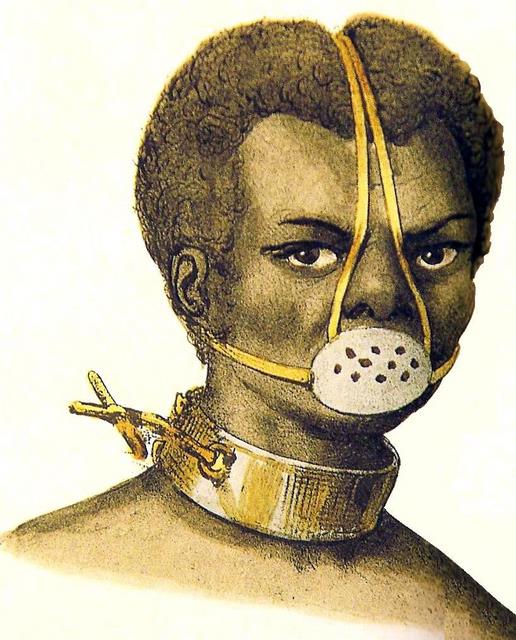 Slave punishment by Jacques Étienne Arago, 1839. Slavery in Brazil began long before the first Portuguese settlement was established in 1532, as members of one tribe would enslave captured members of another.[144] Later, Portuguese colonists were heavily dependent on indigenous labour during the initial phases of settlement to maintain the subsistence economy, and natives were often captured by expeditions called bandeiras. The importation of African slaves began midway through the 16th century, but the enslavement of indigenous peoples continued well into the 17th and 18th centuries. During the Atlantic slave trade era, Brazil imported more African slaves than any other country. Nearly 5 million slaves were brought from Africa to Brazil during the period from 1501 to 1866.[145] Until the early 1850s, most African slaves who arrived on Brazilian shores were forced to embark at West Central African ports, especially in Luanda (in present-day Angola). Today, with the exception of Nigeria, the country with the largest population of people of African descent is Brazil.[146] Slave labour was the driving force behind the growth of the sugar economy in Brazil, and sugar was the primary export of the colony from 1600 to 1650. Gold and diamond deposits were discovered in Brazil in 1690, which sparked an increase in the importation of African slaves to power this newly profitable market. Transportation systems were developed for the mining infrastructure, and population boomed from immigrants seeking to take part in gold and diamond mining. Demand for African slaves did not wane after the decline of the mining industry in the second half of the 18th century. Cattle ranching and foodstuff production proliferated after the population growth, both of which relied heavily on slave labour. 1.7 million slaves were imported to Brazil from Africa from 1700 to 1800, and the rise of coffee in the 1830s further enticed expansion of the slave trade. Brazil was the last country in the Western world to abolish slavery. Forty percent of the total number of slaves brought to the Americas were sent to Brazil. For reference, the United States received 10 percent. Despite being abolished, there are still people working in slavery-like conditions in Brazil in the 21st century. Haiti Slavery in Haiti started with the arrival of Christopher Columbus on the island in 1492. The practice was devastating to the native population.[147] Following the indigenous Taíno's near decimation from forced labour, disease and war, the Spanish, under advisement of the Catholic priest Bartolomé de las Casas, and with the blessing of the Catholic church, who also wished to protect the indigenous people, began engaging in earnest in the use of African slaves.[clarification needed] During the French colonial period beginning in 1625, the economy of Haiti (then known as Saint-Domingue) was based on slavery, and the practice there was regarded as the most brutal in the world. 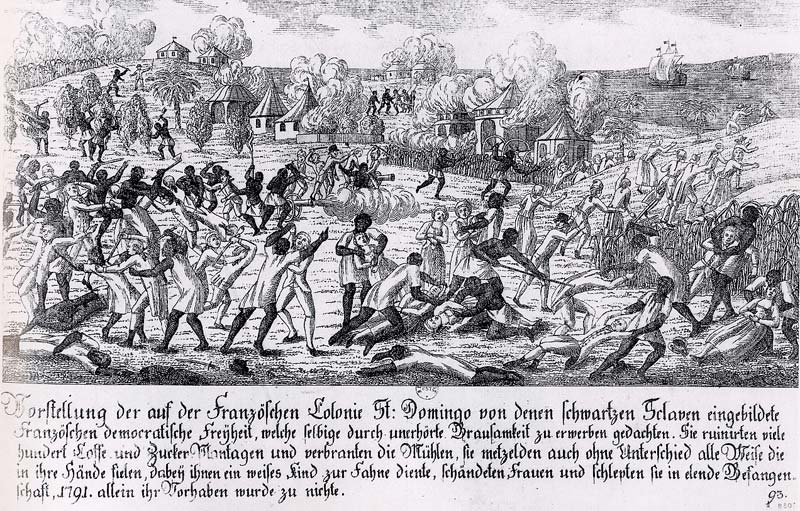 Saint-Domingue slave revolt in 1791 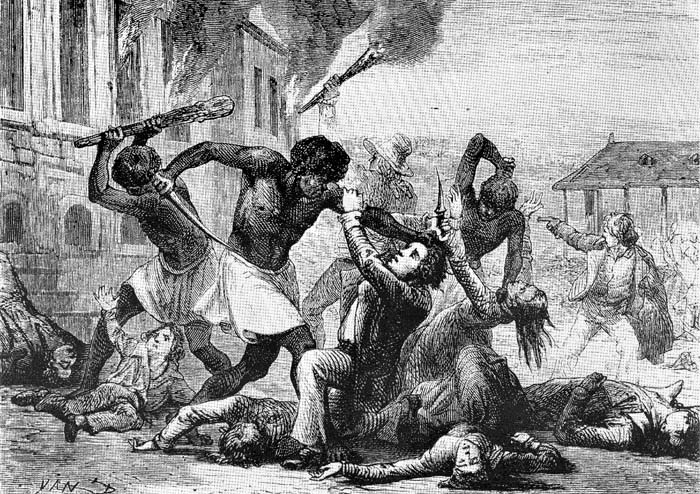 1804 Haiti massacre, carried out by Haitian soldiers, mostly former slaves, against the remaining French population Following the Treaty of Ryswick of 1697, Hispaniola was divided between France and Spain. France received the western third and subsequently named it Saint-Domingue. To develop it into sugarcane plantations, the French imported thousands of slaves from Africa. Sugar was a lucrative commodity crop throughout the 18th century. By 1789, approximately 40,000 white colonists lived in Saint-Domingue. The whites were vastly outnumbered by the tens of thousands of African slaves they had imported to work on their plantations, which were primarily devoted to the production of sugarcane. In the north of the island, slaves were able to retain many ties to African cultures, religion and language; these ties were continually being renewed by newly imported Africans. Blacks outnumbered whites by about ten to one. The French-enacted Code Noir ("Black Code"), prepared by Jean-Baptiste Colbert and ratified by Louis XIV, had established rules on slave treatment and permissible freedoms. Saint-Domingue has been described as one of the most brutally efficient slave colonies; one-third of newly imported Africans died within a few years.[148] Many slaves died from diseases such as smallpox and typhoid fever.[149] They had birth rates around 3 percent, and there is evidence that some women aborted fetuses, or committed infanticide, rather than allow their children to live within the bonds of slavery.[150][151] As in its Louisiana colony, the French colonial government allowed some rights to free people of color: the mixed-race descendants of white male colonists and black female slaves (and later, mixed-race women). Over time, many were released from slavery. They established a separate social class. White French Creole fathers frequently sent their mixed-race sons to France for their education. Some men of color were admitted into the military. More of the free people of color lived in the south of the island, near Port-au-Prince, and many intermarried within their community. They frequently worked as artisans and tradesmen, and began to own some property. Some became slave holders. The free people of color petitioned the colonial government to expand their rights. Slaves that made it to Haiti from the trans-Atlantic journey and slaves born in Haiti were first documented in Haiti's archives and transferred to France's Ministry of Defense and the Ministry of Foreign Affairs. As of 2015, these records are in The National Archives of France. According to the 1788 Census, Haiti's population consisted of nearly 40,000 whites, 30,000 free coloureds and 450,000 slaves.[152] The Haitian Revolution of 1804, the only successful slave revolt in human history, precipitated the end of slavery in all French colonies, which came in 1848. United States 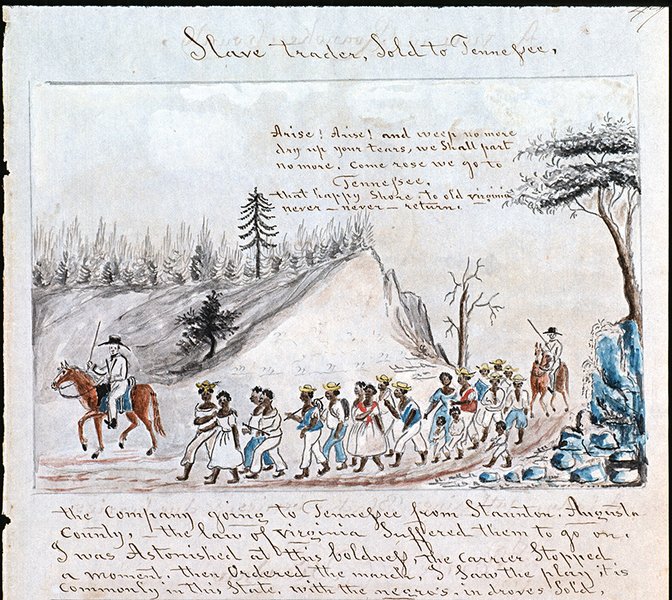 A coffle of slaves being driven on foot from Staunton, Virginia to Tennessee in 1850. Slavery in the United States was the legal institution of human chattel enslavement, primarily of Africans and African Americans, that existed in the United States of America in the 18th and 19th centuries, after it gained independence from the British and before the end of the American Civil War. Slavery had been practiced in British America from early colonial days and was legal in all Thirteen Colonies, at the time of the Declaration of Independence in 1776. By the time of the American Revolution, the status of slave had been institutionalized as a racial caste associated with African ancestry.[153] The United States became polarized over the issue of slavery, represented by the slave and free states divided by the Mason–Dixon line, which separated free Pennsylvania from slave Maryland and Delaware. Congress, during the Jefferson administration, prohibited the importation of slaves, effective 1808, although smuggling (illegal importing) was not unusual.[154] Domestic slave trading, however, continued at a rapid pace, driven by labour demands from the development of cotton plantations in the Deep South. Those states attempted to extend slavery into the new western territories to keep their share of political power in the nation. Such laws proposed to Congress to continue the spread of slavery into newly ratified states include the Kansas-Nebraska Act. The treatment of slaves in the United States varied widely depending on conditions, times, and places. The power relationships of slavery corrupted many whites who had authority over slaves, with children showing their own cruelty. Masters and overseers resorted to physical punishments to impose their wills. Slaves were punished by whipping, shackling, hanging, beating, burning, mutilation, branding and imprisonment. Punishment was most often meted out in response to disobedience or perceived infractions, but sometimes abuse was carried out to re-assert the dominance of the master or overseer of the slave.[155] Treatment was usually harsher on large plantations, which were often managed by overseers and owned by absentee slaveholders. William Wells Brown, who escaped to freedom, reported that on one plantation, slave men were required to pick 80 pounds (36 kg) of cotton per day, while women were required to pick 70 pounds (32 kg) per day; if any slave failed in their quota, they were subject to whip lashes for each pound they were short. The whipping post stood next to the cotton scales.[156] A New York man who attended a slave auction in the mid-19th century reported that at least three-quarters of the male slaves he saw at sale had scars on their backs from whipping.[157] By contrast, small slave-owning families had closer relationships between the owners and slaves; this sometimes resulted in a more humane environment but was not a given.[155] More than one million slaves were sold from the Upper South, which had a surplus of labour, and taken to the Deep South in a forced migration, splitting up many families. New communities of African American culture were developed in the Deep South, and the total slave population in the South eventually reached 4 million before liberation.[158][159] In the 19th century, proponents of slavery often defended the institution as a "necessary evil". White people of that time feared that emancipation of black slaves would have more harmful social and economic consequences than the continuation of slavery. The French writer and traveler Alexis de Tocqueville, in Democracy in America (1835), expressed opposition to slavery while observing its effects on American society. He felt that a multiracial society without slavery was untenable, as he believed that prejudice against black people increased as they were granted more rights. Others, like James Henry Hammond argued that slavery was a "positive good" stating: "Such a class you must have, or you would not have that other class which leads progress, civilization, and refinement." The Southern state governments wanted to keep a balance between the number of slave and free states to maintain a political balance of power in Congress. The new territories acquired from Britain, France, and Mexico were the subject of major political compromises. By 1850, the newly rich cotton-growing South was threatening to secede from the Union, and tensions continued to rise. Many white Southern Christians, including church ministers, attempted to justify their support for slavery as modified by Christian paternalism.[160] The largest denominations, the Baptist, Methodist, and Presbyterian churches, split over the slavery issue into regional organizations of the North and South. ++++++++++++++++++++++++ 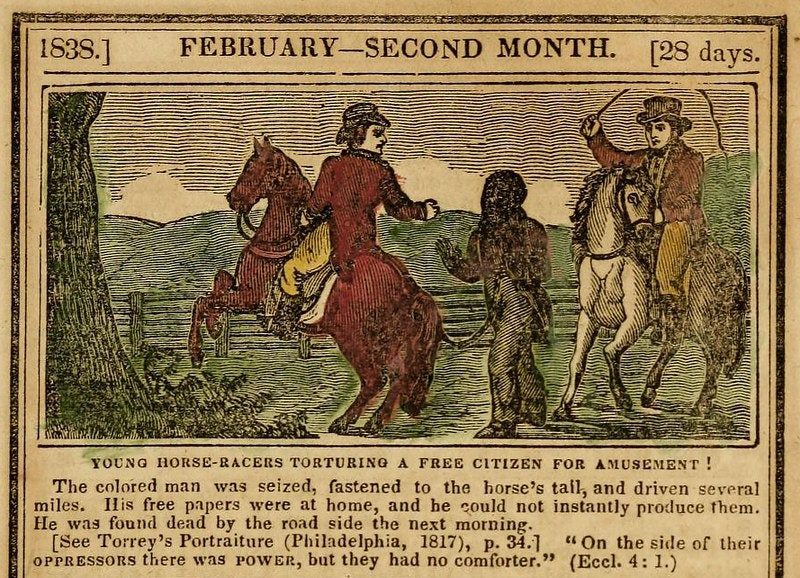 First published in 1836 by the American Anti-Slavery Society, the American Anti-Slavery Almanac was an attempt to bring awareness about slavery to 19th-century America: ++++++++++++++++++++++++ 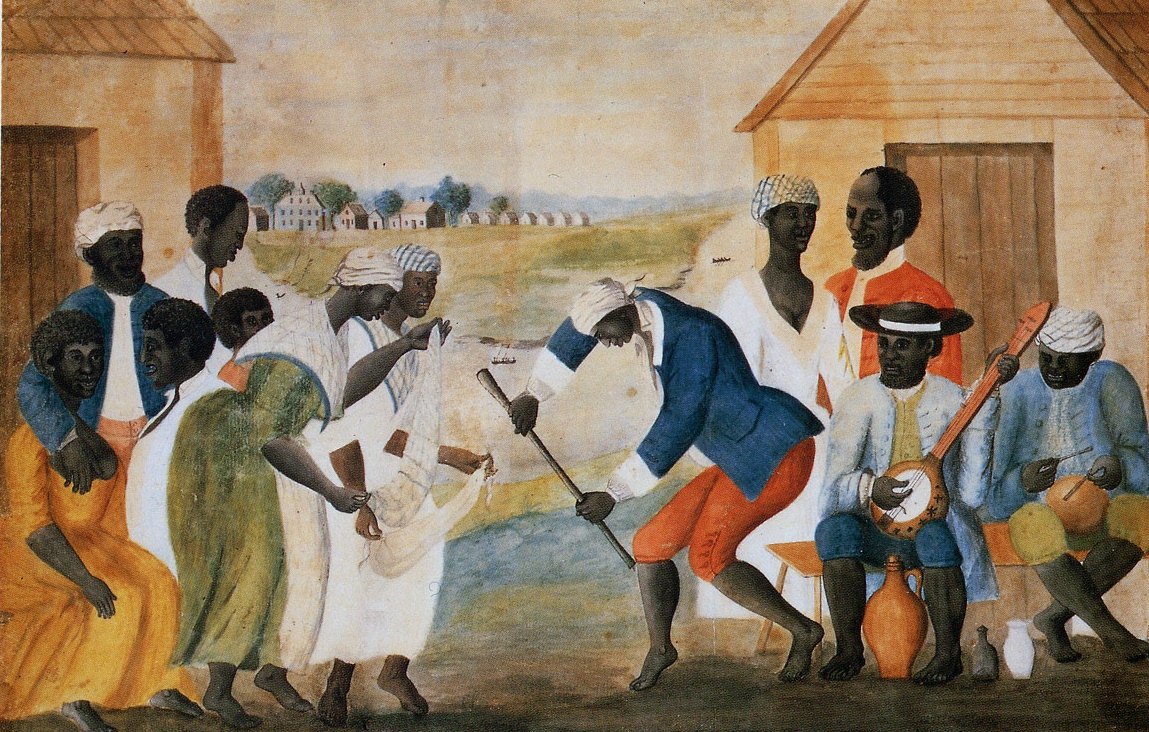 Slaves on a Virginia plantation (The Old Plantation, c. 1790). When Abraham Lincoln won the 1860 election on a platform of halting the expansion of slavery, according to the 1860 U.S. census, roughly 400,000 individuals, representing 8% of all U.S. families, owned nearly 4,000,000 slaves.[161] One-third of Southern families owned slaves.[162] The South was heavily invested in slavery. As such, upon Lincoln's election, seven states broke away to form the Confederate States of America. The first six states to secede held the greatest number of slaves in the South. Shortly after, over the issue of slavery, the United States erupted into an all-out Civil War, with slavery legally ceasing as an institution following the war in December 1865. In 1865, the United States ratified the 13th Amendment to the United States Constitution, which banned slavery and involuntary servitude "except as punishment for a crime whereof the party shall have been duly convicted," providing a legal basis for forced labor to continue in the country. This led to the system of convict leasing, which affected primarily African Americans. The Prison Policy Initiative, an American criminal justice think tank, cites the 2020 US prison population as 2.3 million, and nearly all able-bodied inmates work in some fashion. In Texas, Georgia, Alabama and Arkansas, prisoners are not paid at all for their work. In other states, prisoners are paid between $0.12 and $1.15 per hour. Federal Prison Industries paid inmates an average of $0.90 per hour in 2017. Inmates who refuse to work may be indefinitely remanded into solitary confinement or have family visitation revoked. From 2010 to 2015 and again in 2016 and in 2018, some prisoners in the US refused to work, protesting for better pay, better conditions, and for the end of forced labor. Strike leaders were punished with indefinite solitary confinement. Forced prison labor occurs in both government-run prisons and private prisons. CoreCivic and GEO Group constitute half the market share of private prisons, and they made a combined revenue of $3.5 billion in 2015. The value of all labor by inmates in the United States is estimated to be in the billions. In California, 2,500 incarcerated workers fought wildfires for only $1 per hour through the CDCR's Conservation Camp Program, which saves the state as much as $100 million a year.[163] Asia-Pacific See also: History of slavery in Asia East Asia 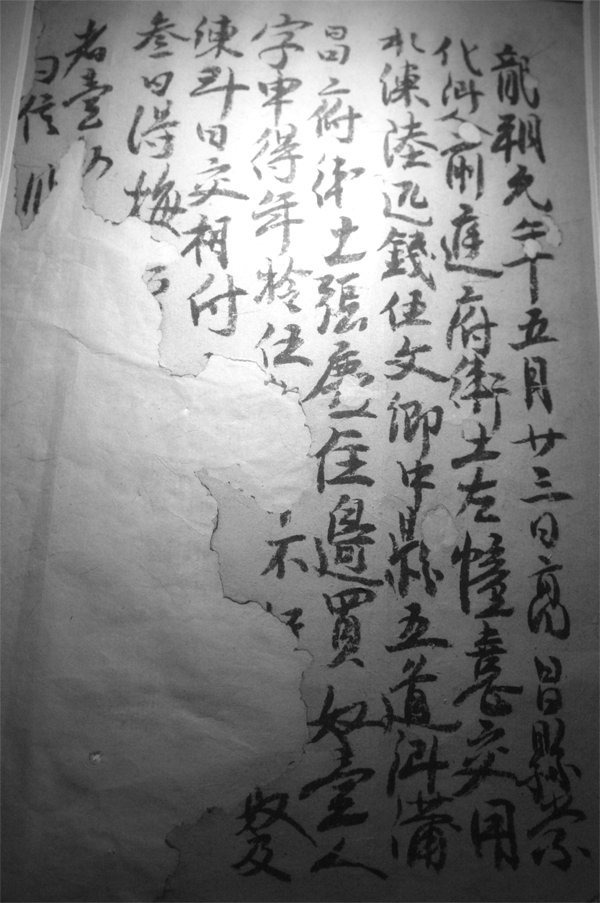 A contract from the Tang dynasty recording the purchase of a 15-year-old slave for six bolts of plain silk and five coins. See also: Slavery in China Slavery existed in ancient China as early as the Shang dynasty.[164] Slavery was employed largely by governments as a means of maintaining a public labour force.[165][166] Many Han Chinese were enslaved in the process of the Mongol invasion of China proper.[167] According to Japanese historians Sugiyama Masaaki (杉山正明) and Funada Yoshiyuki (舩田善之), Mongolian slaves were owned by Han Chinese during the Yuan dynasty.[168][169] Slavery has taken various forms throughout China's history. It was reportedly abolished as a legally recognized institution, including in a 1909 law[170][171] fully enacted in 1910,[172] although the practice continued until at least 1949.[167] Tang Chinese soldiers and pirates enslaved Koreans, Turks, Persians, Indonesians, and people from Inner Mongolia, central Asia, and northern India.[173][174] The greatest source of slaves came from southern tribes, including Thais and aboriginals from the southern provinces of Fujian, Guangdong, Guangxi, and Guizhou. Malays, Khmers, Indians, and "black skinned" peoples (who were either Austronesian Negritos of Southeast Asia and the Pacific Islands, or Africans, or both) were also purchased as slaves in the Tang dynasty.[175] In the 17th century Qing dynasty, there was a hereditarily servile people called Booi Aha (Manchu: booi niyalma; Chinese transliteration: 包衣阿哈), which is a Manchu word literally translated as "household person" and sometimes rendered as "nucai." The Manchu was establishing close personal and paternalist relationship between masters and their slaves, as Nurhachi said, "The Master should love the slaves and eat the same food as him".[176] However, booi aha "did not correspond exactly to the Chinese category of "bond-servant slave" (Chinese:奴僕); instead, it was a relationship of personal dependency on a master which in theory guaranteed close personal relationships and equal treatment, even though many western scholars would directly translate "booi" as "bond-servant" (some of the "booi" even had their own servant).[167] Chinese Muslim (Tungans) Sufis who were charged with practicing xiejiao (heterodox religion), were punished by exile to Xinjiang and being sold as a slave to other Muslims, such as the Sufi begs.[177] Han Chinese who committed crimes such as those dealing with opium became slaves to the begs, this practice was administered by Qing law.[178] Most Chinese in Altishahr were exile slaves to Turkestani Begs.[179] While free Chinese merchants generally did not engage in relationships with East Turkestani women, some of the Chinese slaves belonging to begs, along with Green Standard soldiers, Bannermen, and Manchus, engaged in affairs with the East Turkestani women that were serious in nature.[180] 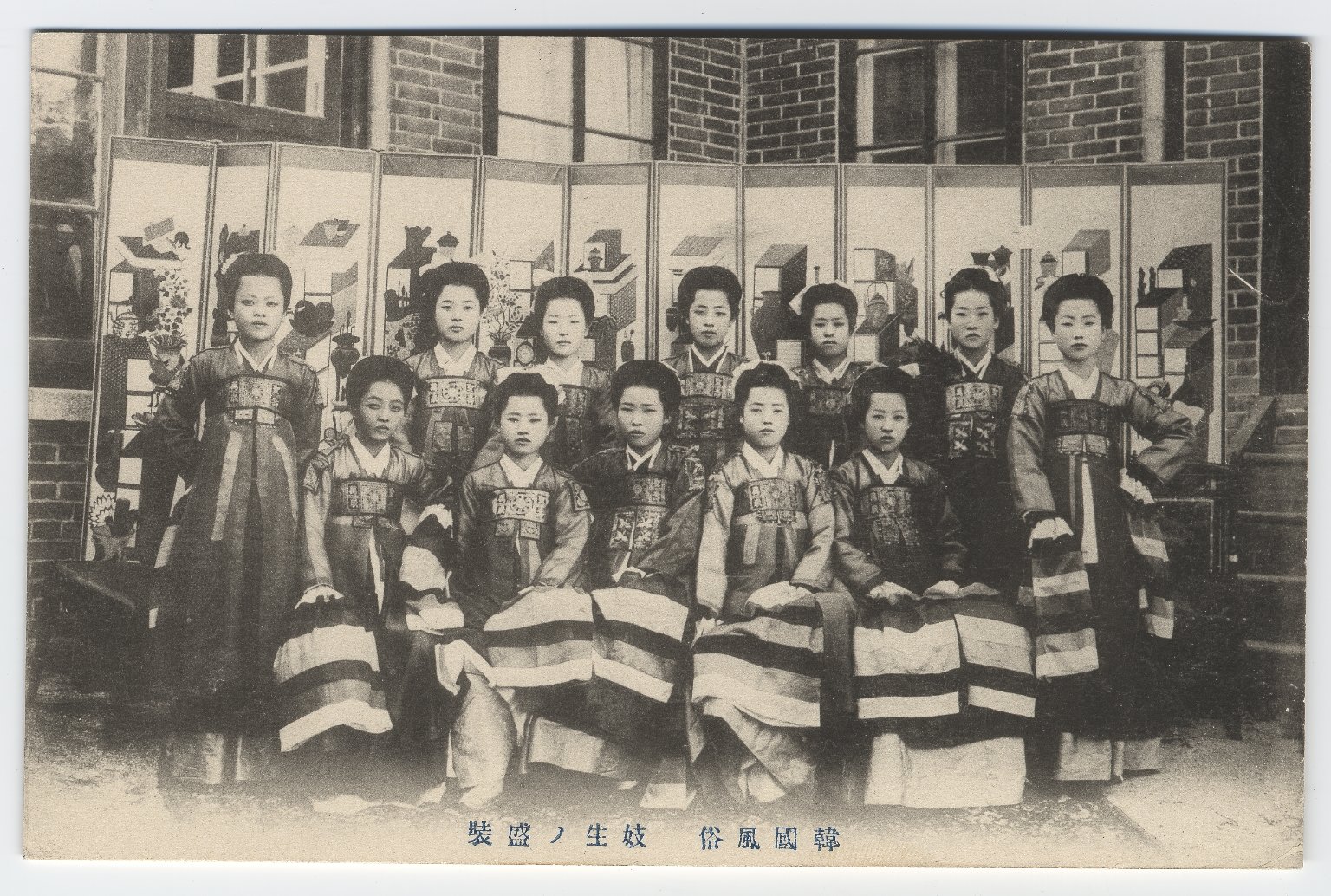 Kisaeng, women from outcast or slave families who were trained to provide entertainment, conversation, and sexual services to men of the upper class. Slavery in Korea existed since before the Three Kingdoms of Korea period, in the first century BCE.[181] Slavery has been described as "very important in medieval Korea, probably more important than in any other East Asian country, but by the 16th century, population growth was making [it] unnecessary".[182] Slavery went into decline around the 10th century but came back in the late Goryeo period when Korea also experienced multiple slave rebellions.[181] In the Joseon period of Korea, members of the slave class were known as nobi. The nobi were socially indistinct from freemen (i.e., the middle and common classes) other than the ruling yangban class, and some possessed property rights, and legal and civil rights. Hence, some scholars argue that it is inappropriate to call them "slaves",[183] while some scholars describe them as serfs.[184][185] The nobi population could fluctuate up to about one-third of the total, but on average the nobi made up about 10% of the total population.[181] In 1801, the majority of government nobi were emancipated,[186] and by 1858, the nobi population stood at about 1.5 percent of the Korean population.[187] During the Joseon period, the nobi population could fluctuate up to about one-third of the population, but on average the nobi made up about 10% of the total population.[181] The nobi system declined beginning in the 18th century.[188] Since the outset of the Joseon dynasty and especially beginning in the 17th century, there was harsh criticism among prominent thinkers in Korea about the nobi system. Even within the Joseon government, there were indications of a shift in attitude toward the nobi.[189] King Yeongjo implemented a policy of gradual emancipation in 1775,[182] and he and his successor King Jeongjo made many proposals and developments that lessened the burden on nobi, which led to the emancipation of the vast majority of government nobi in 1801.[189] In addition, population growth,[182] numerous escaped slaves,[181] growing commercialization of agriculture, and the rise of the independent small farmer class contributed to the decline in the number of nobi to about 1.5% of the total population by 1858.[187] The hereditary nobi system was officially abolished around 1886–87,[181][187] and the rest of the nobi system was abolished with the Gabo Reform of 1894.[181][190] However, slavery did not completely disappear in Korea until 1930, during Imperial Japanese rule. During the Imperial Japanese occupation of Korea around World War II, some Koreans were used in forced labour by the Imperial Japanese, in conditions which have been compared to slavery.[181][191] These included women forced into sexual slavery by the Imperial Japanese Army before and during World War II, known as "comfort women".[181][191] After the Portuguese first made contact with Japan in 1543, slave trade developed in which Portuguese purchased Japanese as slaves in Japan and sold them to various locations overseas, including Portugal, throughout the 16th and 17th centuries.[192][193] Many documents mention the slave trade along with protests against the enslavement of Japanese. Japanese slaves are believed to be the first of their nation to end up in Europe, and the Portuguese purchased numbers of Japanese slave girls to bring to Portugal for sexual purposes, as noted by the Church[194] in 1555. Japanese slave women were even sold as concubines to Asian lascar and African crew members, along with their European counterparts serving on Portuguese ships trading in Japan, mentioned by Luis Cerqueira, a Portuguese Jesuit, in a 1598 document.[195] Japanese slaves were brought by the Portuguese to Macau, where they were enslaved to Portuguese or became slaves to other slaves.[196][197] Some Korean slaves were bought by the Portuguese and brought back to Portugal from Japan, where they had been among the tens of thousands of Korean prisoners of war transported to Japan during the Japanese invasions of Korea (1592–98).[198][199] Historians pointed out that at the same time Hideyoshi expressed his indignation and outrage at the Portuguese trade in Japanese slaves, he was engaging in a mass slave trade of Korean prisoners of war in Japan.[200][201] Fillippo Sassetti saw some Chinese and Japanese slaves in Lisbon among the large slave community in 1578, although most of the slaves were black.[202][203][204][205][206] The Portuguese also valued Oriental slaves more than the black Africans and the Moors for their rarity. Chinese slaves were more expensive than Moors and blacks and showed off the high status of the owner.[207] The Portuguese attributed qualities like intelligence and industriousness to Chinese, Japanese and Indian slaves.[208][204] King Sebastian of Portugal feared rampant slavery was having a negative effect on Catholic proselytization, so he commanded that it be banned in 1571.[209] Hideyoshi was so disgusted that his own Japanese people were being sold en masse into slavery on Kyushu, that he wrote a letter to Jesuit Vice-Provincial Gaspar Coelho on July 24, 1587, to demand the Portuguese, Siamese (Thai), and Cambodians stop purchasing and enslaving Japanese and return Japanese slaves who ended up as far as India.[210][211][212] Hideyoshi blamed the Portuguese and Jesuits for this slave trade and banned Christian proselytizing as a result.[213][self-published source][214] In 1595, a law was passed by Portugal banning the selling and buying of Chinese and Japanese slaves.[215] South Asia Slavery in India was widespread by the 6th century BC, and perhaps even as far back as the Vedic period.[216] Slavery intensified during the Muslim domination of northern India after the 11th-century.[217] Slavery existed in Portuguese India after the 16th century. The Dutch, too, largely dealt in Abyssian slaves, known in India as Habshis or Sheedes.[218] Arakan/Bengal, Malabar, and Coromandel remained the largest sources of forced labour until the 1660s. Between 1626 and 1662, the Dutch exported on an average 150–400 slaves annually from the Arakan-Bengal coast. During the first 30 years of Batavia's existence, Indian and Arakanese slaves provided the main labour force of the Dutch East India Company, Asian headquarters. An increase in Coromandel slaves occurred during a famine following the revolt of the Nayaka Indian rulers of South India (Tanjavur, Senji, and Madurai) against Bijapur overlordship (1645) and the subsequent devastation of the Tanjavur countryside by the Bijapur army. Reportedly, more than 150,000 people were taken by the invading Deccani Muslim armies to Bijapur and Golconda. In 1646, 2,118 slaves were exported to Batavia, the overwhelming majority from southern Coromandel. Some slaves were also acquired further south at Tondi, Adirampatnam, and Kayalpatnam. Another increase in slaving took place between 1659 and 1661 from Tanjavur as a result of a series of successive Bijapuri raids. At Nagapatnam, Pulicat, and elsewhere, the company purchased 8,000–10,000 slaves, the bulk of whom were sent to Ceylon, while a small portion were exported to Batavia and Malacca. Finally, following a long drought in Madurai and southern Coromandel, in 1673, which intensified the prolonged Madurai-Maratha struggle over Tanjavur and punitive fiscal practices, thousands of people from Tanjavur, mostly children, were sold into slavery and exported by Asian traders from Nagapattinam to Aceh, Johor, and other slave markets. In September 1687, 665 slaves were exported by the English from Fort St. George, Madras. And, in 1694–96, when warfare once more ravaged South India, a total of 3,859 slaves were imported from Coromandel by private individuals into Ceylon.[219][220][221][222] The volume of the total Dutch Indian Ocean slave trade has been estimated to be about 15–30% of the Atlantic slave trade, slightly smaller than the trans-Saharan slave trade, and one-and-a-half to three times the size of the Swahili and Red Sea coast and the Dutch West India Company slave trades.[223] According to Sir Henry Bartle Frere (who sat on the Viceroy's Council), there were an estimated 8 or 9 million slaves in India in 1841. About 15% of the population of Malabar were slaves. Slavery was legally abolished in the possessions of the East India Company by the Indian Slavery Act, 1843.[3] South East Asia The hill tribe people in Indochina were "hunted incessantly and carried off as slaves by the Siamese (Thai), the Anamites (Vietnamese), and the Cambodians".[224] A Siamese military campaign in Laos in 1876 was described by a British observer as having been "transformed into slave-hunting raids on a large scale".[224] The census, taken in 1879, showed that 6% of the population in the Malay sultanate of Perak were slaves.[225] Enslaved people made up about two-thirds of the population in part of North Borneo in the 1880s.[225] Oceania Slaves (he mōkai) had a recognised social role in traditional Māori society in New Zealand.[226] Blackbirding occurred on islands in the Pacific Ocean and Australia, especially in the 19th century. Europe Ancient Greece and Rome Main articles: Slavery in ancient Greece, Slavery in ancient Rome, and Black Sea slave trade 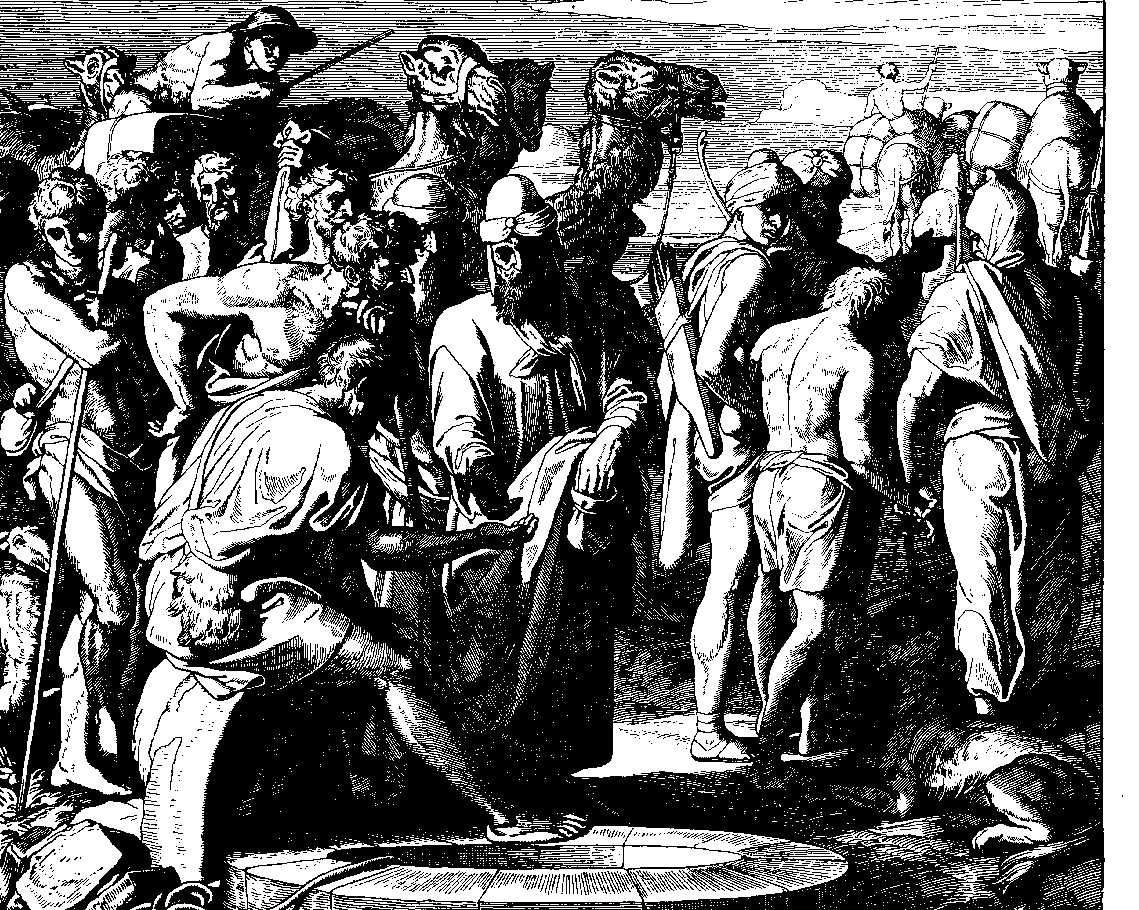 Ishmaelites purchase Joseph, by Schnorr von Carolsfeld, 1860 Records of slavery in Ancient Greece begin with Mycenaean Greece. Classical Athens had the largest slave population, with as many as 80,000 in the 6th and 5th centuries BC.[227] As the Roman Republic expanded outward, entire populations were enslaved, across Europe and the Mediterranean. Slaves were used for labour, as well as for amusement (e.g., gladiators and sex slaves). This oppression by an elite minority eventually led to slave revolts (see Roman Servile Wars); the Third Servile War was led by Spartacus. By the late Republican era, slavery had become an economic pillar of Roman wealth, as well as Roman society.[228] It is estimated that 25% or more of the population of Ancient Rome was enslaved, although the actual percentage is debated by scholars and varied from region to region.[229][230] Slaves represented 15–25% of Italy's population,[231] mostly war captives,[231] especially from Gaul[232] and Epirus. Estimates of the number of slaves in the Roman Empire suggest that the majority were scattered throughout the provinces outside of Italy.[231] Generally, slaves in Italy were indigenous Italians.[233] Foreigners (including both slaves and freedmen) born outside of Italy were estimated to have peaked at 5% of the total in the capital, where their number was largest. Those from outside of Europe were predominantly of Greek descent. Jewish slaves never fully assimilated into Roman society, remaining an identifiable minority. These slaves (especially the foreigners) had higher death rates and lower birth rates than natives and were sometimes subjected to mass expulsions.[234] The average recorded age at death for the slaves in Rome was seventeen and a half years (17.2 for males; 17.9 for females).[235] Medieval and early modern Europe Main articles: Balkan slave trade, Barbary slave trade, Crimean slave trade, and Slavery in the Byzantine Empire 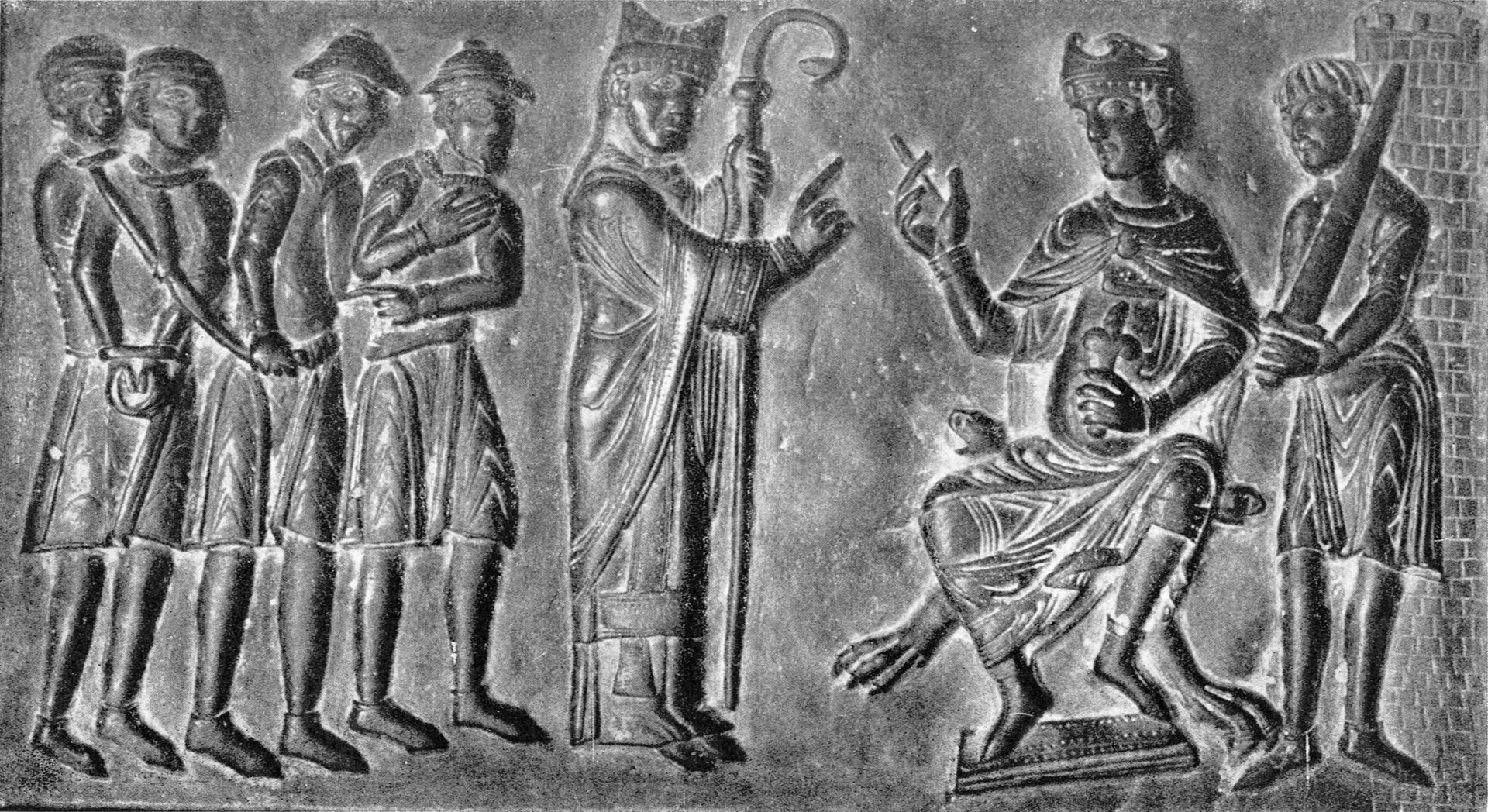 Adalbert of Prague pleads with Boleslaus II, Duke of Bohemia for the release of slaves Slavery in early medieval Europe was so common that the Catholic Church repeatedly prohibited it, or at least the export of Christian slaves to non-Christian lands, as for example at the Council of Koblenz (922), the Council of London (1102) (which aimed mainly at the sale of English slaves to Ireland)[236] and the Council of Armagh (1171). Serfdom, on the contrary, was widely accepted. In 1452, Pope Nicholas V issued the papal bull Dum Diversas, granting the kings of Spain and Portugal the right to reduce any "Saracens (Muslims), pagans and any other unbelievers" to perpetual slavery, legitimizing the slave trade as a result of war.[237] The approval of slavery under these conditions was reaffirmed and extended in his Romanus Pontifex bull of 1455. Large-scale trading in slaves was mainly confined to the South and East of early medieval Europe: the Byzantine Empire and the Muslim world were the destinations, while pagan Central and Eastern Europe (along with the Caucasus and Tartary) were important sources. Viking, Arab, Greek, and Radhanite Jewish merchants were all involved in the slave trade during the Early Middle Ages.[238][239][240] The trade in European slaves reached a peak in the 10th century following the Zanj Rebellion which dampened the use of African slaves in the Arab world.[241][242] In Britain, slavery continued to be practiced following the fall of Rome, while sections of Æthelstan's and Hywel the Good's laws dealt with slaves in medieval England and medieval Wales respectively.[243][244] The trade particularly picked up after the Viking invasions, with major markets at Chester[245] and Bristol[246] supplied by Danish, Mercian, and Welsh raiding of one another's borderlands. At the time of the Domesday Book, nearly 10% of the English population were slaves.[247] William the Conqueror introduced a law preventing the sale of slaves overseas.[248] According to historian John Gillingham, by 1200 slavery in the British Isles was non-existent.[249] Slavery had never been authorized by statute within England and Wales, and in 1772, in the case Somerset v Stewart, Lord Mansfield declared that it was also unsupported within England by the common law. The slave trade was abolished by the Slave Trade Act 1807, although slavery remained legal in possessions outside Europe until the passage of the Slavery Abolition Act 1833 and the Indian Slavery Act, 1843.[250] However, when England began to have colonies in the Americas, and particularly from the 1640s, African slaves began to make their appearance in England and remained a presence until the eighteenth century. In Scotland, slaves continued to be sold as chattels until late in the eighteenth century (on the second May 1722, an advertisement appeared in the Edinburgh Evening Courant, announcing that a stolen slave had been found, who would be sold to pay expenses, unless claimed within two weeks).[251] For nearly two hundred years in the history of coal mining in Scotland, miners were bonded to their "maisters" by a 1606 Act "Anent Coalyers and Salters". The Colliers and Salters (Scotland) Act 1775 stated that "many colliers and salters are in a state of slavery and bondage" and announced emancipation; those starting work after July 1, 1775, would not become slaves, while those already in a state of slavery could, after 7 or 10 years depending on their age, apply for a decree of the Sheriff's Court granting their freedom. Few could afford this, until a further law in 1799 established their freedom and made this slavery and bondage illegal.[251][252] 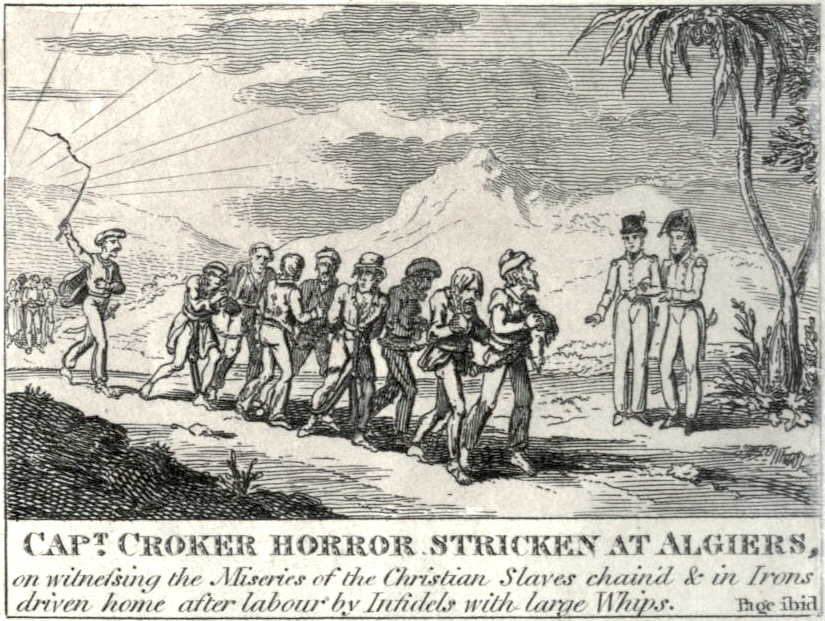 A British captain witnessing the miseries of slaves in Ottoman Algeria, 1815 The Byzantine-Ottoman wars and the Ottoman wars in Europe brought large numbers of slaves into the Islamic world.[253] To staff its bureaucracy, the Ottoman Empire established a janissary system which seized hundreds of thousands of Christian boys through the devşirme system. They were well cared for but were legally slaves owned by the government and were not allowed to marry. They were never bought or sold. The empire gave them significant administrative and military roles. The system began about 1365; there were 135,000 janissaries in 1826, when the system ended.[254] After the Battle of Lepanto, 12,000 Christian galley slaves were recaptured and freed from the Ottoman fleet.[255] Eastern Europe suffered a series of Tatar invasions, the goal of which was to loot and capture slaves for selling them to Ottomans as jasyr.[256] Seventy-five Crimean Tatar raids were recorded into Poland–Lithuania between 1474 and 1569.[257] 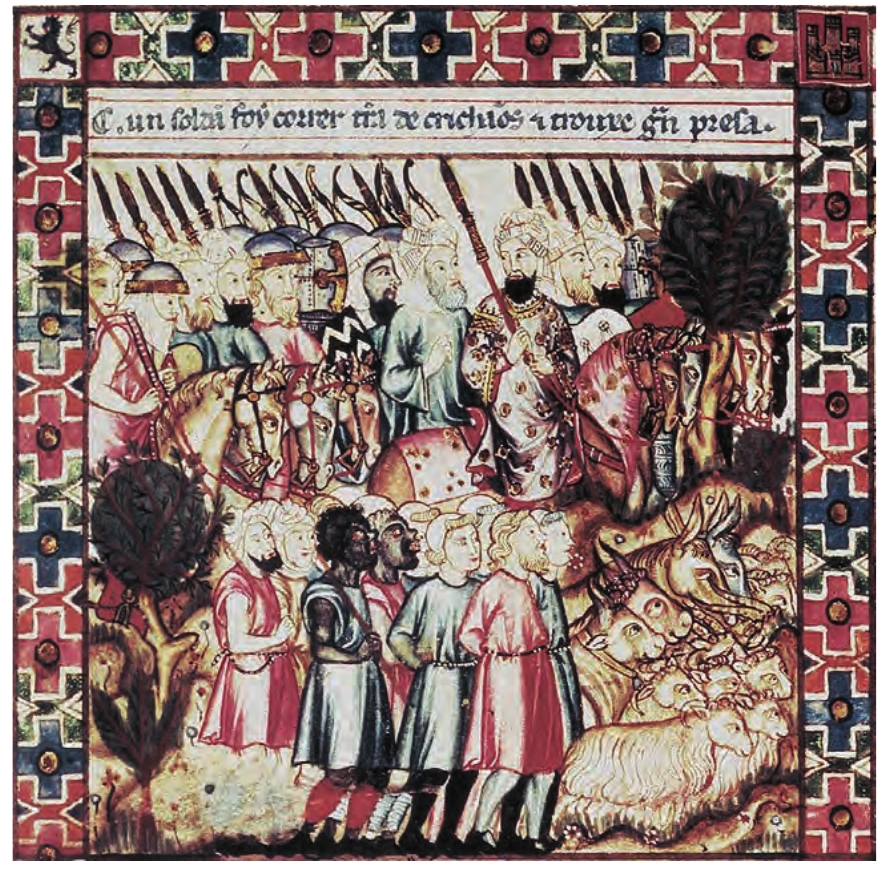 Slavic and African slaves in Córdoba, illustration from Cantigas de Santa Maria, 13th Century Medieval Spain and Portugal were the scene of almost constant Muslim invasion of the predominantly Christian area. Periodic raiding expeditions were sent from Al-Andalus to ravage the Iberian Christian kingdoms, bringing back booty and slaves. In a raid against Lisbon in 1189, for example, the Almohad caliph Yaqub al-Mansur took 3,000 female and child captives, while his governor of Córdoba, in a subsequent attack upon Silves, Portugal, in 1191, took 3,000 Christian slaves.[258] From the 11th to the 19th century, North African Barbary Pirates engaged in raids on European coastal towns to capture Christian slaves to sell at slave markets in places such as Algeria and Morocco.[259] The maritime town of Lagos was the first slave market created in Portugal (one of the earliest colonizers of the Americas) for the sale of imported African slaves – the Mercado de Escravos, opened in 1444.[260][261] In 1441, the first slaves were brought to Portugal from northern Mauritania.[261] By 1552, black African slaves made up 10% of the population of Lisbon.[262][263] In the second half of the 16th century, the Crown gave up the monopoly on slave trade, and the focus of European trade in African slaves shifted from import to Europe to slave transports directly to tropical colonies in the Americas – especially Brazil.[261] In the 15th century one-third of the slaves were resold to the African market in exchange of gold.[264] Until the late 18th century, the Crimean Khanate (a Muslim Tatar state) maintained a massive slave trade with the Ottoman Empire and the Middle East.[256] The slaves were captured in southern Russia, Poland-Lithuania, Moldavia, Wallachia, and Circassia by Tatar horsemen[265] and sold in the Crimean port of Kaffa.[266] About 2 million mostly Christian slaves were exported over the 16th and 17th centuries[267] until the Crimean Khanate was destroyed by the Russian Empire in 1783.[268] 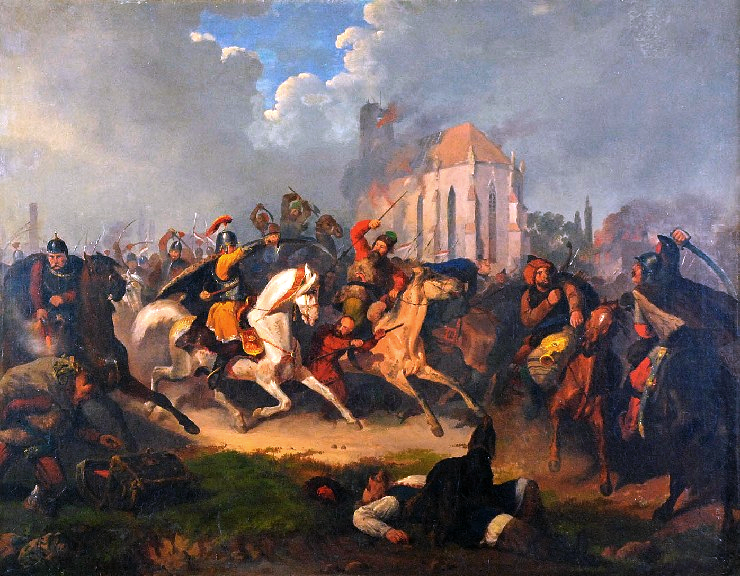 Crimean Tatar raiders enslaved more than 1 million Eastern Europeans.[269] In Kievan Rus and Muscovy, slaves were usually classified as kholops. According to David P. Forsythe, "In 1649 up to three-quarters of Muscovy's peasants, or 13 to 14 million people, were serfs whose material lives were barely distinguishable from slaves. Perhaps another 1.5 million were formally enslaved, with Russian slaves serving Russian masters."[270] Slavery remained a major institution in Russia until 1723, when Peter the Great converted the household slaves into house serfs. Russian agricultural slaves were formally converted into serfs earlier in 1679.[271] Slavery in Poland was forbidden in the 15th century; in Lithuania, slavery was formally abolished in 1588; they were replaced by the second serfdom. In Scandinavia, thralldom was abolished in the mid-14th century.[272] World War II 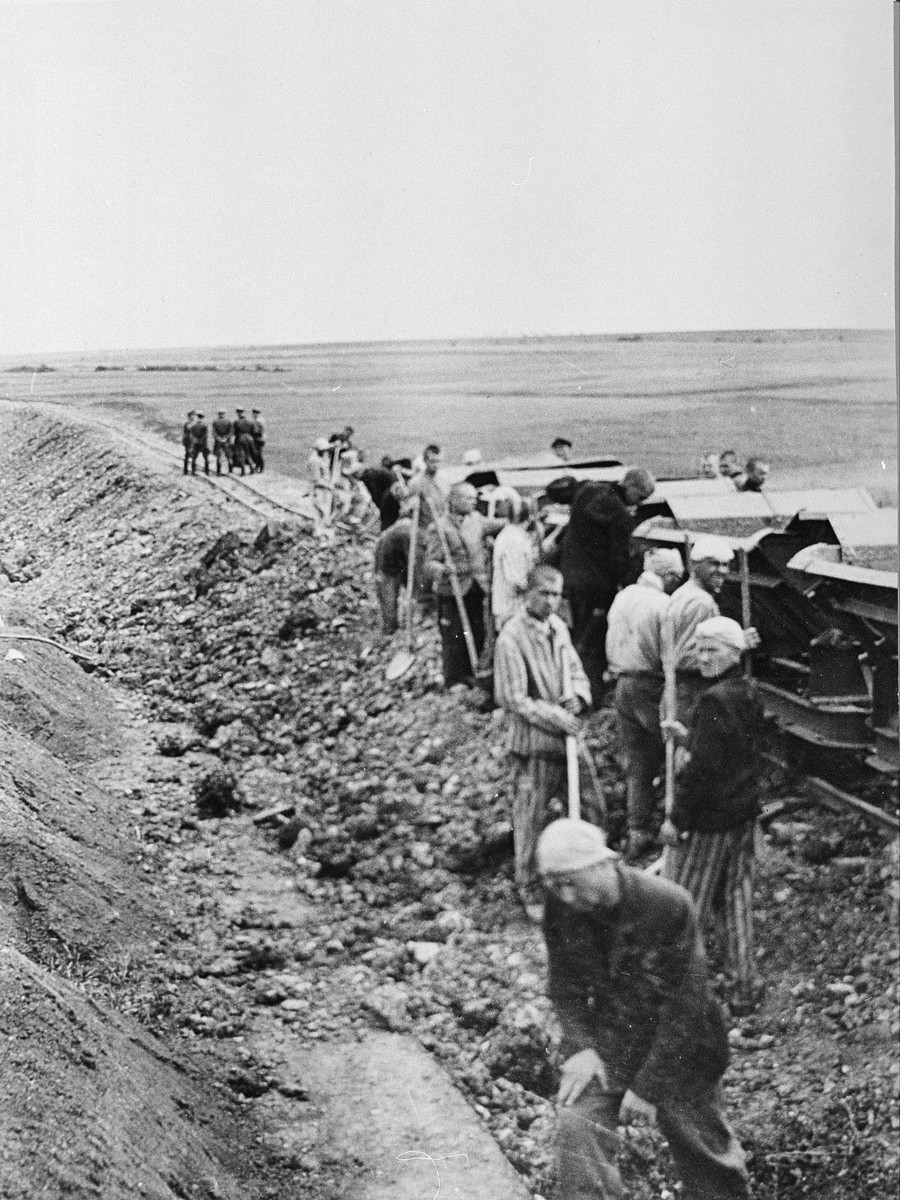 Prisoners forced to work on the Buchenwald–Weimar rail line, 1943 Main article: Forced labour under German rule during World War II During the Second World War, Nazi Germany effectively enslaved about 12 million people, both those considered undesirable and citizens of conquered countries, with the avowed intention of treating these Untermenschen (sub-humans) as a permanent slave-class of inferior beings who could be worked until they died, and who possessed neither the rights nor the legal status of members of the Aryan race.[273] Besides Jews, the harshest deportation and forced labour policies were applied to the populations of Poland,[274] Belarus, Ukraine, and Russia. By the end of the war, half of Belarus' population had been killed or deported.[275][276] Communist states Main article: Gulag 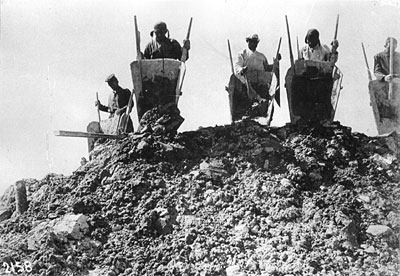 Workers being forced to haul rocks up a hill in a Gulag Between 1930 and 1960, the Soviet Union created a system of, according to Anne Applebaum and the "perspective of the Kremlin", slave labor camps called the Gulag (Russian: ГУЛаг, romanized: GULag).[277] Prisoners in these camps were worked to death by a combination of extreme production quotas, physical and psychological brutality, hunger, lack of medical care, and the harsh environment. Aleksandr Solzhenitsyn, who survived eight years of Gulag incarceration, provided firsthand testimony about the camps with the publication of The Gulag Archipelago, after which he was awarded the Nobel Prize in Literature.[278][279] Fatality rate was as high as 80% during the first months in many camps. Hundreds of thousands of people, possibly millions, died as a direct result of forced labour under the Soviets.[280] Golfo Alexopoulos suggests comparing labor in the Gulag with "other forms of slave labor" and notes its "violence of human exploitation" in Illness and Inhumanity in Stalin's Gulag:[281] Stalin's Gulag was, in many ways, less a concentration camp than a forced labor camp and less a prison system than a system of slavery. The image of the slave appears often in Gulag memoir literature. As Varlam Shalamov wrote: "Hungry and exhausted, we leaned into a horse collar, raising blood blisters on our chests and pulling a stone-filled cart up the slanted mine floor. The collar was the same device used long ago by the ancient Egyptians." Thoughtful and rigorous historical comparisons of Soviet forced labor and other forms of slave labor would be worthy of scholarly attention, in my view. For as in the case of global slavery, the Gulag found legitimacy in an elaborate narrative of difference that involved the presumption of dangerousness and guilt. This ideology of difference and the violence of human exploitation have left lasting legacies in contemporary Russia. Historian Anne Applebaum writes in the introduction of her book that the word GULAG has come to represent "the system of Soviet slave labor itself, in all its forms and varieties":[282] The word "GULAG" is an acronym for Glavnoe Upravlenie Lagerei, or Main Camp Administration, the institution which ran the Soviet camps. But over time, the word has also come to signify the system of Soviet slave labor itself, in all its forms and varieties: labor camps, punishment camps, criminal and political camps, women's camps, children's camps, transit camps. Even more broadly, "Gulag" has come to mean the Soviet repressive system itself, the set of procedures that Alexander Solzhenitsyn once called "our meat grinder": the arrests, the interrogations, the transport in unheated cattle cars, the forced labor, the destruction of families, the years spent in exile, the early and unnecessary deaths. Applebaum's introduction has been criticized by Gulag researcher Wilson Bell,[283] stating that her book "is, aside from the introduction, a well-done overview of the Gulag, but it did not offer an interpretative framework much beyond Solzhenitsyn's paradigms".[284] Middle East See also: Slavery in Egypt and Slavery in the Ottoman Empire 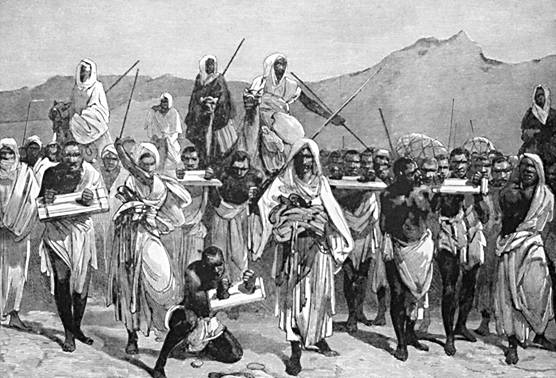 19th-century engraving depicting an Arab slave-trading caravan transporting black African slaves across the Sahara Desert. In the earliest known records, slavery is treated as an established institution. The Code of Hammurabi (c. 1760 BC), for example, prescribed death for anyone who helped a slave escape or who sheltered a fugitive.[285] The Bible mentions slavery as an established institution.[3] Slavery existed in Pharaonic Egypt, but studying it is complicated by terminology used by the Egyptians to refer to different classes of servitude over the course of history. Interpretation of the textual evidence of classes of slaves in ancient Egypt has been difficult to differentiate by word usage alone.[286][287] The three apparent types of enslavement in Ancient Egypt: chattel slavery, bonded labour, and forced labour.[288][289][290] As recently as the early 1960s, Saudi Arabia's slave population was estimated at 300,000.[291] Along with Yemen, the Saudis abolished slavery in 1962.[292] Historically, slaves in the Arab World came from many different regions, including Sub-Saharan Africa (mainly Zanj),[293] the Caucasus (mainly Circassians),[294] Central Asia (mainly Tartars), and Central and Eastern Europe (mainly Slavs Saqaliba).[295] 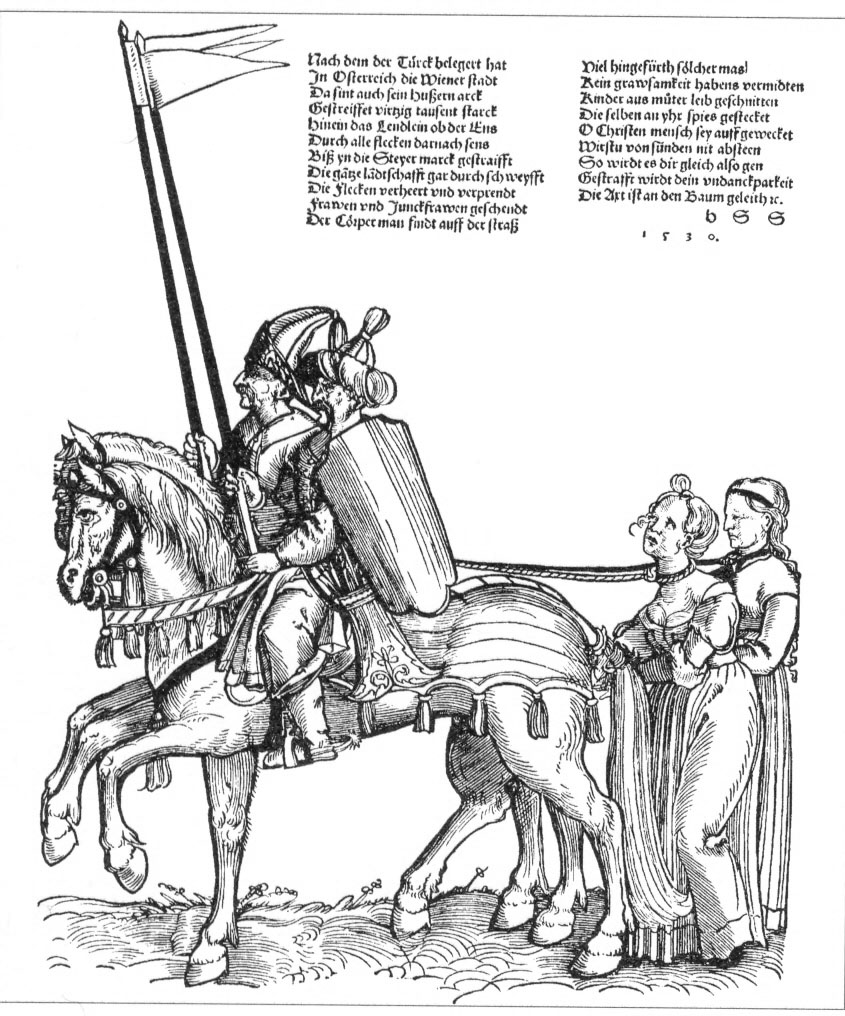 Ottoman wars saw Europeans dragged to that empire In Constantinople, about one-fifth of the population consisted of slaves.[78] The city was a major centre of the slave trade in the 15th and later centuries. Slaves were provided by Tatar raids on Slavic villages[296] but also by conquest and the suppression of rebellions, in the aftermath of which entire populations were sometimes enslaved and sold across the Empire, reducing the risk of future rebellion. The Ottomans also purchased slaves from traders who brought slaves into the Empire from Europe and Africa. It has been estimated that some 200,000 slaves – mainly Circassians – were imported into the Ottoman Empire between 1800 and 1909.[225] In 1908, women slaves were still sold in the Ottoman Empire.[297] German orientalist, Gustaf Dalman, reported seeing slaves in Muslim houses in Aleppo, belonging to Ottoman Syria, in 1899, and that boys could be bought as slaves in Damascus and Cairo in as late as 1909.[298] 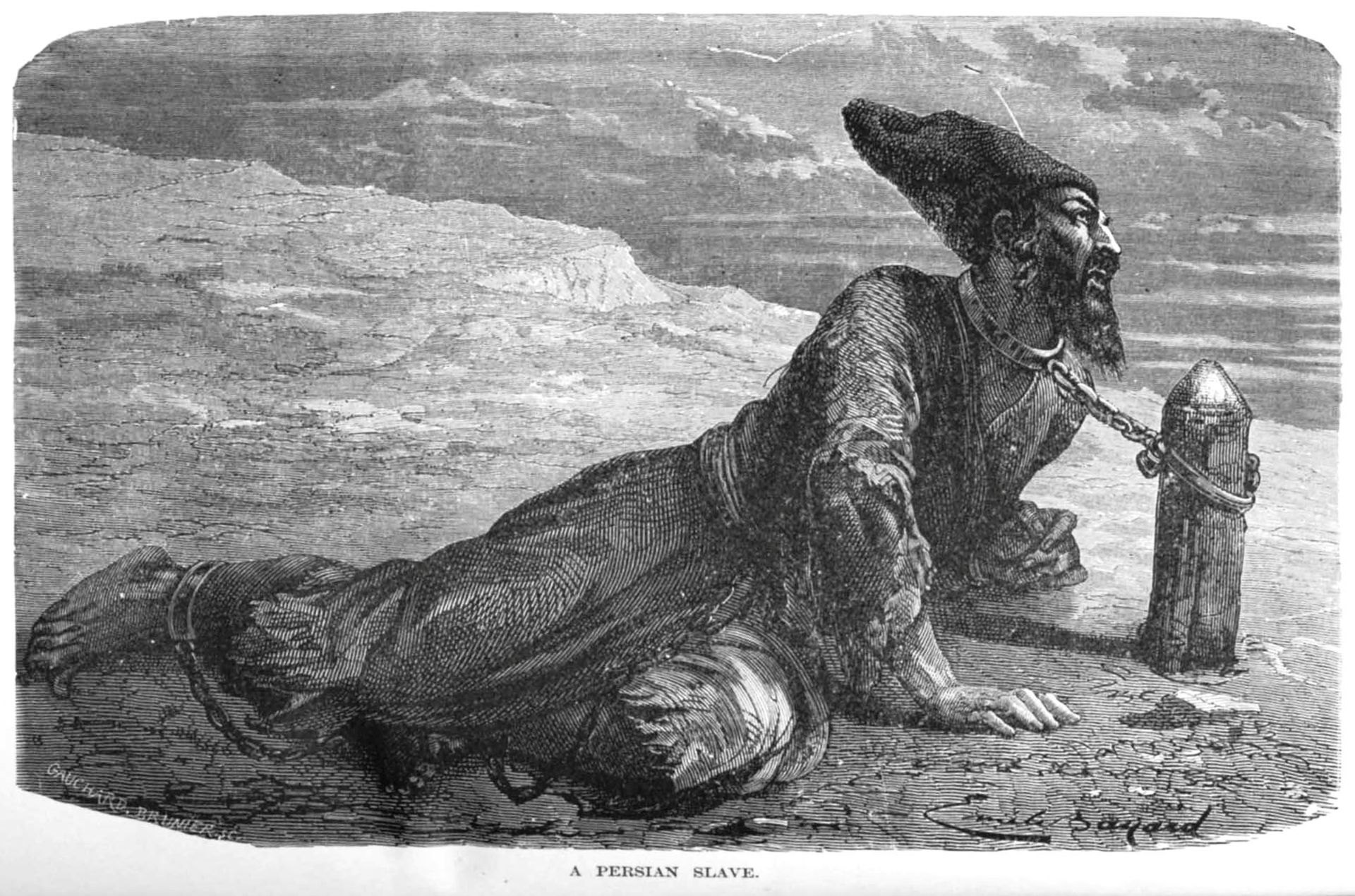 Persian slave in the Khanate of Khiva, 19th century A slave market for captured Russian and Persian slaves was centred in the Central Asian khanate of Khiva.[299] In the early 1840s, the population of the Uzbek states of Bukhara and Khiva included about 900,000 slaves.[225] |
歴史 主な記事 奴隷制度の歴史 以下も参照: 古代における奴隷制度  紀元前7世紀後半に作られた、鉱山で働く奴隷を描いたコリントの黒絵テラコッタの奉納品。 奴隷制度は文字による記録よりも古く、多くの文化に存在していた[3]。奴隷制度は狩猟採集民の間ではまれであり、その理由は経済的余剰とかなりの人口密 度を必要とするからである。したがって、太平洋北西部沿岸のサケが豊富な河川に住むアメリカン・インディアンのような、資源が異常に豊富な狩猟採集民の間 では存在していたものの、奴隷制度が広まったのは、約11,000年前の新石器革命における農業の発明によってのみであった[78]。 奴隷制度はほとんどすべての古代文明で実践されていた[3]。そのような制度には、借金による拘束、犯罪に対する処罰、捕虜の奴隷化、子供の遺棄、奴隷の 子孫の奴隷化などがあった[79]。 アフリカ 以下も参照: アフリカの奴隷制度 セネガンビア地方では、1300年から1900年の間に人口の3分の1近くが奴隷にされていた。ガーナ、マリ、セグー、ソンガイを含む西サヘルの初期のイスラム国家では、人口の約3分の1が奴隷にされていた[81]。 ヨーロッパの宮廷社会や貴族社会では、1300年代後半から1400年代にかけて、アフリカの黒人奴隷とその子供たちが目につくようになった。神聖ローマ 皇帝フリードリヒ2世を皮切りに、アフリカ系黒人は従者に含まれるようになった。1402年、エチオピアの使節団がヴェネツィアに到着した。1470年代 には、アフリカ系黒人が宮廷の従者として描かれ、マントヴァやフェラーラの壁画に飾られた。1490年代には、ミラノ公爵の紋章にアフリカ系黒人が描かれ るようになった[82]。  13世紀のイエメンの奴隷市場[83] サハラ砂漠横断奴隷貿易では、西アフリカの奴隷がサハラ砂漠を越えて北アフリカに運ばれ、地中海や中東の文明に売られた。紅海奴隷貿易では、アフリカから 紅海を渡ってアラビア半島に奴隷が輸送された。東アフリカ奴隷貿易として知られることもあるインド洋奴隷貿易は、多方向から行われていた。アフリカ人はア ラビア半島、インド洋の島々(マダガスカルを含む)、インド亜大陸、そして後にアメリカ大陸へと奴隷として送られた。これらの商人たちは、現在のケニア、 モザンビーク、タンザニアの内陸部からバントゥー系民族(ザンジュ)を捕らえ、沿岸部に連れてきた[84][85]。 1500年から1900年にかけて、インド洋沿岸、中東、北アフリカで1,700万人もの人々が奴隷として売られ、およそ500万人のアフリカ人奴隷がイ スラム教徒の奴隷商人によって買われ、紅海、インド洋、サハラ砂漠を渡ってアフリカから連れ去られたと主張する歴史家もいる[87]。この貿易は、船舶の 発達によって貿易量が増え、この地域のプランテーションにおける労働力の需要が高まるにつれて加速した。最終的には、毎年何万人もの捕虜が連れ去られるよ うになった[86][88][89]。インド洋奴隷貿易は多方向から行われており、時代とともに変化していった。単純労働の需要を満たすために、東アフリ カの奴隷商人によってアフリカ南東部から買い取られたバントゥー系奴隷は、エジプト、アラビア、ペルシャ湾、インド、極東のヨーロッパ植民地、インド洋の 島々、エチオピア、ソマリアの顧客に何世紀にもわたって累積的に大量に売られた[90]。 Encyclopedia of African History(アフリカ史百科事典)によれば、「1890年代までに世界最大の奴隷人口、約200万人がソコト・カリフの領土に集中していたと推定され ている。奴隷労働の利用は、特に農業において広範囲に及んでいた」[91][92]。反奴隷制協会は、1930年代初頭のエチオピアの推定人口800万人 から1600万人のうち、200万人の奴隷がいたと推定している[93]。 東アフリカの奴隷労働は、東アフリカ沿岸に住んでいたバントゥー系民族のザンジュ族から引き抜かれた[85][94]。ザンジュ族は何世紀にもわたってア ラブ商人によってインド洋に接するすべての国々に奴隷として出荷されていた。ウマイヤ朝やアッバース朝のカリフは多くのザンジの奴隷を兵士として採用し、 早くも696年にはイラクでアラブの奴隷商人に対するザンジの奴隷反乱が起こった。ザンジの反乱は、現在のイラクに位置するバスラ(バサラとしても知られ る)近郊で869年から883年にかけて起こった一連の反乱であり、元々はアフリカの大湖地域や東アフリカのさらに南の地域から捕らえられた奴隷ザンジが 関与していたと考えられている[95]。 プランテーション経済が活況を呈し、アラブ人が豊かになるにつれて、農業やその他の肉体労働は卑しいものだと考えられるようになった。その結果、労働力不足が奴隷市場の拡大につながった。  アルジェの奴隷市場、1684年 アルジェリアの首都アルジェでは、捕らえられたキリスト教徒やヨーロッパ人が奴隷として強制連行された。1650年頃には、アルジェには35,000人も のキリスト教徒の奴隷がいた[98]。ある推定によれば、バーバリーの奴隷商人によるイタリアからアイスランドに及ぶ沿岸の村や船への襲撃は、16世紀か ら19世紀にかけて推定100万人から125万人のヨーロッパ人を奴隷にした[99][100][101]。ただし、この推定は、バーバリーの海賊によっ て捕らえられたヨーロッパ人の奴隷の数が250年間一定であったと仮定した外挿の結果である: 何人の男性、女性、子供が奴隷にされたかという記録はないが、人口を安定させ、死亡したり、逃亡したり、身代金を要求されたり、イスラム教に改宗したりし た奴隷と入れ替わるために必要であったであろう新しい捕虜の数をおおよそ計算することは可能である。これに基づくと、1580年から1680年までの 100年間で、約85万人の捕虜を補充するために、毎年約8,500人の新しい奴隷が必要だったと考えられる。さらに、1530年から1780年までの 250年間を考えると、この数字は125万人にも上る可能性がある[102]。 デイヴィスの数字はデイヴィッド・アールのような他の歴史家によって反論されており、彼はヨーロッパ人の奴隷の真の姿は、コルセア人が東ヨーロッパから非 キリスト教徒の白人も押収していたという事実によって曇らされていると警告している[102]。 加えて、取引された奴隷の数は過大であり[要出典]、数世紀全体、あるいは数千年の平均を計算するために、誇張された見積もりがピーク年に依存していた。 それゆえ、特に18世紀と19世紀には、奴隷の輸入を考慮すると、年ごとに大きな変動があり、また1840年代以前には一貫した記録がないという事実も あった。中東の専門家であるジョン・ライトは、現代の推定は人間の観察による逆算に基づいていると警告している[103]。このような観察は、16世紀後 半から17世紀初頭にかけての観察者にまたがり、この期間を通じてバルバリー海岸、トリポリ、チュニス、しかし大部分はアルジェでおよそ35,000人の ヨーロッパ人キリスト教徒奴隷が拘束されたと説明している。その大半は船員(特にイギリス人)で、船とともに連れて行かれたが、漁師や沿岸の村人もいた。 しかし、これらの捕虜のほとんどはアフリカに近い土地、特にスペインやイタリアから来た人々であった[104]。これは最終的に1816年の英蘭艦隊によ るアルジェ砲撃につながった[105][106]。  19世紀、東アフリカのルヴマ川でのアラブ系スワヒリ人奴隷商人とその捕虜たち オマーン系アラブ人の下で、ザンジバルは東アフリカの主要な奴隷港となり、19世紀には毎年5万人ものアフリカ人奴隷が通過していた[107] [108]。 一部の歴史家は、西暦650年から1900年にかけて1100万から1800万人のアフリカ人奴隷が紅海、インド洋、サハラ砂漠を渡ったと推定している [3][検証失敗][109]: 「ダフタルダール・ベイが1822年にヌバ山脈南部で行った作戦の後、4万人近くの奴隷が捕らえられた。しかし、ひどい待遇、病気、砂漠の旅によって、か ろうじて5,000人がエジプトにたどり着いた」[110] W.A.ヴィーンホーフェンは、「目撃者であるドイツ人医師グスタフ・ナハティガルは、市場に到着した奴隷1人につき3、4人が途中で死んだと信じてい た......」と書いている。ケルティ(The Partition of Africa, London, 1920)は、アラブ人が海岸に連れてきた奴隷1人につき少なくとも6人が途中で、あるいは奴隷商人の襲撃中に死んだと考えている。リヴィングストンは 10対1という高い数字を出している」[111]。 隷属と奴隷制度は、古代世界の多くでそうであったように、アフリカの一部でも一般的であった。奴隷制度が普及していた多くのアフリカ社会では、奴隷は家畜 奴隷として扱われず、世界の他の地域の年季奉公に似た制度で一定の権利が与えられていた。アフリカにおける奴隷制の形態は、親族構造と密接な関係があっ た。土地を所有することができない多くのアフリカの共同体では、個人の奴隷化は、その人が持つ影響力を増大させ、つながりを拡大するための手段として用い られていた[112]。これにより、奴隷は主人の血統の永久的な一部となり、奴隷の子どもはより大きな家族の結びつきと密接な関係になることができた [113]。一族に生まれた奴隷の子どもは、主人の親族集団に組み込まれ、社会の中で著名な地位に上り詰めることができ、場合によっては族長のレベルに達 することさえあった。しかし、汚名はしばしばつきまとい、親族集団の奴隷メンバーと主人に関係する奴隷メンバーとの間には厳格な分離が存在することもあっ た[112]。奴隷制はさまざまな形態で行われていた。借金奴隷制、戦争捕虜の奴隷制、軍事奴隷制、犯罪奴隷制はすべてアフリカのさまざまな地域で行われ ていた[114]。  1700年代のヨーロッパの典型的な奴隷船の断面を示す模型、アメリカ国立歴史博物館。 大西洋奴隷貿易が始まると、現地の奴隷制度の多くがアフリカ外の動産奴隷市場に捕虜を供給し始めた。大西洋奴隷貿易はアフリカからの唯一の奴隷貿易ではなかったが、その量と強度は最大であった。エリキア・ムボコロは『ル・モンド・ディプロマティーク』にこう書いている: アフリカ大陸は、ありとあらゆるルートを通じて人的資源を搾取された。サハラ砂漠を越え、紅海を通り、インド洋の港から大西洋を渡った。イスラム諸国の利 益のために、少なくとも10世紀にわたって奴隷制度が続いた(9世紀から19世紀まで)。400万人の奴隷が紅海経由で輸出され、さらに400万人がイン ド洋のスワヒリ港を経由し、おそらく900万人もの奴隷がサハラ砂漠を横断するキャラバンルートで輸出され、1100万人から2000万人(著者による) が大西洋を横断した[115]。 大西洋横断奴隷貿易は18世紀後半にピークを迎え、西アフリカ内陸部への襲撃遠征で最も多くの奴隷が捕獲された。 これらの遠征は通常、オヨ帝国(ヨルバ)、アシャンティ帝国、ダホメー王国[116]、アロ連合王国[117]などのアフリカの王国によって実施された [118]。約15パーセントの奴隷が航海中に死亡したと推定されており、アフリカ自体では先住民を捕獲して船に運ぶ過程で死亡率がかなり高くなった [119][120]。 アメリカ大陸 さらに詳しい情報 大西洋奴隷貿易、エンコミエンダ、ミタ(インカ)、人身売買・搾取・行方不明者研究所、植民地時代のスペイン領アメリカの奴隷制、ブラジルの奴隷制、アメリカの奴隷制 メキシコの奴隷制度はアステカまで遡ることができる[121]。アンデスのインカ、ブラジルのトゥピナンバ、ジョージアのクリーク、テキサスのコマンチなど、他のアメリカ先住民も奴隷制度を実施していた[3]。 カナダにおける奴隷制度は、先住民やヨーロッパ人入植者によって行われていた[122]。 カナダとなった地域の奴隷を所有していた人々は、例えば、アラスカからカリフォルニアに至る太平洋沿岸、太平洋沿岸または北西北部沿岸と表現されることも ある地域[123]に住んでいたユロック族のような漁業社会であった。ハイダ族やトリンギット族など、太平洋岸北西部の先住民の一部は、伝統的に獰猛な戦 士として知られ、カリフォルニアまで略奪する奴隷商人であった。奴隷制度は世襲制であり、奴隷は捕虜であり、その子孫は奴隷であった[124]。ブリ ティッシュコロンビア州のいくつかの国家は、1970年代後半になっても奴隷の子孫を隔離し、追放し続けていた[125]。  大西洋奴隷貿易における奴隷船と捕虜奴隷の配置図。 アメリカにおける奴隷制度は今でも論争の的となっており、革命、内戦、数々の反乱を引き起こし、いくつかの国の歴史と進化に大きな役割を果たした。 奴隷の出荷数で大西洋横断奴隷市場の大半を支配していたのは、イギリス、ポルトガル、フランスであった。  1450年から1800年までにアメリカに渡った奴隷の国別内訳 アメリカ帝国としての地位を確立するために、スペインは新世界の比較的強力な文明と戦わなければならなかった。スペインによるアメリカ大陸の先住民征服に は、先住民を強制労働力として使うことも含まれていた。スペインの植民地は、キューバやイスパニョーラのような島々において、新世界でアフリカ人奴隷を使 用した最初のヨーロッパ人であった[126]。 [127][128][129]16世紀のドミニコ会修道士でありスペインの歴史家であったバルトロメ・デ・ラス・カサスは、キューバでのキャンペーン (バヤモとカマグエイ)に参加し、ハトゥエイの虐殺に立ち会った。また、先住民の減少が憂慮され、先住民を保護する最初の王法が制定された。最初のアフリ カ人奴隷は1501年にイスパニョーラに到着した[130]。この時代、人種に基づく奴隷制度が発展した[131]。イギリスは大西洋奴隷貿易において重 要な役割を果たした。奴隷の三角形」はフランシス・ドレイクとその仲間によって開拓されたが、イギリスの奴隷貿易が本格化するのは17世紀半ばのことであ る。 17世紀から18世紀にかけて北米に到着した白人の多くは、年季奉公人として契約を結んでいた[132]。年季奉公から奴隷制への転換は、ヴァージニアで は徐々に進んだ。このような変化を示す最古の法的文書は、1640年に黒人のジョン・パンチが、逃亡を図ったという理由で、主人であるヒュー・グウィンに 一生仕えなければならないという終身奴隷の判決を言い渡された事件である。この事件は、黒人としての彼の量刑と、彼と一緒に逃亡した2人の白人年季奉公人 (1人はオランダ人、1人はスコットランド人と記述)の量刑との間に格差があることを立証した点で重要であった。これは、終身隷属を言い渡された黒人の最 初の文書化された事例であり、黒人と白人の年季奉公人を人種的に区別した最初の法的事例のひとつと考えられている[133][134]。 1640年以降、プランターは年季奉公契約の満了を無視し、使用人を終身奴隷として飼うようになった。これは1655年のジョンソン対パーカー事件で示さ れたものであり、裁判所は民事裁判の結果、ヴァージニアの黒人アンソニー・ジョンソンに別の黒人ジョン・カソールの所有権を認める判決を下した [135]。これは13植民地において、何の罪も犯していない人間を終身隷属させることができるとする司法判断の最初の事例であった[136] [137]。 スペイン植民地時代のアメリカ 1519年、エルナン・コルテスが最初の近代的奴隷をこの地に連れてきた[138]。16世紀半ば、スペイン新法はアステカ族を含む先住民の奴隷制を禁止 した。労働力不足が生じた。そのため、天然痘にかからないアフリカ人奴隷が輸入されるようになった。138]ジャマイカでは、スペイン人は多くのタイノ族 を奴隷にした。スペイン人は最初のアフリカ人奴隷も導入した[139]。 スペインは、反乱とアメリカ領土または総督領の独立後の1810年まで、実質的に奴隷貿易を行わなかった。ナポレオンの侵略後、スペインは産業とアメリカ 領土を失っていたが、キューバとプエルトリコを除いては、1810年以降、キューバへのアフリカ人奴隷貿易が大規模に始まった。このアフリカ人奴隷貿易 は、フランスの失われた植民地サン・ドミンゲ(ハイチ)から追放されたフランス人プランターたちがキューバ東部に定住したことから始まった。 1789年、スペイン王室はキューバにおける奴隷労働の需要が高まっていたため、奴隷制度の改革に取り組んだ。スペイン王室は、衣食住の提供、労働時間の 制限、刑罰の制限、宗教的指導の義務付け、結婚の保護、幼い子供を母親から引き離す売買の禁止などを定めた法令「コディゴ・ネグロ・エスパニョール(スペ イン黒人法典)」を発布した。イギリスはキューバの奴隷制度に他にも変更を加えた。しかし、プランターたちはしばしば法律に背き、自分たちの権威を脅か し、私生活に踏み込むものだと考え、法律に抗議した[140]。 イギリスとオランダのカリブ海  サトウキビの植え付け、イギリス領西インド諸島、1823年  バルバドス史上最大の奴隷反乱を起こしたブッサの像 17世紀初頭、バルバドスの労働力の大半は、主にイギリス人、アイルランド人、スコットランド人のヨーロッパ人年季奉公人によって提供され、アフリカ人と アメリカ先住民の奴隷は労働力のほとんどを提供しなかった。1640年にサトウキビが導入されると、社会と経済は一変した。バルバドスは最終的に世界最大 級の砂糖産業を持つに至った[141]。就労可能な砂糖プランテーションには多額の投資と大量の重労働が必要であった。当初、オランダ商人が設備、資金、 アフリカ人奴隷を供給し、さらに砂糖の大部分をヨーロッパに輸送した。1644年、バルバドスの人口は30,000人と推定され、そのうち約800人がア フリカ系で、残りは主にイギリス系であった。1700年までには、15,000人の自由白人と50,000人の奴隷アフリカ人がいた。ジャマイカでは、 1670年代と1680年代のアフリカ系奴隷人口は10,000人を超えることはなかったが、1800年までに300,000人以上に増加した。アフリカ 人と白人労働者や支配的なプランター階級との間に差別待遇を設ける奴隷法や黒人法の施行が増加した。これらの掟に対抗して、この時期、いくつかの奴隷反乱 が試みられたり、計画されたりしたが、成功したものはなかった。  オランダ領スリナム、奴隷農園での葬儀。1840-1850. オランダ植民地スリナムのプランターは、コーヒー、カカオ、サトウキビ、綿花プランテーションなどの商品作物の栽培、収穫、加工をアフリカ人奴隷に大きく依存していた[142]。オランダは1863年にスリナムの奴隷制度を廃止した。 多くの奴隷がプランテーションから逃亡した。隣接する熱帯雨林に住む南米先住民の助けを借りて、これらの逃亡奴隷は内陸部に新しい独自の文化を築き上げ、 それ自体が大きな成功を収めた。彼らは英語ではマルーン、フランス語ではNèg'Marrons(文字通り「褐色の黒人」、つまり「青白い肌の黒人」とい う意味)、オランダ語ではMarronsと総称された。マロン族は、異なるアフリカ民族の奴隷から構成されていたため、民族形成の過程を経て、次第にいく つかの独立した部族を形成していった。サラマカ族、パラマカ族、ンドゥカ族、クウィンティ族、アルク族、ボニ族、マタワイ族などです。マルーンはしばしば プランテーションを襲撃し、奴隷から新しいメンバーを集め、女性を捕らえ、武器や食料、物資を手に入れた。植民地主義者たちもまたマルーンの武装キャン ペーンを行ったが、マルーンは通常、植民地主義者たちよりもよく知っている熱帯雨林を通って逃亡した。敵対関係を終わらせるため、18世紀、ヨーロッパの 植民地当局はさまざまな部族と和平条約を結んだ。彼らはマルーンの主権的地位と内陸部での交易権を認め、自治権を与えた。 ブラジル  19世紀ブラジルにおける奴隷の公開鞭打ち(ヨハン・モリッツ・ルゲンダス作  ジャック・エティエンヌ・アラゴによる奴隷の処罰(1839年) ブラジルの奴隷制度は、1532年に最初のポルトガル人入植地が設立されるずっと以前から始まっていた。 その後、ポルトガルの入植者たちは、自給自足経済を維持するために入植の初期段階では先住民の労働力に大きく依存し、先住民はしばしばバンデイラと呼ばれ る探検隊によって捕らえられた。アフリカ人奴隷の輸入は16世紀半ばに始まったが、先住民の奴隷化は17~18世紀まで続いた。 大西洋奴隷貿易時代、ブラジルは他のどの国よりも多くのアフリカ人奴隷を輸入した。1501年から1866年までの間に、500万人近くの奴隷がアフリカ からブラジルに連れて来られた[145]。1850年代初頭まで、ブラジルの海岸に到着したアフリカ人奴隷のほとんどは、西中央アフリカの港、特にルアン ダ(現在のアンゴラ)で強制的に乗船させられた。今日、ナイジェリアを除き、アフリカ系の人口が最も多い国はブラジルである[146]。 奴隷労働はブラジルの砂糖経済成長の原動力であり、砂糖は1600年から1650年まで植民地の主要輸出品であった。1690年にブラジルで金とダイヤモ ンドの鉱脈が発見され、この新たに利益を生む市場を動かすためにアフリカ人奴隷の輸入が増加した。金とダイヤモンドの採掘に参加しようとする移民によって 人口が急増した。18世紀後半に鉱業が衰退した後も、アフリカ人奴隷の需要は衰えることはなかった。人口増加後は牧畜業と食糧生産が盛んになり、いずれも 奴隷労働に大きく依存した。1700年から1800年にかけて、170万人の奴隷がアフリカからブラジルに輸入され、1830年代にはコーヒーの台頭が奴 隷貿易の拡大を促した。 ブラジルは西欧諸国で最後に奴隷制度を廃止した国である。アメリカ大陸に連れてこられた奴隷の総数の40%がブラジルに送られた。ちなみにアメリカは10%だった。廃止されたにもかかわらず、ブラジルでは21世紀の今も奴隷のような状況で働く人々がいる。 ハイチ ハイチにおける奴隷制度は、1492年にクリストファー・コロンブスがこの島に到着したときに始まった。先住民であるタイノ族が強制労働、病気、戦争に よってほぼ壊滅状態に陥った後、スペイン人はカトリック司祭バルトロメ・デ・ラス・カサスの助言の下、また先住民の保護を望むカトリック教会の祝福の下、 アフリカ人奴隷の使用に本格的に取り組み始めた[147]。 [1625年からのフランス植民地時代、ハイチ(当時はサン・ドマング)の経済は奴隷制を基盤としており、その慣習は世界で最も残虐なものとみなされてい た。  1791年のサン=ドマング奴隷反乱  1804年 元奴隷を中心とするハイチ人兵士が、残存するフランス人住民に対して行ったハイチの大虐殺 1697年のリスウィック条約により、イスパニョーラはフランスとスペインに分割された。フランスは西側の3分の1を受け取り、その後サン・ドマングと名 付けた。サトウキビ農園として開発するため、フランスはアフリカから何千人もの奴隷を輸入した。砂糖は、18世紀を通じて儲かる商品作物だった。1789 年までに、サン=ドマングには約4万人の白人入植者が住んでいた。白人たちは、サトウキビ生産を主とする農園で働くために輸入した数万人のアフリカ人奴隷 に圧倒的に劣っていた。島の北部では、奴隷たちはアフリカの文化、宗教、言語と多くのつながりを保つことができた。こうしたつながりは、新たに輸入された アフリカ人によって絶えず更新されていった。黒人は白人を約10対1で上回っていた。 ジャン=バティスト・コルベールが作成し、ルイ14世が批准したフランス制定のコード・ノワール(「黒人の掟」)は、奴隷の待遇と許容される自由に関する 規則を定めていた。サン=ドマングーは最も残酷で効率的な奴隷植民地のひとつと評されており、新たに輸入されたアフリカ人の3分の1が数年以内に死亡した [148]。 多くの奴隷が天然痘や腸チフスなどの病気で死亡した[149]。 出生率は3パーセントほどであり、一部の女性は子供を奴隷制度の中で生活させるのではなく、胎児を堕胎させたり、嬰児殺しを行ったという証拠がある [150][151]。 ルイジアナ植民地と同様に、フランス植民地政府は有色人種である白人男性入植者と黒人女性奴隷(後に混血女性)の混血子孫に一定の権利を認めていた。やが て、多くの人々が奴隷から解放された。彼らは独立した社会階級を築いた。フランス系クレオール人の白人の父親は、混血の息子を教育のためにフランスに送る ことが多かった。有色人種の中には軍隊に入る者もいた。自由な有色人種の多くは島の南部、ポルトープランス近郊に住み、その多くはコミュニティ内で結婚し た。彼らはしばしば職人や商人として働き、ある程度の財産を所有するようになった。奴隷の所有者となる者もいた。自由な有色人種は、植民地政府に彼らの権 利を拡大するよう請願した。 大西洋横断の旅からハイチにたどり着いた奴隷と、ハイチで生まれた奴隷は、まずハイチの公文書館に記録され、フランスの国防省と外務省に移された。 2015年現在、これらの記録はフランス国立公文書館に所蔵されている。1788年の国勢調査によると、ハイチの人口はおよそ40,000人の白人、 30,000人の自由有色人種、450,000人の奴隷で構成されていた[152]。 1804年のハイチ革命は、人類史上唯一成功した奴隷反乱であり、1848年にすべてのフランス植民地における奴隷制の終焉を促した。 アメリカ  1850年、ヴァージニア州スタントンからテネシー州へ徒歩で移動する奴隷の一団。 アメリカ合衆国の奴隷制度とは、18世紀から19世紀にかけて、アメリカ合衆国がイギリスから独立した後、アメリカ南北戦争が終結するまでに存在した、主 にアフリカ人とアフリカ系アメリカ人を対象とした、人間の動産を奴隷とする法的制度である。奴隷制度はイギリス領アメリカでは植民地時代初期から行われて おり、1776年の独立宣言の時点では、13植民地すべてで合法であった。アメリカ独立の頃には、奴隷の地位はアフリカ人の先祖に関連する人種カーストと して制度化されていた[153]。アメリカは奴隷制の問題をめぐって二極化し、メイソン・ディクソン線によって自由州のペンシルベニア州と奴隷州のメリー ランド州とデラウェア州が分断された。 ジェファーソン政権下の1808年、議会は奴隷の輸入を禁止したが、密輸(不法輸入)は珍しいことではなかった[154]。これらの州は、国家の政治的権 力を維持するために、奴隷制を新しい西部領土に拡大しようとした。新たに批准した州への奴隷制の拡大を継続するために議会に提案された法律には、カンザ ス・ネブラスカ法などがある。 アメリカにおける奴隷の扱いは、状況、時代、場所によって大きく異なる。奴隷制の力関係は、奴隷に対する権威を持つ多くの白人を堕落させ、子供たちは自ら 残酷さを示すようになった。主人や監督は、自分たちの意志を押し付けるために肉体的な罰に頼った。奴隷は鞭打ち、手かせ足かせ、首吊り、殴打、火あぶり、 切断、焼き印、投獄によって罰せられた。処罰は、不服従や自覚された違反に対して行われることがほとんどであったが、奴隷の主人や監督の支配を再確認する ために虐待が行われることもあった[155]。 自由を求めて逃亡したウィリアム・ウェルズ・ブラウンの報告によると、ある農園では、奴隷の男性は1日80ポンド(36キロ)、女性は1日70ポンド (32キロ)の綿花を摘むことが義務付けられていた。19世紀半ばに奴隷の競売に参加したニューヨークのある男性は、売りに出された男性奴隷の少なくとも 4分の3は背中に鞭打ちの傷跡があったと報告している[157]。対照的に、小規模の奴隷所有者一家は所有者と奴隷の関係を緊密にしていた。 100万人以上の奴隷が、労働力が余っていた上部南部から売られ、強制移住で深南部に連れて行かれ、多くの家族が分裂した。アフリカ系アメリカ人文化の新 たなコミュニティが深南部で発展し、南部の奴隷総人口は解放前に最終的に400万人に達した[158][159]。 19世紀には、奴隷制度の支持者はしばしば奴隷制度を「必要悪」として擁護した。当時の白人は、黒人奴隷の解放が奴隷制の継続よりも有害な社会的・経済的 結果をもたらすことを恐れていた。フランスの作家であり旅行家でもあったアレクシス・ド・トクヴィルは、『アメリカの民主主義』(1835年)の中で、奴 隷制度がアメリカ社会に及ぼす影響を観察しながら、奴隷制度への反対を表明した。彼は、奴隷制のない多民族社会は成り立たないと考え、黒人に対する偏見 は、黒人により多くの権利が与えられるにつれて増大すると考えたからである。また、ジェームズ・ヘンリー・ハモンドのように、奴隷制度は「積極的な善」で あると主張する者もいた: 「このような階級がなければ、進歩、文明、洗練を導く他の階級は生まれないだろう」。 南部の州政府は、議会における政治的権力の均衡を保つため、奴隷州と自由州の数のバランスを保ちたいと考えていた。イギリス、フランス、メキシコから獲得 した新しい領土は、政治的に大きな妥協の対象となった。1850年までに、新たに豊かになった綿花栽培の南部は連邦から離脱する恐れがあり、緊張は高まり 続けた。教会の牧師を含む多くの南部の白人キリスト教徒は、キリスト教的パターナリズムによって修正されたものとして、奴隷制支持を正当化しようとした [160]。最大の教派であるバプテスト教会、メソジスト教会、長老派教会は、奴隷制問題をめぐって南北の地域組織に分裂した。 ++++++++++++++++++++++++  1836年にアメリカ反奴隷協会によって初めて出版された『アメリカ反奴隷協会年鑑』は、19世紀のアメリカに奴隷制に対する認識をもたらそうとする試みであった。 ++++++++++++++++++++++++  ヴァージニア農園の奴隷(The Old Plantation、1790年頃)。 エイブラハム・リンカーンが奴隷制の拡大阻止を掲げて1860年の選挙に勝利したとき、1860年のアメリカの国勢調査によると、アメリカ全世帯の8%に 相当するおよそ40万人が400万人近くの奴隷を所有していた[161]。 南部世帯の3分の1が奴隷を所有していた[162]。南部は奴隷制に大きく投資していた。そのため、リンカーンの当選と同時に7つの州が離脱し、南部連合 を結成した。最初に脱退した6つの州は、南部で最も多くの奴隷を抱えていた。その直後、奴隷制の問題をめぐってアメリカは全面的な南北戦争に突入し、 1865年12月の戦争終結後、奴隷制度は法的に廃止された。 1865年、米国は合衆国憲法修正第13条を批准し、「当事者が正当に有罪判決を受けた犯罪に対する刑罰としての場合を除き」、奴隷制と非自発的隷属を禁 止し、強制労働が国内で継続される法的根拠を与えた。これが、主にアフリカ系アメリカ人に影響を与えた囚人リース制度につながった。アメリカの刑事司法シ ンクタンク、プリズン・ポリシー・イニシアティブは、2020年のアメリカの刑務所人口を230万人としており、健常な受刑者のほぼ全員が何らかの形で働 いている。テキサス州、ジョージア州、アラバマ州、アーカンソー州では、受刑者は労働に対してまったく賃金を支払われていない。その他の州では、受刑者の 時給は0.12ドルから1.15ドルである。連邦刑務所産業は2017年、受刑者に平均時給0.90ドルを支払った。労働を拒否した受刑者は、無期限で独 房に収容されたり、家族との面会が剥奪されたりする。2010年から2015年まで、そして2016年と2018年にも、アメリカでは一部の受刑者が労働 を拒否し、賃金の改善や条件の改善、強制労働の廃止を求めて抗議した。ストライキの指導者は、無期限の独房監禁で処罰された。強制労働は、政府が運営する 刑務所と民間の刑務所の両方で発生している。コア・シビックとゲオ・グループは民間刑務所の市場シェアの半分を占め、2015年には合わせて35億ドルの 収益を上げている。米国における受刑者の全労働価値は数十億ドルに上ると推定される。カリフォルニア州では、2,500人の収監労働者がCDCRのコンサ ベーション・キャンプ・プログラムを通じて1時間あたりわずか1ドルで山火事に立ち向かい、州は年間1億ドルもの節約をしている[163]。 アジア太平洋地域 以下も参照: アジアにおける奴隷制の歴史 東アジア  15歳の奴隷を6本の平絹と5銭で購入したことを記録した唐代の契約書。 こちらも参照: 中国における奴隷制度 奴隷制度は古代中国では早くも殷の時代に存在していた[164]。 奴隷制度は主に政府が公的労働力を維持する手段として採用していた[165][166]。 [日本の歴史家である杉山正明と船田善之によれば、元朝時代にはモンゴル人奴隷が漢民族に所有されていた[168][169]。1909年の法律 [170][171]や1910年に完全に制定された法律[172]など、法的に認められた制度としては廃止されたと伝えられているが、少なくとも 1949年までは続いていた。 [167]唐の中国人兵士や海賊は朝鮮人、トルコ人、ペルシア人、インドネシア人、内モンゴル、中央アジア、インド北部の人々を奴隷にした[173] [174]。奴隷の最大の供給源はタイ人や福建省、広東省、広西チワン族自治区、貴州省南部の原住民を含む南部の部族であった。マレー人、クメール人、イ ンド人、「黒い肌の」民族(東南アジアや太平洋諸島のオーストロネシア系ネグリト人、またはアフリカ人、あるいはその両方)も唐代に奴隷として購入され た。 [満州語では "家人 "と訳され、"ヌカイ "と表記されることもある。ヌルハチが「主人は奴隷を愛し、奴隷と同じ食べ物を食べるべきだ」と言ったように、満州人は主人と奴隷の間に緊密な個人的・父 権的関係を築いていた。 [176]しかし、ブイ・アハは「中国語の "bond-servant slave"(中国語:奴僕)というカテゴリーに正確に対応していたわけではなく、多くの西洋の学者が "boi "を "bond-servant"(奴僕)と直訳していたにもかかわらず、理論的には緊密な個人的関係と平等な待遇を保証する主人に対する個人的な依存関係で あった。 [アヘンを扱うなどして犯罪を犯した漢人は乞食の奴隷となり、この習慣は清の法律によって管理されていた[177]。 [178]アルティシャールのほとんどの中国人はトルキスタン人乞食の流刑奴隷であった[179]。自由な中国人商人は一般的に東トルキスタンの女性と関 係を持つことはなかったが、乞食に属する中国人奴隷の中には緑旗兵、旗本、満州人とともに東トルキスタンの女性と真剣な関係を持つ者もいた[180]。  妓生(キーセン)とは、上流階級の男性に接待、会話、性的サービスを提供するために訓練された、追放された、あるいは奴隷の家系の女性たちのことである。 朝鮮における奴隷制度は三国時代以前、紀元前1世紀から存在していた[181]。奴隷制度は「中世朝鮮では非常に重要であり、おそらく他のどの東アジアの 国よりも重要であったが、16世紀には人口の増加によって不要になった」と説明されている[182]。ノビは支配階級である両班(ヤンバン)以外の自由民 (中産階級や庶民階級)とは社会的に区別されず、財産権や法的権利、市民権を持っている者もいた。したがって、彼らを「奴隷」と呼ぶのは不適切であると主 張する学者もいれば[183]、農奴と表現する学者もいる[184][185]。 1801年に官人であったノビの大半が解放され[186]、1858年までにノビの人口は朝鮮の人口の約1.5パーセントとなった。 [187]朝鮮時代には、ノビ人口が人口の約3分の1まで変動することもあったが、平均するとノビは総人口の約10%を占めていた[181]。 朝鮮王朝の初期から、特に17世紀に入ると、朝鮮の著名な思想家の間でノビ制度に対する厳しい批判が起こった[188]。英祖は1775年に漸進的な奴隷 解放政策を実施し[182]、英祖とその後継者である正祖は奴隷の負担を軽減するために多くの提案や開発を行い、1801年には大部分の官職奴隷が解放さ れた[189]。 [189]さらに、人口増加[182]、多数の逃亡奴隷[181]、農業の商業化の進展、独立した小農民層の台頭が、1858年までにノビの数を総人口の 約1.5%まで減少させる一因となった。 [187]世襲制のノビ制度は1886年から1987年頃に公式に廃止され[181][187]、その他のノビ制度は1894年の甲午改革で廃止された [181][190]。第二次世界大戦前後の大日本帝国による朝鮮統治時代には、一部の朝鮮人が奴隷制と比較されるような状況で大日本帝国によって強制労 働に使用された[181][191]。第二次世界大戦前と戦時中に大日本帝国軍によって強制的に性的奴隷にされた女性も含まれており、「慰安婦」として知 られている[181][191]。 1543年にポルトガルが初めて日本と接触した後、16世紀から17世紀にかけて、ポルトガルが日本で日本人を奴隷として購入し、ポルトガルを含む海外の 様々な場所に売却する奴隷貿易が発展した[192][193]。多くの文書が、日本人の奴隷化に対する抗議とともに奴隷貿易について言及している。日本人 奴隷はヨーロッパに渡った最初の民族であると考えられており、1555年に教会[194]によって指摘されたように、ポルトガル人は性的な目的でポルトガ ルに連れてくるために日本人奴隷の少女を何人も購入した。日本人の奴隷女性は、1598年の文書でポルトガルのイエズス会士ルイス・セルケイラによって言 及されているように、日本で交易するポルトガル船に仕えていたヨーロッパ人同志とともに、アジア人のラスカルやアフリカ人乗組員の妾として売られることさ えあった[195]。 [196][197]一部の朝鮮人奴隷はポルトガル人によって買われ、日本からポルトガルに連れ戻されたが、彼らは日本の朝鮮侵略(1592~98年)の 際に日本に移送された数万人の朝鮮人捕虜の中に含まれていた。 [198][199]歴史家は、秀吉が日本人奴隷のポルトガル貿易に憤りと怒りを表明したのと同時に、日本では朝鮮人捕虜の集団奴隷貿易に従事していたこ とを指摘している[200][201]。 フィリッポ・サセッティは、1578年にリスボンで大規模な奴隷社会の中に中国人奴隷と日本人奴隷がいるのを目撃しているが、奴隷のほとんどは黒人であっ た[202][203][204][205][206]。 ポルトガルはまた、アフリカ系黒人やムーア人よりも東洋人の奴隷をその希少性から高く評価していた。ポルトガル王セバスチャンは、奴隷制度の横行がカト リックの布教に悪影響を及ぼすことを恐れ、1571年に奴隷制度の禁止を命じた。 [209] 秀吉は、自国の日本人が九州で奴隷として大量に売られていることに嫌悪感を抱き、1587年7月24日、イエズス会副管区長ガスパル・コエーリョに書簡を 書き、ポルトガル人、シャム人(タイ人)、カンボジア人が日本人を購入して奴隷にすることを止め、インドまで行き着いた日本人奴隷を返すよう要求した。 [210][211][212]秀吉はこの奴隷貿易についてポルトガルとイエズス会を非難し、その結果キリスト教の布教を禁止した[213][自費出版] [214]。1595年、ポルトガルは中国人と日本人奴隷の売買を禁止する法律を制定した[215]。 南アジア インドにおける奴隷制度は紀元前6世紀までに広まっており、おそらくヴェーダ時代までさかのぼることができる[216]。11世紀以降のイスラム教徒によ るインド北部の支配下で奴隷制度は激化した[217]。オランダも、インドではハブシまたはシーデとして知られるアビシ人奴隷を主に扱っていた [218]。アラカン/ベンガル、マラバル、コロマンデルは、1660年代まで最大の強制労働の供給源であり続けた。 1626年から1662年にかけて、オランダはアラカン=ベンガル沿岸から年間平均150~400人の奴隷を輸出していた。バタヴィア建国の最初の30年 間は、インド人とアラカン人奴隷がオランダ東インド会社アジア本部の主要労働力であった。南インド(タンジャヴール、センジ、マドゥライ)の支配者ナヤカ のビジャプール支配に対する反乱(1645年)と、それに続くビジャプール軍によるタンジャヴール地方の荒廃に伴う飢饉の際に、コロマンデル奴隷が増加し た。報告によると、侵攻したデッカニ・ムスリム軍によって15万人以上がビジャプールとゴルコンダに連行された。1646年には、2,118人の奴隷がバ タビアに輸出されたが、その圧倒的多数はコロマンデル南部からであった。また、さらに南のトンディ、アディランパトナム、カヤルパトナムでも奴隷が獲得さ れた。1659年から1661年にかけて、ビジャプリの連続的な襲撃の結果、タンジャヴールでも奴隷が増加した。ナガパトナム、プリカットなどで、会社は 8,000~10,000人の奴隷を購入し、その大部分はセイロンに送られたが、ごく一部はバタビアやマラッカに輸出された。最後に、1673年にマドゥ ライとコロマンデル南部で長い干ばつが続き、タンジャヴールをめぐるマドゥライとマラータの争いが長期化し、懲罰的な財政慣行が激化したため、タンジャ ヴールから何千人もの人々(ほとんどが子供)が奴隷として売られ、アジアの商人によってナガパッティナムからアチェ、ジョホール、その他の奴隷市場に輸出 された。 1687年9月には、マドラスのセント・ジョージ砦から665人の奴隷がイギリス人によって輸出された。また、戦乱が再び南インドを荒廃させた1694年 から96年にかけて、合計3,859人の奴隷が個人によってコロマンデルからセイロンに輸入された[219][220][221][222]。 オランダのインド洋奴隷貿易全体の量は、大西洋奴隷貿易の約15~30%、サハラ砂漠横断奴隷貿易よりもわずかに小さく、スワヒリや紅海沿岸、オランダ西 インド会社の奴隷貿易の1.5倍から3倍の規模であったと推定されている[223]。 総督会議に出席していたヘンリー・バートル・フレール卿によれば、1841年のインドには推定800万人とも900万人とも言われる奴隷がいた。マラバー ルの人口の約15%が奴隷だった。1843年のインド奴隷法によって、東インド会社の所有地における奴隷制度は法的に廃止された[3]。 東南アジア インドシナの山岳民族は「シャム人(タイ人)、アナム人(ベトナム人)、カンボジア人によって絶え間なく狩られ、奴隷として連れ去られた」[224]。 [1879年に実施された国勢調査では、マレー領ペラクの人口の6%が奴隷であった[225]。 1880年代の北ボルネオの一部では、奴隷にされた人々が人口の約3分の2を占めていた[225]。 オセアニア ニュージーランドの伝統的なマオリ社会では、奴隷(he mōkai)は社会的役割を認められていた[226]。 特に19世紀には、太平洋とオーストラリアの島々でブラックバーディングが行われていた。 ヨーロッパ 古代ギリシャ・ローマ 主な記事 古代ギリシャの奴隷制度、古代ローマの奴隷制度、黒海奴隷貿易  ヨセフを購入するイシュマエル人(シュノール・フォン・カロスフェルド作、1860年 古代ギリシャにおける奴隷制の記録は、ミケーネ時代のギリシャから始まる。古典期のアテネは最大の奴隷人口を抱えており、紀元前6世紀と5世紀には8万人 もの奴隷がいた[227]。ローマ共和国が外に拡大するにつれて、ヨーロッパと地中海全域で全人口が奴隷にされた。奴隷は労働力としてだけでなく、娯楽 (剣闘士や性奴隷など)にも使われた。少数精鋭によるこの抑圧は、やがて奴隷の反乱(ローマの奴隷戦争を参照)につながり、第三次奴隷戦争はスパルタカス が主導した。 共和政時代後期までに、奴隷制度はローマ社会の経済的支柱となり、ローマの富を支えていた[228]。実際の割合は学者によって議論があり、地域によって 異なるが、古代ローマの人口の25%以上が奴隷であったと推定されている[229][230]。 奴隷はイタリアの人口の15~25%を占め[231]、そのほとんどが戦争捕虜であり[231]、特にガリア[232]とエピルスからの捕虜であった [232]。ローマ帝国における奴隷の数の推定は、大多数がイタリア以外の地方に散らばっていたことを示唆している[231]。 一般的に、イタリアにおける奴隷は土着のイタリア人であった[233]。 イタリア以外で生まれた外国人(奴隷と自由民の両方を含む)は、その数が最も多かった首都において、全体の5%がピークであったと推定されている。ヨー ロッパ以外の出身者は主にギリシャ系であった。ユダヤ人奴隷はローマ社会に完全に同化することはなく、識別可能な少数派であり続けた。これらの奴隷(特に 外国人)は原住民よりも死亡率が高く、出生率が低かったため、集団追放の対象となることもあった[234]。 記録に残るローマの奴隷の平均死亡年齢は17歳半(男性17.2歳、女性17.9歳)であった[235]。 中世・近世ヨーロッパ 主な記事 バルカン奴隷貿易、バーバリー奴隷貿易、クリミア奴隷貿易、ビザンチン帝国の奴隷制度  ボヘミア公ボレスラウス2世に奴隷の解放を嘆願するプラハのアダルベルト。 中世初期のヨーロッパにおける奴隷制度は非常に一般的なものであったため、カトリック教会は、コブレンツ公会議(922年)、ロンドン公会議(1102 年)(主にアイルランドへのイギリス人奴隷の売却を目的としたもの)[236]、アーマー公会議(1171年)などのように、奴隷制度を繰り返し禁止し、 少なくともキリスト教徒が非キリスト教徒の土地に奴隷を輸出することを禁止した。逆に、農奴制は広く受け入れられていた。1452年、ローマ教皇ニコラス 5世は、スペインとポルトガルの国王に「サラセン人(イスラム教徒)、異教徒、その他あらゆる不信心者」を永久奴隷にする権利を与える教皇勅書Dum Diversasを発布し、戦争の結果としての奴隷貿易を合法化した[237]。このような条件下での奴隷制の承認は、1455年のローマ教皇勅書 Romanus Pontifexで再確認され、拡大された。奴隷の大規模な取引は主に中世初期のヨーロッパの南部と東部に限られていた。ビザンティン帝国とイスラム世界 が目的地であり、異教徒の中央ヨーロッパと東ヨーロッパ(コーカサスと韃靼とともに)は重要な供給源であった。ヴァイキング、アラブ、ギリシア、ラダナイ トのユダヤ商人は中世初期に奴隷貿易に関与していた[238][239][240]。ヨーロッパの奴隷貿易は、アラブ世界におけるアフリカ人奴隷の使用を 抑制したザンジの反乱後の10世紀にピークに達した[241][242]。 イギリスでは、ローマの滅亡後も奴隷制度が継続され、中世イングランドではエテルスタン法、中世ウェールズではヒウェル・ザ・グッド法の一部が奴隷を扱っ ていた[243][244]。 ヴァイキングの侵入後は特に取引が活発化し、チェスター[245]やブリストル[246]の主要な市場は、デンマーク人、メルシャン人、ウェールズ人によ る互いの国境地帯への襲撃によって供給されていた。歴史家ジョン・ギリンガムによれば、1200年までにはイギリス諸島における奴隷制度は存在していな かった[249]。 イングランドとウェールズでは奴隷制度が法令によって承認されたことはなく、1772年のサマセット対スチュワート事件においてマンスフィールド卿は、イ ングランド国内でもコモン・ローによって支持されていないと宣言した。奴隷貿易は1807年の奴隷貿易法によって廃止されたが、奴隷制度は1833年の奴 隷制度廃止法と1843年のインド奴隷法が成立するまで、ヨーロッパ以外の領地では合法であった[250]。スコットランドでは、奴隷は18世紀後半まで 家畜として売られ続けた(1722年5月2日、Edinburgh Evening Courant紙に、盗まれた奴隷が発見され、2週間以内に申し出がない限り、経費支払いのために売られると告知する広告が掲載された)[251]。 スコットランドの炭鉱の歴史において200年近くにわたり、鉱夫は1606年に制定された「Anent Coalyers and Salters」という法律によって「メイスター」に拘束されていた。1775年に制定されたColliers and Salters (Scotland) Actは、「多くのColliers and Salters are in a state of slavery and bondage(多くのColliersとSaltersは奴隷と束縛の状態にある)」と述べ、奴隷解放を宣言した。1775年7月1日以降に仕事を始め た者は奴隷にならず、すでに奴隷状態にある者は、年齢に応じて7年または10年後に、自由を認める保安裁判所の判決を申請することができた。1799年に さらなる法律が制定され、彼らの自由が確立され、この奴隷制と束縛が違法となるまで、このような余裕のある者はほとんどいなかった[251][252]。  オスマン・アルジェリアで奴隷の悲惨さを目の当たりにしたイギリス人船長(1815年 ビザンチン・オスマン戦争とヨーロッパにおけるオスマン戦争は、イスラム世界に大量の奴隷をもたらした[253]。オスマン帝国は官僚の人員確保のために ヤニサリー制度を確立し、デヴシルメ制度を通じて何十万人ものキリスト教徒の少年を捕らえた。彼らはよく世話されたが、法的には政府所有の奴隷であり、結 婚することは許されなかった。彼らは決して売買されることはなかった。帝国は彼らに行政的、軍事的に重要な役割を与えました。レパントの海戦の後、オスマ ン艦隊から12,000人のキリスト教徒のガレー船奴隷が奪還され、解放された[255]。東ヨーロッパは一連のタタール人の侵略に見舞われたが、その目 的は奴隷を略奪・捕獲してオスマンにジャスールとして売ることであった[256]。  コルドバのスラヴ人とアフリカ人奴隷、13世紀、サンタ・マリアのカンティガスの挿絵より 中世のスペインとポルトガルは、キリスト教徒が大半を占める地域に対するイスラム教徒の侵入がほとんど絶えなかった。アル=アンダルスから定期的に襲撃隊 が派遣され、イベリア半島のキリスト教王国を襲い、戦利品や奴隷を持ち帰った。例えば、1189年のリスボンに対する襲撃では、アルモハドのカリフである ヤクブ・アル・マンスールが3,000人の女性と子供の捕虜を連れ去り、続く1191年のポルトガルのシルヴェスに対する襲撃では、コルドバの総督が 3,000人のキリスト教徒の奴隷を連れ去った[258]。 11世紀から19世紀にかけて、北アフリカのバーバリー海賊団は、アルジェリアやモロッコなどの奴隷市場で売るために、キリスト教徒の奴隷を捕らえるため にヨーロッパの海岸沿いの町の襲撃に従事した[259]。 1441年、最初の奴隷がモーリタニア北部からポルトガルに連れてこられた[261]。 1552年までには、アフリカ系黒人奴隷がリスボンの人口の10%を占めるようになった[262][263]。 [262][263]16世紀後半、王室は奴隷貿易の独占を放棄し、ヨーロッパのアフリカ奴隷貿易の焦点はヨーロッパへの輸入からアメリカ大陸の熱帯植民 地、特にブラジルへの直接奴隷輸送へと移った[261]。15世紀には奴隷の3分の1が金と引き換えにアフリカ市場に転売された[264]。 18世紀後半まで、クリミア・ハン国(イスラム教徒のタタール人国家)はオスマン帝国や中東との大規模な奴隷貿易を維持していた[256]。奴隷はタター ル人騎兵によってロシア南部、ポーランド・リトアニア、モルダヴィア、ワラキア、チカシアで捕らえられ[265]、クリミアのカファ港で売られた。 [クリミア・ハン国が1783年にロシア帝国によって滅ぼされるまで[266]、16世紀から17世紀にかけて約200万人のキリスト教徒の奴隷が輸出さ れた[267]。  クリミア・タタールの略奪者たちは100万人以上の東ヨーロッパ人を奴隷にした[269]。 キエフ・ルスとムスコヴィーでは、奴隷は通常コロップとして分類されていた。デイヴィッド・P・フォーサイスによれば、「1649年には、ムスコヴィーの 農民の4分の3まで、つまり1300万人から1400万人が農奴であり、その物質的な生活は奴隷とほとんど区別がつかなかった。おそらくさらに150万人 が正式に奴隷となり、ロシア人奴隷がロシア人の主人に仕えていた」[270]。1723年にピョートル大帝が家事奴隷を家農奴に転換するまで、奴隷制度は ロシアの主要な制度であり続けた。ポーランドでは15世紀に奴隷制度が禁止され、リトアニアでは1588年に奴隷制度が正式に廃止され、第二農奴制に取っ て代わられた。 スカンディナヴィアでは、14世紀半ばに奴隷制度が廃止された[272]。 第二次世界大戦  ブッヘンヴァルト・ヴァイマール鉄道で強制労働させられた捕虜(1943年 主な記事 第二次世界大戦中のドイツ支配下における強制労働 第二次世界大戦中、ナチス・ドイツは、好ましくない人々と征服された国の市民を合わせて約1200万人を事実上奴隷にした。これらのウンターメンシェン (亜人)は、死ぬまで働かされ、アーリア人種の一員としての権利も法的地位も持たない劣等な存在として永久に奴隷階級として扱うという公然の意図があった [273]。 ユダヤ人以外にも、ポーランド、[274]ベラルーシ、ウクライナ、ロシアの住民に最も過酷な強制送還と強制労働政策が適用された。戦争終結までに、ベラルーシの人口の半分が殺されるか追放された[275][276]。 共産主義国家 主な記事 収容所  収容所で丘の上に石を運ぶことを強制される労働者たち 1930年から1960年にかけて、ソ連は、アン・アップルバウムや「クレムリンの視点」によれば、収容所(ロシア語:ГУЛаг、ローマ字表記:GULag)と呼ばれる奴隷労働収容所のシステムを構築した[277]。 これらの収容所の囚人たちは、極端な生産割当、肉体的・精神的残虐行為、飢餓、医療ケアの欠如、過酷な環境の組み合わせによって死ぬまで働かされた。収容 所での8年間の収容生活を生き延びたアレクサンドル・ソルジェニーツィンは、『収容所群島』の出版によって収容所についての生の証言を提供し、その後ノー ベル文学賞を受賞した[278][279]。数十万人、おそらく数百万人が、ソビエトのもとでの強制労働の直接的な結果として死亡した[280]。 ゴルフォ・アレクソプロスは、『スターリンの収容所における病気と非人間性』の中で、収容所における労働を「他の形態の奴隷労働」と比較することを提案し、その「人間搾取の暴力」を指摘している[281]。 スターリンの収容所は、多くの点で、強制労働収容所というよりは強制収容所であり、奴隷制度というよりは監獄制度であった。奴隷のイメージは、収容所回想 録の文献にしばしば登場する。ヴァルラム・シャラモフが書いているように、「空腹と疲労で、私たちは馬の首輪にもたれかかり、胸に血豆を作り、石を詰めた 荷車を引いて斜めになった鉱山の床を登っていった。その首輪は、はるか昔に古代エジプト人が使っていたものと同じものだった」。ソ連の強制労働と他の形態 の奴隷労働の思慮深く厳密な歴史的比較は、学者の注目に値すると私は思う。というのも、世界的な奴隷制の場合と同様に、収容所では、危険と罪の推定を伴う 差異に関する精巧な物語に正当性が見出されたからである。この差異イデオロギーと人間搾取の暴力は、現代のロシアに永続的な遺産を残している。 歴史家のアン・アップルバウムは、その著書の序文で、GULAGという言葉は「ソ連の奴隷労働制度そのものを、そのあらゆる形態と多様性において」表すようになったと書いている[282]。 GULAG」という言葉は、ソ連の収容所を運営していた機関であるGlavnoe Upravlenie Lagerei(収容所管理局)の頭文字をとったものである。労働収容所、懲罰収容所、犯罪者収容所、政治収容所、女性収容所、子ども収容所、通過収容所 などである。さらに広義には、「収容所」はソ連の抑圧システムそのものを意味するようになり、アレクサンドル・ソルジェニーツィンがかつて「われわれの肉 挽き機」と呼んだ一連の手続き、すなわち逮捕、尋問、暖房のない牛車での移送、強制労働、家族の破壊、亡命に費やされた年月、早期の不必要な死などを意味 するようになった。 アップルバウムの序論は、収容所研究者のウィルソン・ベルによって批判されており[283]、彼女の著書は「序論を除けば、収容所の概要としてはよくでき ているが、ソルジェニーツィンのパラダイムをはるかに超える解釈の枠組みを提供するものではなかった」と述べている[284]。 中東 以下も参照: エジプトの奴隷制とオスマン帝国の奴隷制  サハラ砂漠を横断してアフリカの黒人奴隷を輸送するアラブの奴隷貿易キャラバンを描いた19世紀の版画。 最古の記録では、奴隷制度は確立された制度として扱われている。例えば、ハンムラビ法典(紀元前1760年頃)では、奴隷の逃亡を手助けした者や逃亡者を 匿った者は死刑と規定されている[285]。古代エジプトにおける奴隷の階級に関するテキスト上の証拠の解釈は、言葉の用法だけで区別することは困難で あった[286][287]。古代エジプトにおける奴隷制の明白な3つのタイプ:動産奴隷制、拘束労働、強制労働[288][289][290]。 1960年代初頭の時点では、サウジアラビアの奴隷人口は30万人と推定されていた[291]。 歴史的に、アラブ世界における奴隷は、サハラ以南のアフリカ(主にザンジュ人)、[293]コーカサス(主にサーカシア人)、[294]中央アジア(主に タルタル人)、中央・東ヨーロッパ(主にスラブ人サカリバ人)など、様々な地域から来ていた[295]。  オスマントルコ戦争では、ヨーロッパ人がその帝国に引きずり込まれた コンスタンチノープルでは人口の約5分の1が奴隷であった[78]。 奴隷はスラヴ人の村落に対するタタール人の襲撃[296]によって供給されたが、征服や反乱の鎮圧によっても供給され、その余波で全人口が奴隷とされ帝国 全土に売られることもあり、将来の反乱のリスクを減らすことができた。オスマン帝国はまた、ヨーロッパやアフリカから帝国に奴隷を持ち込んだ商人からも奴 隷を購入した。1800年から1909年の間にオスマン帝国に輸入された奴隷は、主にサーカシア人で約20万人と推定されている[225]。1908年に おいても、オスマン帝国では女性の奴隷が売られていた[297]。 ドイツの東洋学者グスタフ・ダルマンは、1899年にオスマン・シリアに属するアレッポのイスラム教徒の家で奴隷を見かけたと報告しており、1909年末 にはダマスカスやカイロで少年が奴隷として買われることがあったと報告している[298]。  19世紀、ヒヴァのハーン国のペルシア人奴隷 捕らえられたロシア人やペルシア人の奴隷の奴隷市場は、中央アジアのヒヴァのハン国に集中していた。1840年代初頭、ウズベキスタンのブハラとヒヴァの人口には約90万人の奴隷が含まれていた。 |
| Contemporary slavery See also: Contemporary slavery, Slavery in contemporary Africa, Child slavery, Trafficking of children, Illegal immigration § Slavery, and Slavery in the 21st century 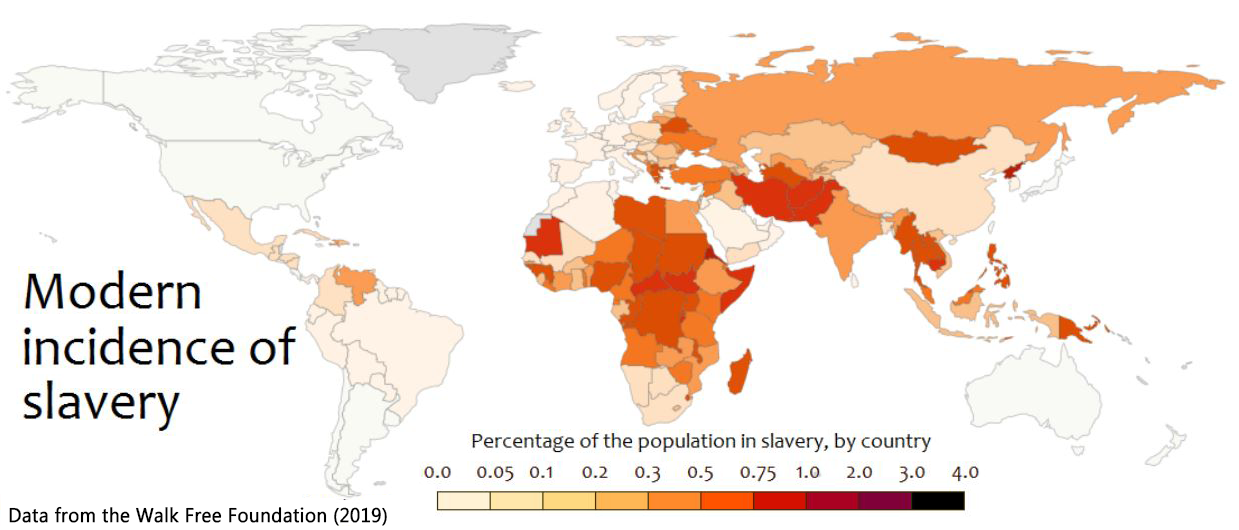 Modern incidence of slavery, as a percentage of the population, by country (2019). Even though slavery is now outlawed in every country, the number of slaves today is estimated as between 12 million and 29.8 million.[300][301][302] According to a broad definition of slavery, there were 27 million people in slavery in 1999, spread all over the world.[303] In 2005, the International Labour Organization provided an estimate of 12.3 million forced labourers.[304] Siddharth Kara has also provided an estimate of 28.4 million slaves at the end of 2006 divided into three categories: bonded labour/debt bondage (18.1 million), forced labour (7.6 million), and trafficked slaves (2.7 million).[69] Kara provides a dynamic model to calculate the number of slaves in the world each year, with an estimated 29.2 million at the end of 2009. 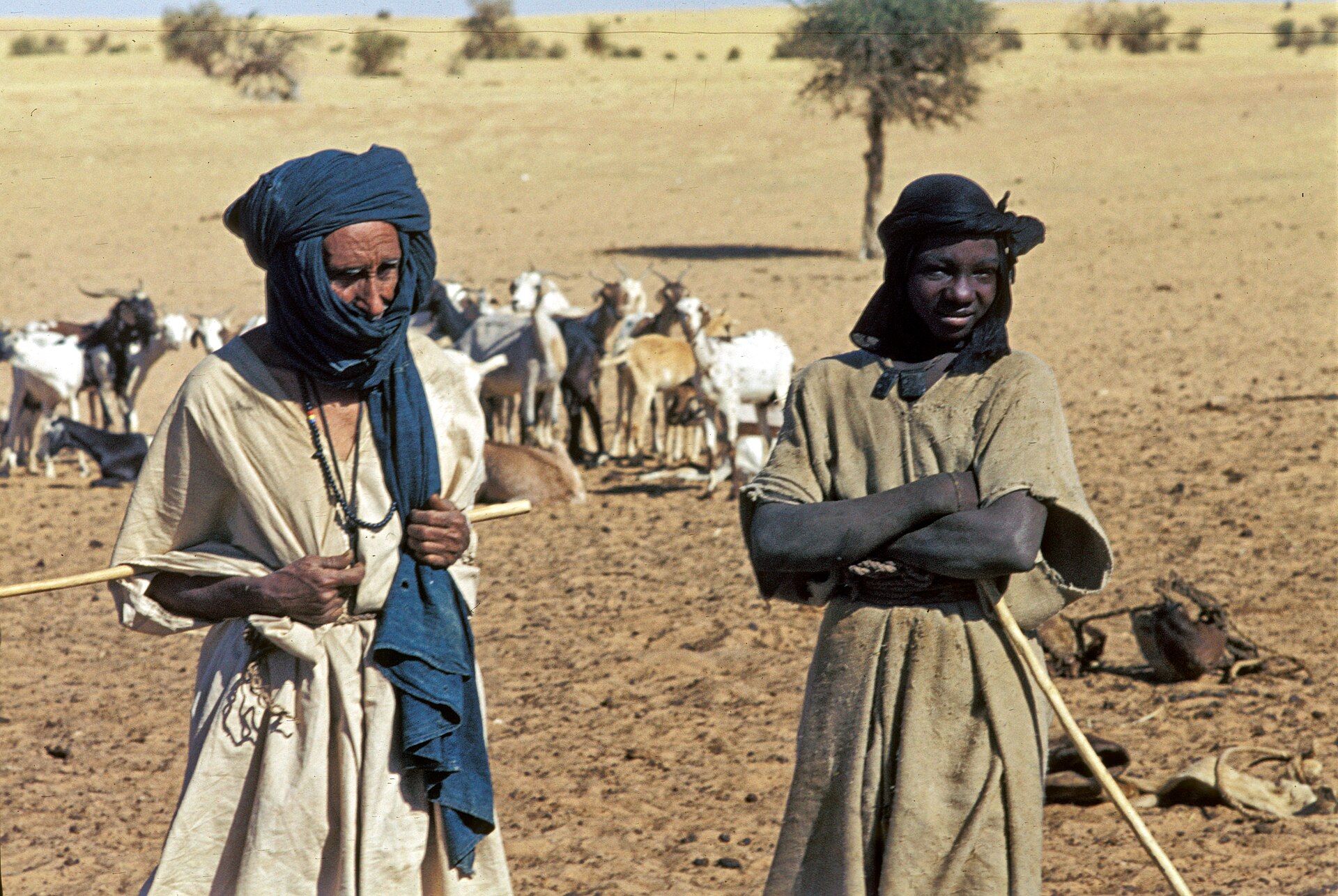 Tuareg society is traditionally hierarchical, ranging from nobles, through vassals, to dark-skinned slaves.[305] According to a 2003 report by Human Rights Watch, an estimated 15 million children in debt bondage in India work in slavery-like conditions to pay off their family's debts.[306][307] Slavoj Žižek asserts that new forms of contemporary slavery have been created in the post-Cold War era of global capitalism, including migrant workers deprived of basic civil rights on the Arabian Peninsula, the total control of workers in Asian sweatshops and the use of forced labor in the exploitation of natural resources in Central Africa.[308] Distribution In June 2013, U.S. State Department released a report on slavery. It placed Russia, China, and Uzbekistan in the worst offenders category. Cuba, Iran, North Korea, Sudan, Syria, and Zimbabwe were at the lowest level. The list also included Algeria, Libya, Saudi Arabia and Kuwait among a total of 21 countries.[309][310] In Kuwait, there are more than 600,000 migrant domestic workers who are vulnerable to forced labor and legally tied to their employers, who often illegally take their passports.[311] In 2019, online slave markets on apps such as Instagram were uncovered.[312] In the preparations for the 2022 World Cup in Qatar, thousands of Nepalese, the largest group of labourers, faced slavery in the form of denial of wages, confiscation of documents, and inability to leave the workplace.[313] In 2016, the United Nations gave Qatar 12 months to end migrant worker slavery or face investigation.[314] The Walk Free Foundation reported in 2018 that slavery in wealthy Western societies is much more prevalent than previously known, in particular the United States and Great Britain, which have 403,000 (one in 800) and 136,000 slaves respectively. Andrew Forrest, founder of the organization, said that "The United States is one of the most advanced countries in the world yet has more than 400,000 modern slaves working under forced labour conditions."[315] An estimated 40.3 million are enslaved globally, with North Korea having the most slaves at 2.6 million (one in 10). Of the estimated 40.3 million people in contemporary slavery, 71% are women and 29% are men. The report found of the 40.3 million in modern slavery, 15.4 million are in forced marriages and 24.9 million are in forced labor.[316] The foundation defines contemporary slavery as "situations of exploitation that a person cannot refuse or leave because of threats, violence, coercion, abuse of power, or deception."[317] China See also: Xinjiang internment camps In March 2020, the Chinese government was found to be using the Uyghur minority for forced labour, inside sweat shops. According to a report published then by the Australian Strategic Policy Institute (ASPI), no fewer than around 80,000 Uyghurs were forcibly removed from the region of Xinjiang and used for forced labour in at least twenty-seven corporate factories.[318] According to the Business and Human Rights resource center, corporations such as Abercrombie & Fitch, Adidas, Amazon, Apple, BMW, Fila, Gap, H&M, Inditex, Marks & Spencer, Nike, North Face, Puma, PVH, Samsung, and UNIQLO have each sourced products from these factories prior to the publication of the ASPI report.[319] Libya During the Second Libyan Civil War, Libyans started capturing Sub-Saharan African migrants trying to get to Europe through Libya and selling them on slave markets or holding them hostage for ransom[320] Women are often raped, used as sex slaves, or sold to brothels.[321][322][323] Child migrants suffer from abuse and child rape in Libya.[324][325] Mauritania In Mauritania, the last country to abolish slavery (in 1981), it is estimated that 20% of its population of 3 million people are enslaved as bonded labourers.[326][327][328] Slavery in Mauritania was criminalized in August 2007.[329] However, although slavery, as a practice, was legally banned in 1981, it was not a crime to own a slave until 2007.[330] Although many slaves have escaped or have been freed since 2007, as of 2012, only one slave owner had been sentenced to serve time in prison.[331] North Korea See also: Human rights in North Korea North Korea's human rights record is often considered to be the worst in the world and has been globally condemned, with the United Nations, the European Union and groups such as Human Rights Watch all critical of the country's record. Forms of torture, forced labour, and abuses are all widespread. Most international human rights organizations consider North Korea to have no contemporary parallel[332] with respect to violations of liberty.[333][334][335][336] Economics While American slaves in 1809 were sold for around $40,000 (in inflation adjusted dollars), a slave nowadays can be bought for just $90, making replacement more economical than providing long-term care.[337] Slavery is a multibillion-dollar industry with estimates of up to $35 billion generated annually.[338] Trafficking Victims of human trafficking are typically recruited through deceit or trickery (such as a false job offer, false migration offer, or false marriage offer), sale by family members, recruitment by former slaves, or outright abduction. Victims are forced into a "debt slavery" situation by coercion, deception, fraud, intimidation, isolation, threat, physical force, debt bondage or even force-feeding with drugs to control their victims.[339] "Annually, according to U.S. government-sponsored research completed in 2006, approximately 800,000 people are trafficked across national borders, which does not include millions trafficked within their own countries. Approximately 80% of transnational victims are women and girls, and up to 50% are minors, reports the U.S. State Department in a 2008 study.[340] While the majority of trafficking victims are women who are forced into prostitution (in which case the practice is called sex trafficking), victims also include men, women and children who are forced into manual labour.[341] Because of the illegal nature of human trafficking, its extent is unknown. A U.S. government report, published in 2005, estimates that about 700,000 people worldwide are trafficked across borders each year. This figure does not include those who are trafficked internally.[341] Another research effort revealed that roughly 1.5 million individuals are trafficked either internally or internationally each year, of which about 500,000 are sex trafficking victims.[69] |
現代の奴隷制度 以下も参照: 現代の奴隷制、現代アフリカの奴隷制、子どもの奴隷制、子どもの人身売買、不法移民§奴隷制、21世紀の奴隷制  国別、人口に占める現代の奴隷制の発生率(2019年)。 奴隷制度は現在ではすべての国で非合法化されているが、今日の奴隷の数は1200万人から2980万人と推定されている[300][301][302]。 広義の奴隷制度によれば、1999年には2700万人が奴隷状態にあり、世界中に広がっていた[303]。 2005年、国際労働機関は1230万人の強制労働者という推定を示した。 [304]シッダールト・カラも、2006年末時点で2840万人の奴隷がいると推定しており、3つのカテゴリーに分類している:拘束労働/債務拘束 (1810万人)、強制労働(760万人)、人身売買された奴隷(270万人)[69]。  トゥアレグ社会は伝統的に階層社会であり、貴族から家臣を経て肌の黒い奴隷に至る[305]。 ヒューマン・ライツ・ウォッチによる2003年の報告書によれば、インドでは推定1,500万人の借金苦の子供たちが家族の借金を返済するために奴隷のような状況で働いている[306][307]。 スラヴォイ・ジジェクは、アラビア半島における基本的市民権を奪われた移民労働者、アジアの搾取工場における労働者の完全支配、中央アフリカにおける天然 資源の搾取における強制労働の使用など、冷戦後のグローバル資本主義の時代において、現代の奴隷制の新たな形態が生み出されたと主張している[308]。 流通 2013年6月、米国務省は奴隷制に関する報告書を発表した。同報告書では、ロシア、中国、ウズベキスタンを最悪の犯罪者のカテゴリーに位置づけている。 キューバ、イラン、北朝鮮、スーダン、シリア、ジンバブエは最低レベルだった。このリストには、アルジェリア、リビア、サウジアラビア、クウェートも合計 21カ国の中に含まれていた[309][310]。 クウェートでは、強制労働に弱い60万人以上の出稼ぎ家事労働者がおり、法的に雇用主に縛られており、雇用主はしばしばパスポートを不法に持ち出している[311]。 2019年には、インスタグラムなどのアプリ上のオンライン奴隷市場が摘発された[312]。 カタールでの2022年ワールドカップの準備では、労働者の最大のグループである何千人ものネパール人が、賃金の拒否、書類の没収、職場を離れることがで きないといった形で奴隷制に直面した[313]。 2016年、国連はカタールに対し、移民労働者の奴隷制を終わらせるか、調査に直面するよう12カ月を与えた[314]。 ウォーク・フリー財団は2018年に、裕福な欧米社会における奴隷制度はこれまで知られていたよりもはるかに普及しており、特に米国と英国ではそれぞれ 40万3,000人(800人に1人)と13万6,000人の奴隷がいると報告している。同団体の創設者であるアンドリュー・フォレストは、「米国は世界 で最も先進的な国のひとつでありながら、40万人以上の現代奴隷が強制労働の下で働いている」と述べている[315]。世界全体で推定4,030万人が奴 隷となっており、最も奴隷が多いのは北朝鮮で260万人(10人に1人)である。推定4,030万人の現代奴隷のうち、71%が女性で、29%が男性であ る。報告書によれば、現代の奴隷状態にある4,030万人のうち、1,540万人が強制結婚の状態にあり、2,490万人が強制労働の状態にある [316]。同財団は、現代の奴隷状態を「脅迫、暴力、強要、権力の乱用、欺瞞のために、人が拒否することも離れることもできない搾取の状況」と定義して いる[317]。 中国 以下も参照: 新疆収容所 2020年3月、中国政府は少数民族のウイグル人を強制労働に利用していることが判明した。オーストラリア戦略政策研究所(ASPI)が当時発表した報告 書によると、約8万人を下らないウイグル人が新疆ウイグル自治区から強制連行され、少なくとも27の企業の工場で強制労働に使われていた。 [318] Business and Human Rights resource centerによると、アバクロンビー&フィッチ、アディダス、アマゾン、アップル、BMW、フィラ、ギャップ、H&M、インディテックス、マー クス&スペンサー、ナイキ、ノースフェイス、プーマ、PVH、サムスン、ユニクロなどの企業は、ASPIの報告書が発表される前に、これらの工場から製品 を調達していた[319]。 リビア 第2次リビア内戦の間、リビア人はリビア経由でヨーロッパに行こうとするサハラ以南のアフリカからの移民を捕らえ、奴隷市場で売ったり、身代金のために人 質にしたりし始めた[320]。女性はしばしばレイプされ、性奴隷として使われたり、売春宿に売られたりする[321][322][323]。リビアでは 子どもの移民が虐待や子どものレイプに苦しんでいる[324][325]。 モーリタニア モーリタニアは奴隷制を廃止した最後の国(1981年)であり、人口300万人のうち20%が奴隷労働者であると推定されている[326][327] [328]。モーリタニアにおける奴隷制は2007年8月に犯罪化された。 [329]しかし、慣習としての奴隷制度は1981年に法的に禁止されたものの、2007年までは奴隷を所有することは犯罪ではなかった[330]。 2007年以降、多くの奴隷が逃亡したり解放されたりしているが、2012年現在、服役を言い渡された奴隷所有者は1人のみである[331]。 北朝鮮 以下も参照: 北朝鮮の人権 北朝鮮の人権記録はしばしば世界最悪とみなされ、国際連合、欧州連合、ヒューマン・ライツ・ウォッチなどの団体によって世界的に非難されている。拷問、強 制労働、虐待などが蔓延している。ほとんどの国際人権団体は、自由に対する侵害に関して、北朝鮮は現代に類似するものがない[332]と考えている [333][334][335][336]。 経済 1809年のアメリカの奴隷はおよそ40,000ドル(インフレ調整後のドル)で売られていたが、現在では奴隷はわずか90ドルで買うことができ、長期的 なケアを提供するよりも交換の方が経済的である[337]。 奴隷制は数十億ドル規模の産業であり、毎年最大350億ドルが生み出されると推定されている[338]。 人身売買 人身売買の被害者は、通常、詐欺や策略(偽の就職斡旋、偽の移住斡旋、偽の結婚斡旋など)、家族による売買、元奴隷による勧誘、または完全な拉致によって 募集される。被害者は、強制、欺瞞、詐欺、脅迫、隔離、脅し、身体的強制力、借金による束縛、あるいは被害者を支配するための薬物による強制給餌によっ て、「債務奴隷」の状況に追い込まれる[339]。「2006年に完了した米国政府主催の調査によると、年間約80万人が国境を越えて人身売買されてお り、これには自国内で人身売買されている数百万人は含まれていない。国境を越えた被害者の約80%は女性と少女であり、最大50%が未成年者であると、 2008年の調査で米国務省が報告している[340]。 人身売買の被害者の大多数は売春を強要される女性であるが(この場合、その行為は性売買と呼ばれる)、被害者には肉体労働を強要される男性、女性、子ども も含まれる[341]。2005年に発表された米国政府の報告書によれば、世界中で毎年約70万人が国境を越えて人身売買されていると推定されている。こ の数字には、国内で人身売買されている者は含まれていない[341]。別の調査活動では、毎年およそ150万人が国内外を問わず人身売買されており、その うち約50万人が性犯罪の被害者であることが明らかにされている[69]。 |
| Abolitionism Main article: Abolitionism For a chronological guide, see Timeline of abolition of slavery and serfdom. vte Slave Trade suppression 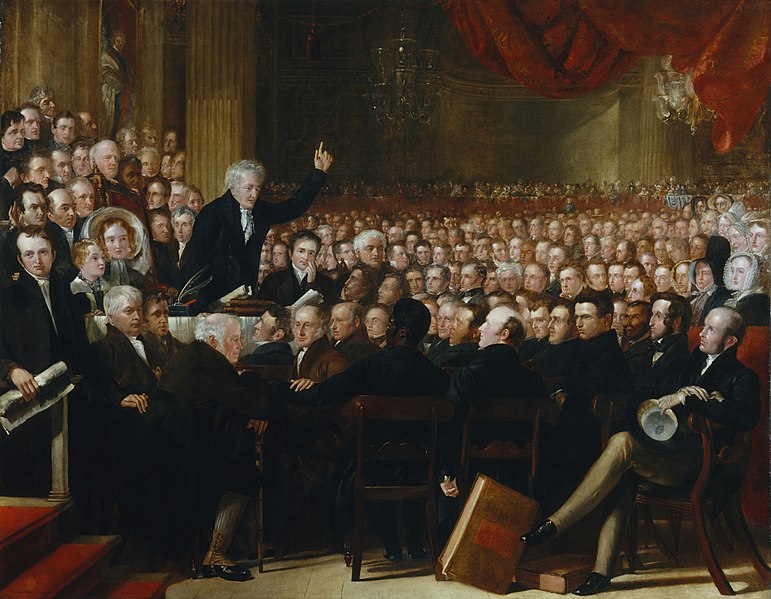 A painting of the 1840 World Anti-Slavery Convention at Exeter Hall in London.[342] Slavery has existed, in one form or another, throughout recorded human history – as have, in various periods, movements to free large or distinct groups of slaves. In antiquity 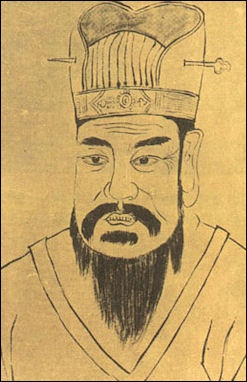 Chinese Emperor Wang Mang abolished slavery in 17 CE but the ban was overturned after his assassination. Ashoka, who ruled the Maurya Empire in the Indian subcontinent from 269 to 232 BCE, abolished the slave trade but not slavery.[343] The Qin dynasty, which ruled China from 221 to 206 BC, abolished slavery and discouraged serfdom. However, many of its laws were overturned when the dynasty was overthrown.[344] Slavery was again abolished by Wang Mang in China in 17 CE but was reinstituted after his assassination.[345] Americas The Spanish colonization of the Americas sparked a discussion about the right to enslave Native Americans. A prominent critic of slavery in the Spanish New World colonies was the Spanish missionary and bishop, Bartolomé de las Casas, who was "the first to expose the oppression of indigenous peoples by Europeans in the Americas and to call for the abolition of slavery there."[346] In the United States, all of the northern states had abolished slavery by 1804, with New Jersey being the last to act.[347] Abolitionist pressure produced a series of small steps towards emancipation. After the Act Prohibiting Importation of Slaves went into effect on January 1, 1808, the importation of slaves into the United States was prohibited,[348] but not the internal slave trade, nor involvement in the international slave trade externally. Legal slavery persisted outside the northern states; most of those slaves already in the U.S. were legally emancipated only in 1863. Many American abolitionists took an active role in opposing slavery by supporting the Underground Railroad. Violent clashes between anti-slavery and pro-slavery Americans included Bleeding Kansas, a series of political and armed disputes in 1854–1858 as to whether Kansas would join the United States as a slave or free state. By 1860, the total number of slaves reached almost four million, and the American Civil War, beginning in 1861, led to the end of slavery in the United States.[349] In 1863, Lincoln issued the Emancipation Proclamation, which freed slaves held in the Confederate States; the 13th Amendment to the U.S. Constitution prohibited most forms of slavery throughout the country. Many of the freed slaves became sharecroppers and indentured servants. In this manner, some became tied to the very parcel of land into which they had been born a slave having little freedom or economic opportunity because of Jim Crow laws which perpetuated discrimination, limited education, promoted persecution without due process and resulted in continued poverty. Fear of reprisals such as unjust incarcerations and lynchings deterred upward mobility further. 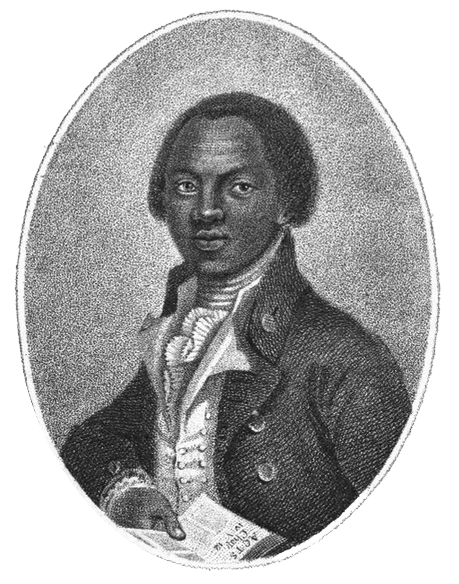 Olaudah Equiano, His autobiography, published in 1789, helped in the creation of the Slave Trade Act 1807 which ended the African slave trade for Britain and its colonies. 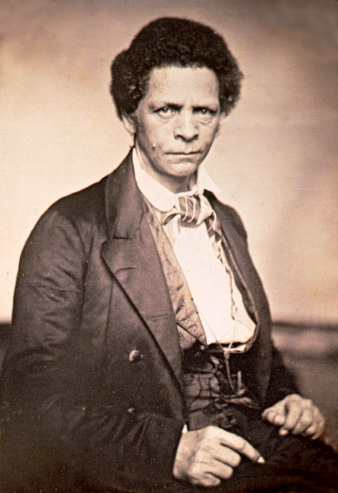 Joseph Jenkins Roberts, born in Virginia, was the first president of Liberia, which was founded in 1822 for freed American slaves. Europe France abolished slavery in 1794 during the Revolution,[350] but it was restored in 1802 under Napoleon.[351] It has been asserted that, before the Revolution, slavery was illegal in metropolitan France (as opposed to its colonies),[352] but this has been refuted.[353] One of the most significant milestones in the campaign to abolish slavery throughout the world occurred in England in 1772, with British Judge Lord Mansfield, whose opinion in Somersett's Case was widely taken to have held that slavery was illegal in England. This judgement also laid down the principle that slavery contracted in other jurisdictions could not be enforced in England.[354] Sons of Africa was a late 18th-century British group that campaigned to end slavery. Its members were Africans in London, freed slaves who included Ottobah Cugoano, Olaudah Equiano and other leading members of London's black community. It was closely connected to the Society for Effecting the Abolition of the Slave Trade, a non-denominational group founded in 1787, whose members included Thomas Clarkson. British Member of Parliament William Wilberforce led the anti-slavery movement in the United Kingdom, although the groundwork was an anti-slavery essay by Clarkson. Wilberforce was urged by his close friend, Prime Minister William Pitt the Younger, to make the issue his own and was also given support by reformed Evangelical John Newton. The Slave Trade Act was passed by the British Parliament on March 25, 1807, making the slave trade illegal throughout the British Empire,[355] Wilberforce also campaigned for abolition of slavery in the British Empire, which he lived to see in the Slavery Abolition Act 1833. After the 1807 act abolishing the slave trade was passed, these campaigners switched to encouraging other countries to follow suit, notably France and the British colonies. Between 1808 and 1860, the British West Africa Squadron seized approximately 1,600 slave ships and freed 150,000 Africans who were aboard.[356] Action was also taken against African leaders who refused to agree to British treaties to outlaw the trade, for example against "the usurping King of Lagos", deposed in 1851. Anti-slavery treaties were signed with over 50 African rulers.[357] Worldwide In 1839, the world's oldest international human rights organization, Anti-Slavery International, was formed in Britain by Joseph Sturge, which campaigned to outlaw slavery in other countries.[358] There were celebrations in 2007 to commemorate the 200th anniversary of the abolition of the slave trade in the United Kingdom through the work of the British Anti-Slavery Society. In the 1860s, David Livingstone's reports of atrocities within the Arab slave trade in Africa stirred up the interest of the British public, reviving the flagging abolitionist movement. The Royal Navy throughout the 1870s attempted to suppress "this abominable Eastern trade", at Zanzibar in particular. In 1905, the French abolished indigenous slavery in most of French West Africa.[359] On December 10, 1948, the United Nations General Assembly adopted the Universal Declaration of Human Rights, which declared freedom from slavery is an internationally recognized human right. Article 4 of the Universal Declaration of Human Rights states: No one shall be held in slavery or servitude; slavery and the slave trade shall be prohibited in all their forms.[360] In 2014, for the first time in history, major leaders of many religions, Buddhist, Hindu, Christian, Jewish, and Muslim met to sign a shared commitment against modern-day slavery; the declaration they signed calls for the elimination of slavery and human trafficking by 2020.[361] The signatories were: Pope Francis, Mātā Amṛtānandamayī, Bhikkhuni Thich Nu Chân Không (representing Zen Master Thích Nhất Hạnh), Datuk K Sri Dhammaratana, Chief High Priest of Malaysia, Rabbi Abraham Skorka, Rabbi David Rosen, Abbas Abdalla Abbas Soliman, Undersecretary of State of Al Azhar Alsharif (representing Mohamed Ahmed El-Tayeb, Grand Imam of Al-Azhar), Grand Ayatollah Mohammad Taqi al-Modarresi, Sheikh Naziyah Razzaq Jaafar, Special advisor of Grand Ayatollah (representing Grand Ayatollah Sheikh Basheer Hussain al Najafi), Sheikh Omar Abboud, Justin Welby, Archbishop of Canterbury, and Metropolitan Emmanuel of France (representing Ecumenical Patriarch Bartholomew.)[361] Groups such as the American Anti-Slavery Group, Anti-Slavery International, Free the Slaves, the Anti-Slavery Society, and the Norwegian Anti-Slavery Society continue to campaign to eliminate slavery.[citation needed] UNESCO has been working to break the silence surrounding the memory of slavery since 1994, through The Slave Route Project.[362] |
廃止論 主な記事 廃止主義 年表は奴隷制・農奴制廃止年表を参照。 ヴテ 奴隷貿易弾圧  ロンドンのエクセター・ホールで開催された1840年の世界反奴隷制大会の絵画[342]。 奴隷制度は、記録された人類の歴史を通じて、何らかの形で存在してきた。 古代においては  中国の王莽皇帝は紀元17年に奴隷制度を廃止したが、彼の暗殺後に禁止は覆された。 紀元前269年から232年までインド亜大陸のマウリヤ帝国を支配したアショカは、奴隷貿易を廃止したが、奴隷制は廃止しなかった[343]。紀元前 221年から206年まで中国を支配した秦王朝は、奴隷制を廃止し、農奴制を奨励した。しかし、王朝が倒されるとその法律の多くは覆された[344]。紀 元17年、中国の王莽によって奴隷制度は再び廃止されたが、彼の暗殺後に復活した[345]。 アメリカ大陸 スペインによるアメリカ大陸の植民地化は、アメリカ先住民を奴隷にする権利についての議論を巻き起こした。スペインの新大陸植民地における奴隷制の著名な 批判者は、スペインの宣教師であり司教であったバルトロメ・デ・ラス・カサスであり、彼は「アメリカ大陸におけるヨーロッパ人による先住民の抑圧を初めて 暴露し、そこでの奴隷制の廃止を求めた人物」であった[346]。 アメリカでは、1804年までに北部のすべての州が奴隷制を廃止したが、ニュージャージー州が最後の措置であった[347]。1808年1月1日に奴隷輸 入禁止法が施行されると、アメリカ合衆国への奴隷の輸入は禁止された[348]が、国内的な奴隷貿易や対外的な国際奴隷貿易への関与は禁止されなかった。 合法的な奴隷制度は北部の州以外でも存続し、すでに米国にいた奴隷のほとんどが法的に解放されたのは1863年のことであった。アメリカの奴隷廃止論者の 多くは、地下鉄道を支援することで、奴隷制に反対する積極的な役割を果たした。1854年から1858年にかけて、カンザス州が奴隷州として合衆国に加盟 するか自由州として合衆国に加盟するかをめぐって政治的・武力的に争われたブリーディング・カンザス事件など、反奴隷制と奴隷制を支持するアメリカ人同士 の激しい衝突もあった。1860年までに、奴隷の総数はほぼ400万人に達し、1861年に始まったアメリカ南北戦争によって、アメリカにおける奴隷制度 は終焉した[349]。1863年、リンカーンは奴隷解放宣言を発布し、南軍に拘束されていた奴隷を解放した。 解放された奴隷の多くは、小作人や年季奉公人となった。このようにして、奴隷として生まれた土地に縛られ、自由も経済的機会もほとんど与えられなくなった 者もいた。ジム・クロウ法は差別を永続させ、教育を制限し、正当な手続きなしに迫害を助長し、その結果貧困が続いたからである。不当な投獄やリンチなどの 報復を恐れ、上昇志向はさらに抑止された。  オラウダ・エキアーノ、1789年に出版された彼の自伝は、1807年の奴隷貿易法の制定に貢献し、イギリスとその植民地のアフリカ奴隷貿易を終結させた。  ジョセフ・ジェンキンス・ロバーツ(ヴァージニア生まれ):1822年に解放されたアメリカ人奴隷のために設立されたリベリアの初代大統領。 ヨーロッパ フランスは革命中の1794年に奴隷制を廃止したが[350]、1802年にナポレオンの下で復活した[351]。革命以前は(植民地とは対照的に)フランス首都圏では奴隷制は違法であったと主張されているが[352]、これには反論がある[353]。 世界中で奴隷制を廃止する運動において最も重要なマイルストーンのひとつは、1772年にイギリスで起こったマンスフィールド卿の判決であった。マンス フィールド卿はSomersett's Caseにおいて、奴隷制はイギリスでは違法であるとする判決を下し、広く受け止められていた。この判決はまた、他の司法管轄区で契約された奴隷制はイン グランドでは強制できないという原則を打ち立てた[354]。 サンズ・オブ・アフリカ(Sons of Africa)は、18世紀後半にイギリスで結成された奴隷制廃止運動団体である。そのメンバーはロンドンのアフリカ人で、オットバ・クゴアノ、オラウ ダ・エキアーノ、その他ロンドンの黒人社会の主要メンバーを含む解放奴隷であった。1787年に設立された無宗派の団体である奴隷貿易廃止効果協会と密接 な関係があり、そのメンバーにはトーマス・クラークソンも含まれていた。イギリスの国会議員ウィリアム・ウィルバーフォースは、クラークソンによる反奴隷 制エッセイが下地となったとはいえ、イギリスにおける反奴隷制運動を主導した。ウィルバーフォースは、親友であったウィリアム・ピット青年首相から、この 問題を自分の問題とするよう促され、改革派の福音主義者ジョン・ニュートンからも支援を受けた。1807年3月25日、奴隷貿易法がイギリス議会で可決さ れ、大英帝国全土で奴隷貿易が違法となった[355]。ウィルバーフォースはまた、大英帝国における奴隷制廃止のキャンペーンを展開し、1833年に奴隷 制廃止法を制定した。 1807年に奴隷貿易廃止法が成立すると、これらの運動家は他の国々、特にフランスとイギリスの植民地に追随するよう働きかけることに切り替えた。 1808年から1860年の間に、イギリス西アフリカ戦隊はおよそ1,600隻の奴隷船を拿捕し、乗っていた15万人のアフリカ人を解放した[356]。 1851年に退位させられた「ラゴスの簒奪王」など、奴隷貿易を非合法化するイギリスの条約に同意することを拒否したアフリカの指導者たちに対しても行動 が起こされた。反奴隷条約は50以上のアフリカの支配者と結ばれた[357]。 世界 1839年、ジョセフ・スタージによって、世界最古の国際人権団体である反奴隷制インターナショナルが英国で結成され、他国の奴隷制を非合法化する運動を行った[358]。 1860年代には、デイヴィッド・リヴィングストンがアフリカのアラブ奴隷貿易における残虐行為を報告したことで、イギリス国民の関心が高まり、低迷して いた奴隷廃止運動が復活した。英国海軍は1870年代を通じて、特にザンジバルで「この忌まわしい東洋貿易」を抑制しようと試みた。1905年、フランス はフランス領西アフリカの大部分で土着の奴隷制を廃止した[359]。 1948年12月10日、国連総会は世界人権宣言を採択し、奴隷制からの自由は国際的に認められた人権であると宣言した。世界人権宣言の第4条は次のように述べている: 何人も、奴隷又は隷属に拘束されない。奴隷制及び奴隷貿易は、そのあらゆる形態において禁止される[360]。 2014年、歴史上初めて、仏教、ヒンドゥー教、キリスト教、ユダヤ教、イスラム教といった多くの宗教の主要な指導者たちが集まり、現代の奴隷制に反対す る共通のコミットメントに署名した。彼らが署名した宣言は、2020年までに奴隷制と人身売買を撤廃することを求めている[361]: 署名者は、フランシスコ法王、マーター・アムターナンダマーイ、ビククニ・ティク・ヌ・チャーン・コー(ティク・ニャット・ハン禅師を代表)、マレーシア のダトゥク・スリ・ダンマラタナ大僧正、ラビ・アブラハム・スコルカ、ラビ・デービッド・ローゼン、アル・アズハル・アルシャリフ国務次官アッバス・アブ ダラ・アッバス・ソリマン(モハメド・アーメド・エル・タイエブを代表、 アル・アズハル大導師)、大アヤトラ・ムハンマド・タチ・アル・モダレシ師、大アヤトラ特別顧問ナズィヤ・ラズザク・ジャアファル師(大アヤトラ・バシー ル・フサイン・アル・ナジャフィ師の代理)、オマル・アブード師、カンタベリー大主教ジャスティン・ウェルビー、フランス大主教エマニュエル(エキュメニ カル総主教バルトロメオの代理)[361]。 )[361] アメリカ反奴隷制グループ、反奴隷制インターナショナル、フリー・ザ・スレイブ、反奴隷制協会、ノルウェー反奴隷制協会などの団体は、奴隷制撤廃のキャンペーンを続けている[要出典]。 ユネスコは1994年以来、The Slave Route Project(奴隷の道プロジェクト)を通じて、奴隷制の記憶をめぐる沈黙を破る取り組みを行っている[362]。 |
| Apologies On May 21, 2001, the National Assembly of France passed the Taubira law, recognizing slavery as a crime against humanity. Apologies on behalf of African nations, for their role in trading their countrymen into slavery, remain an open issue since slavery was practiced in Africa even before the first Europeans arrived and the Atlantic slave trade was performed with a high degree of involvement of several African societies. The black slave market was supplied by well-established slave trade networks controlled by local African societies and individuals.[363] There is adequate evidence citing case after case of African control of segments of the trade. Several African nations such as the Calabar and other southern parts of Nigeria had economies depended solely on the trade. African peoples such as the Imbangala of Angola and the Nyamwezi of Tanzania would serve as middlemen or roving bands warring with other African nations to capture Africans for Europeans.[364] Several historians have made important contributions to the global understanding of the African side of the Atlantic slave trade. By arguing that African merchants determined the assemblage of trade goods accepted in exchange for slaves, many historians argue for African agency and ultimately a shared responsibility for the slave trade.[365] In 1999, President Mathieu Kérékou of Benin issued a national apology for the central role Africans played in the Atlantic slave trade.[116] Luc Gnacadja, minister of environment and housing for Benin, later said: "The slave trade is a shame, and we do repent for it."[366] Researchers estimate that 3 million slaves were exported out of the Slave Coast bordering the Bight of Benin.[366] President Jerry Rawlings of Ghana also apologized for his country's involvement in the slave trade.[116] The issue of an apology is linked to reparations for slavery and is still being pursued by entities across the world. For example, the Jamaican Reparations Movement approved its declaration and action plan. In 2007, British Prime Minister Tony Blair made a formal apology for Great Britain's involvement in slavery.[367] On February 25, 2007, the Commonwealth of Virginia resolved to 'profoundly regret' and apologize for its role in the institution of slavery. Unique and the first of its kind in the U.S., the apology was unanimously passed in both Houses as Virginia approached the 400th anniversary of the founding of Jamestown.[368] On August 24, 2007, Mayor of London Ken Livingstone issued a public apology for London's role in Atlantic slave trade, which took place at an event commemorating the 200th anniversary of the British slave trade's abolition. In his speech, Livingstone described the slave trade as "the racial murder of not just those who were transported but generations of enslaved African men, women and children. To justify this murder and torture black people had to be declared inferior or not human... We live with the consequences today."[369] City officials in Liverpool, which was a large slave trading port, apologized in 1999.[370] On July 30, 2008, the United States House of Representatives passed a resolution apologizing for American slavery and subsequent discriminatory laws.[371] In June 2009, the U.S. Senate passed a resolution apologizing to African-Americans for the "fundamental injustice, cruelty, brutality, and inhumanity of slavery". The news was welcomed by President Barack Obama, the nation's first president of African descent.[372] Some of President Obama's ancestors may have been slave owners.[373] In 2010, Libyan leader Muammar Gaddafi apologized for Arab involvement in the slave trade, saying: "I regret the behavior of the Arabs... They brought African children to North Africa, they made them slaves, they sold them like animals, and they took them as slaves and traded them in a shameful way."[374] Reparations Main article: Reparations for slavery There have been movements to achieve reparations for those formerly held as slaves or for their descendants. Claims for reparations for being held in slavery are handled as a civil law matter in almost every country. This is often decried as a serious problem, since former slaves' relatives lack of money means they often have limited access to a potentially expensive and futile legal process. Mandatory systems of fines and reparations paid to an as yet undetermined group of claimants from fines, paid by unspecified parties, and collected by authorities have been proposed by advocates to alleviate this "civil court problem." Since in almost all cases there are no living ex-slaves or living ex-slave owners these movements have gained little traction. In nearly all cases the judicial system has ruled that the statute of limitations on these possible claims has long since expired. In June 2023, The Brattle Group presented a report at an event at the University of the West Indies in which reparations were estimated, for harms both during and after the period of transatlantic chattel slavery, at over 100 trillion dollars.[375][376] |
謝罪 2001年5月21日、フランスの国民議会は、奴隷制度を人道に対する罪と認めるタウビラ法を可決した。アフリカ諸国は、自国民を奴隷として売買する役割 を担っていたため、アフリカ諸国を代表して謝罪する必要があるが、奴隷制度は最初のヨーロッパ人が到着する以前からアフリカで行われており、大西洋奴隷貿 易はいくつかのアフリカ社会が高度に関与して行われていたため、未解決の問題である。黒人奴隷市場は、現地のアフリカ人社会や個人によって統制された確立 された奴隷貿易ネットワークによって供給されていた[363]。 貿易の一部をアフリカ人が支配していた事例を挙げる十分な証拠がある。カラバルをはじめとするナイジェリア南部などのいくつかのアフリカ諸国は、経済が貿 易のみに依存していた。アンゴラのインバンガラやタンザニアのニャムウェジといったアフリカの民族は、ヨーロッパ人のためにアフリカ人を捕獲するために他 のアフリカ諸国と戦争する仲買人や放浪の一団としての役割を果たしていた[364]。 何人かの歴史家は、大西洋奴隷貿易のアフリカ側に関する世界的な理解に重要な貢献をしてきた。アフリカの商人たちが奴隷と引き換えに受け入れる貿易品の集 合を決定したと主張することで、多くの歴史家はアフリカの主体性を主張し、最終的には奴隷貿易に対する責任を共有することを主張している[365]。 1999年、ベナンのマチュー・ケレクー大統領は、大西洋奴隷貿易においてアフリカ人が果たした中心的役割について国家的謝罪を発表した[116]。ベナ ンの環境・住宅大臣であるリュック・グナカジャは後にこう述べている: 「奴隷貿易は恥であり、我々はそれを悔い改める」[366]。研究者たちは、ベナン湾に接する奴隷海岸から300万人の奴隷が輸出されたと推定している [366]。ガーナのジェリー・ローリングス大統領も、奴隷貿易への自国の関与を謝罪した[116]。 謝罪の問題は奴隷制に対する賠償と関連しており、現在も世界中の団体によって追求されている。例えば、ジャマイカの賠償運動は宣言と行動計画を承認した。2007年、英国のトニー・ブレア首相は、英国の奴隷制への関与について公式に謝罪した[367]。 2007年2月25日、バージニア州は、奴隷制度における役割を「深く反省」し謝罪することを決議した。この謝罪は、バージニア州がジェームズタウン建都400周年に近づくにつれ、両院で全会一致で可決された。 2007年8月24日、ケン・リビングストン・ロンドン市長は、英国奴隷貿易廃止200周年を記念するイベントで、大西洋奴隷貿易におけるロンドンの役割 について公開謝罪を行った。スピーチの中でリビングストンは、奴隷貿易を「輸送された人々だけでなく、何世代にもわたって奴隷とされたアフリカ人男性、女 性、子どもたちの人種的殺人」と表現した。この殺人と拷問を正当化するために、黒人は劣っている、あるいは人間ではないと宣言されなければならなかった。 私たちは今日、その結果とともに生きている」[369]。大規模な奴隷貿易港であったリバプールの市当局は、1999年に謝罪した[370]。 2008年7月30日、アメリカ下院はアメリカの奴隷制度とその後の差別的な法律について謝罪する決議案を可決した[371]。 2009年6月、アメリカ上院は「奴隷制度の根本的な不正義、残酷さ、残忍さ、非人道性」についてアフリカ系アメリカ人に謝罪する決議案を可決した。この ニュースは、アフリカ系初の大統領であるバラク・オバマ大統領によって歓迎された[372]。 2010年、リビアの指導者ムアンマル・カダフィは奴隷貿易へのアラブの関与を謝罪し、次のように述べた: 「私はアラブ人の行動を遺憾に思う。彼らはアフリカの子供たちを北アフリカに連れてきて奴隷にし、動物のように売り、奴隷として連れて行き、恥ずべき方法 で売買した」[374]。 賠償 主な記事 奴隷制の賠償 かつて奴隷として拘束されていた人々やその子孫に対する賠償を実現しようとする動きがある。奴隷として拘束されたことに対する賠償請求は、ほとんどすべて の国で民法上の問題として扱われている。元奴隷の親族には金銭的な余裕がないため、高額で無益な可能性のある法的手続きへのアクセスが制限されることが多 いからである。この "民事裁判問題 "を軽減するために、擁護者たちによって、罰金と、不特定多数の当事者によって支払われ、当局によって徴収された、まだ確定していない請求権者のグループ に支払われる賠償金という強制的な制度が提案されている。ほとんどすべてのケースで、生きている元奴隷や生きている元奴隷所有者がいないため、これらの運 動はほとんど支持されていない。ほぼすべてのケースで、司法制度は、これらの可能性のある請求権の時効はとっくに切れているという判決を下している。 2023年6月、ブラトル・グループは西インド諸島大学で開催されたイベントで報告書を発表し、大西洋横断動産奴隷制の期間中と期間後の両方の被害に対する賠償金は100兆ドルを超えると見積もった[375][376]。 |
| Media Further information: List of films featuring slavery 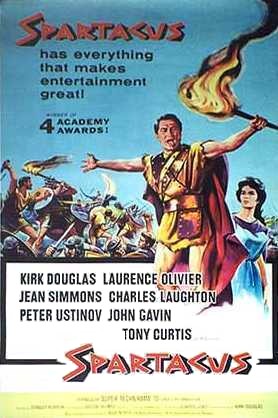 Poster for Spartacus Film has been the most influential medium in the presentation of the history of slavery to the general public around the world.[377] The American film industry has had a complex relationship with slavery and until recent decades often avoided the topic. Films such as The Birth of a Nation (1915)[378] and Gone with the Wind (1939) became controversial because they gave a favourable depiction. In 1940 The Santa Fe Trail gave a liberal but ambiguous interpretation of John Brown's attacks on slavery.[379] Song of the South gave a favorable outlook on slavery in the United States in 1946. The Civil Rights Movement in the 1950s made defiant slaves into heroes.[380] The question of slavery in American memory necessarily involves its depictions in feature films.[381] Most Hollywood films used American settings, although Spartacus (1960), dealt with an actual revolt in the Roman Empire known as the Third Servile War. The revolt failed, and all the rebels were executed, but their spirit lived on according to the film.[382] Spartacus stays surprisingly close to the historical record.[383] The Last Supper (La última cena in Spanish) was a 1976 film directed by Cuban Tomás Gutiérrez Alea about the teaching of Christianity to slaves in Cuba, and emphasizes the role of ritual and revolt. Burn! takes place on the imaginary Portuguese island of Queimada (where the locals speak Spanish) and it merges historical events that took place in Brazil, Cuba, Santo Domingo, Jamaica, and elsewhere. Historians agree that films have largely shaped historical memories, but they debate issues of accuracy, plausibility, moralism, sensationalism, how facts are stretched in search of broader truths, and suitability for the classroom.[384][382] Berlin argues that critics complain if the treatment emphasizes historical brutality, or if it glosses over the harshness to highlight the emotional impact of slavery.[385] |
メディア さらに詳しい情報 奴隷制度が登場する映画のリスト  『スパルタカス』のポスター 映画は、奴隷制の歴史を世界中の一般大衆に紹介する上で最も影響力のあるメディアである[377]。アメリカの映画産業は奴隷制と複雑な関係を持ってお り、ここ数十年まではその話題を避けることが多かった。国家の誕生』(1915年)[378]や『風と共に去りぬ』(1939年)といった映画は、好意的 な描写をしたために物議を醸した。1940年の『サンタフェ・トレイル』では、ジョン・ブラウンの奴隷制に対する攻撃について、リベラルだが曖昧な解釈を 与えている[379]。1946年の『南部の歌』では、アメリカにおける奴隷制について好意的な見通しを与えている。 1950年代の公民権運動は、反抗的な奴隷を英雄にした[380]。アメリカの記憶における奴隷制の問題は、必然的に長編映画における描写を含む[381]。 ほとんどのハリウッド映画はアメリカの設定を使用していたが、『スパルタカス』(1960年)は第三次奴隷戦争として知られるローマ帝国の実際の反乱を扱っていた。反乱は失敗し、反乱軍は全員処刑されたが、彼らの精神は映画によれば生き続けた[382]。 最後の晩餐』(スペイン語でLa última cena)は、キューバのトマス・グティエレス・アレア監督による1976年の映画で、キューバにおける奴隷へのキリスト教の教えを描いており、儀式と反 乱の役割を強調している。燃えよ!』の舞台は架空のポルトガル領ケイマダ島(現地の人々はスペイン語を話す)で、ブラジル、キューバ、サントドミンゴ、 ジャマイカなどで起こった歴史的事件が融合している。 歴史家たちは、映画が歴史的記憶を形成してきたことに同意するが、正確さ、妥当性、モラリズム、センセーショナリズム、より広範な真実を求めて事実がどの ように引き伸ばされるか、授業への適合性などの問題について議論している[384][382]。ベルリンによれば、批評家たちは、その扱いが歴史的残虐性 を強調したり、奴隷制の感情的な影響を強調するために過酷さをごまかしたりすると不満を漏らすと主張する[385]。 |
| Bodmin manumissions, the names and details of slaves freed in Medieval Bodmin Christian Ritual and the Creation of British Slave Societies, 1650-1780 International Day for the Abolition of Slavery International Slavery Museum Involuntary servitude List of slaves List of slave owners Mukataba Slave rebellion Supplementary Convention on the Abolition of Slavery Wilberforce Institute for the Study of Slavery and Emancipation |
ボドミン・マニュミッション、中世ボドミンで解放された奴隷の名前と詳細 キリスト教儀礼とイギリス奴隷社会の創設、1650-1780年 奴隷制廃止国際デー 国際奴隷博物館 強制労働 奴隷のリスト 奴隷所有者リスト ムカタバ 奴隷の反乱 奴隷制廃止補足条約 ウィルバーフォース奴隷解放研究所 |
| https://en.wikipedia.org/wiki/Slavery |
リ ンク
文 献
そ の他の情報
Copyleft, CC, Mitzub'ixi Quq Chi'j, 1996-2099
☆
 ☆
☆